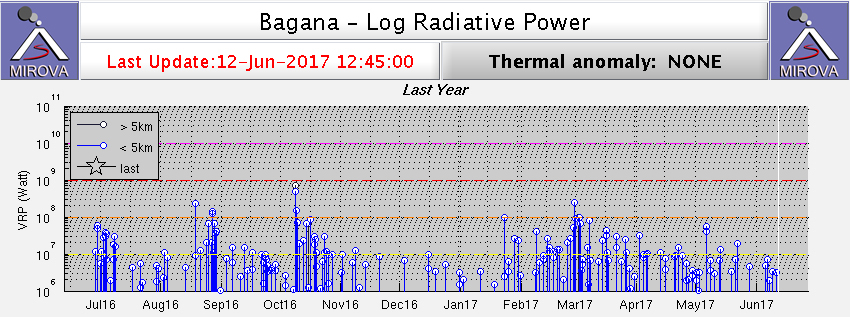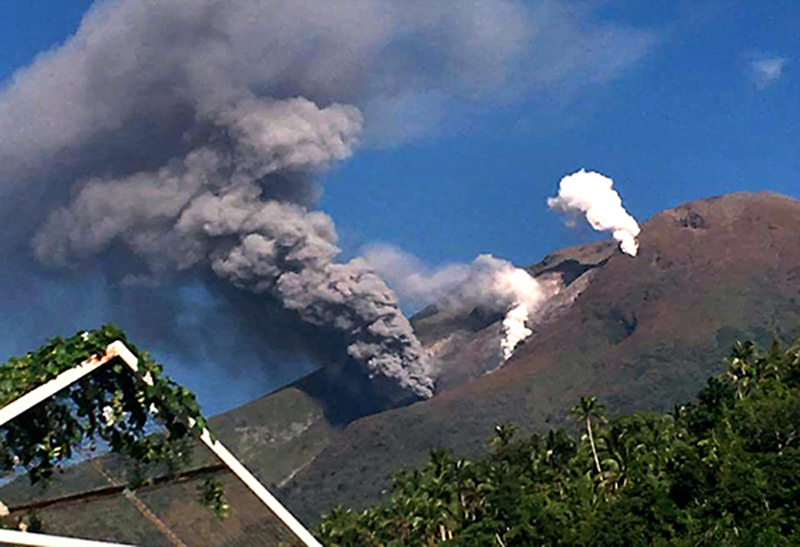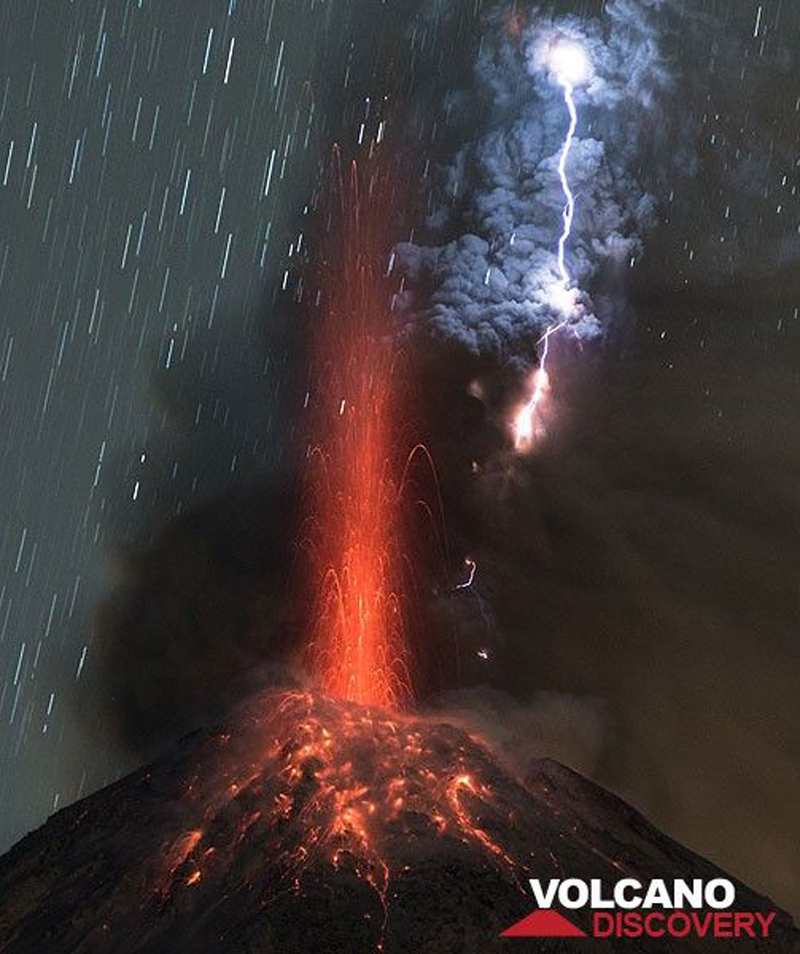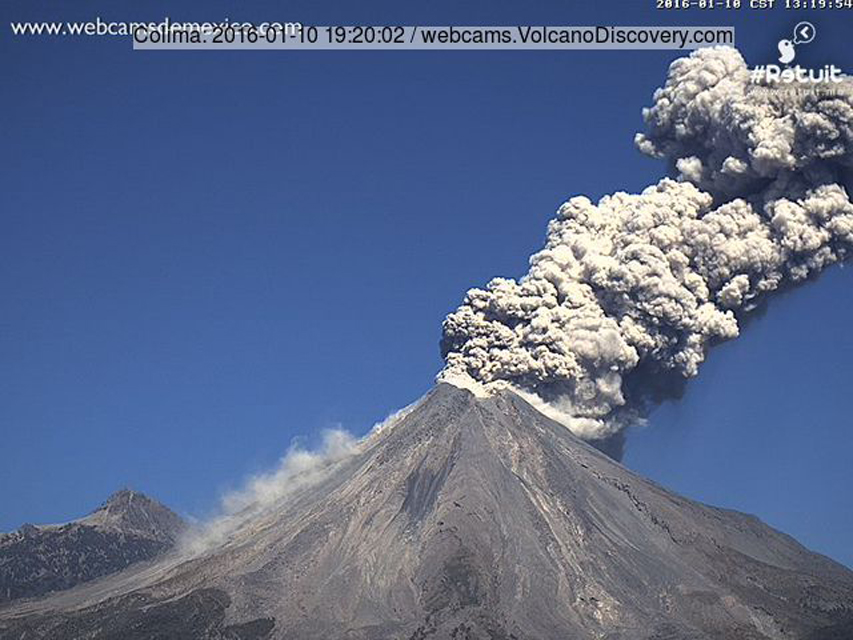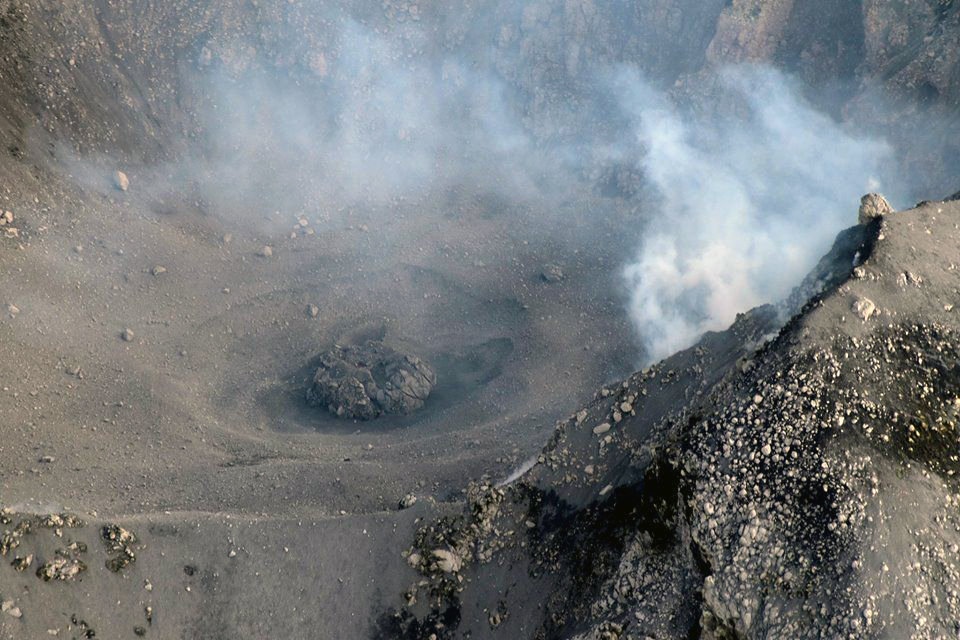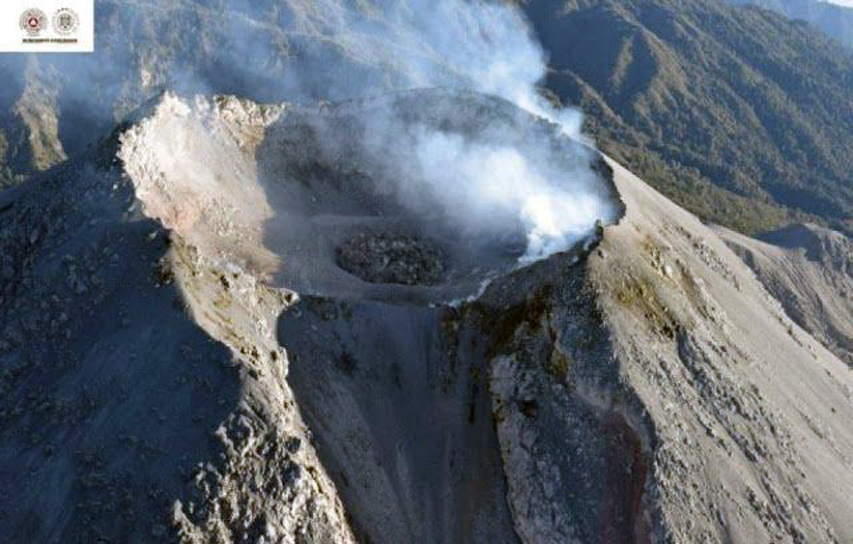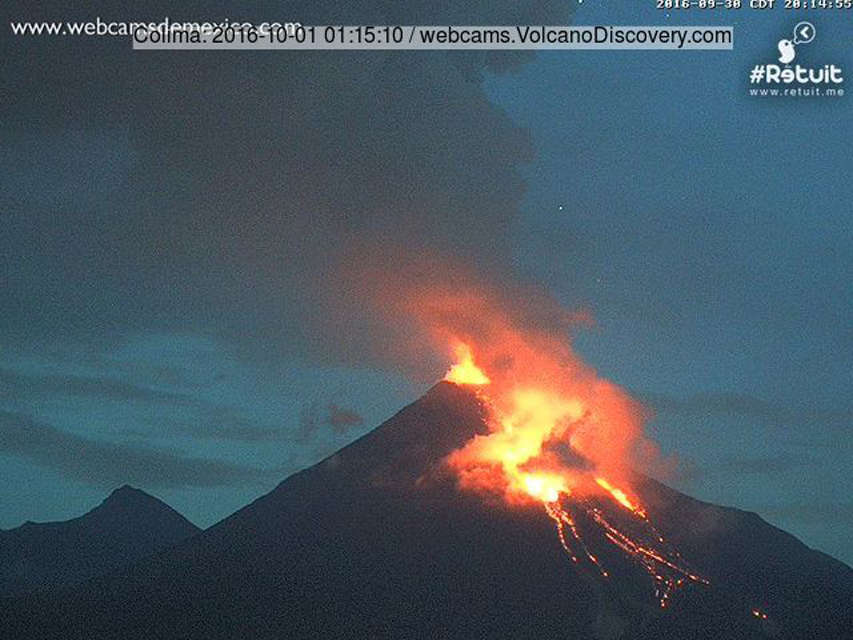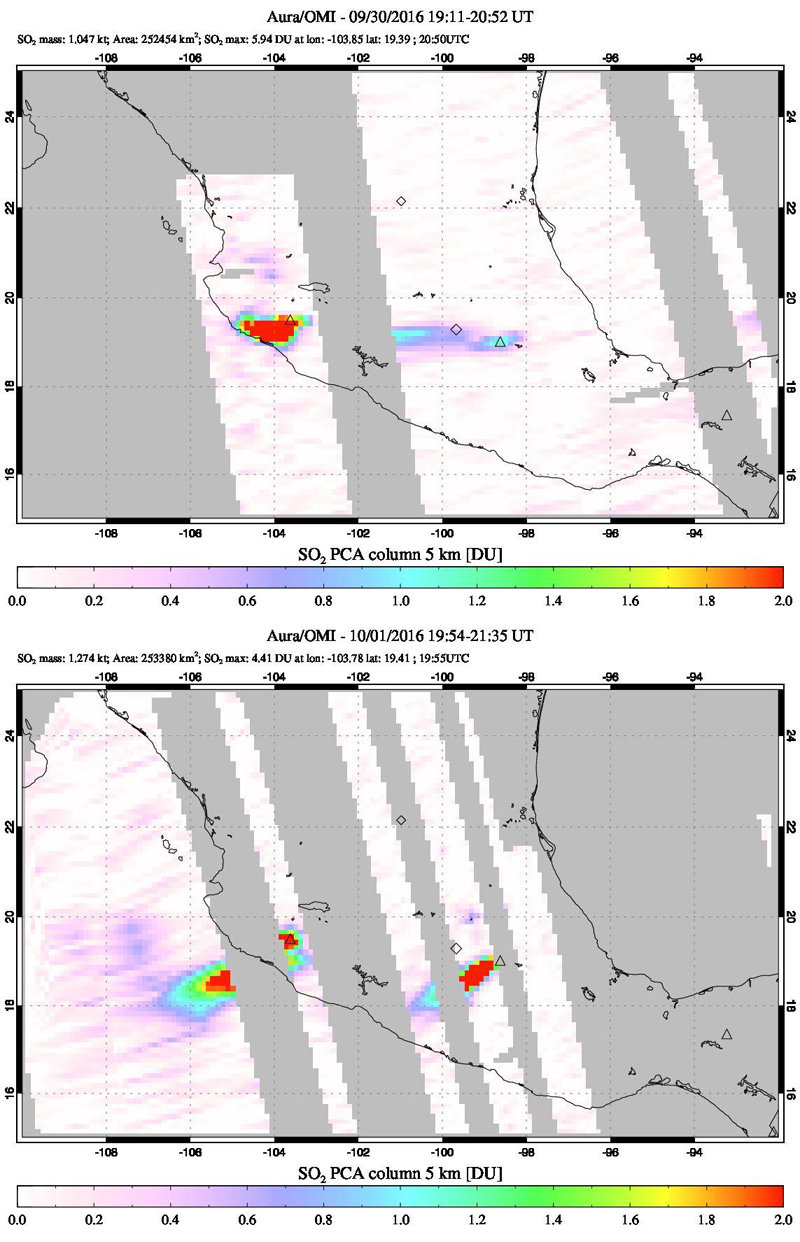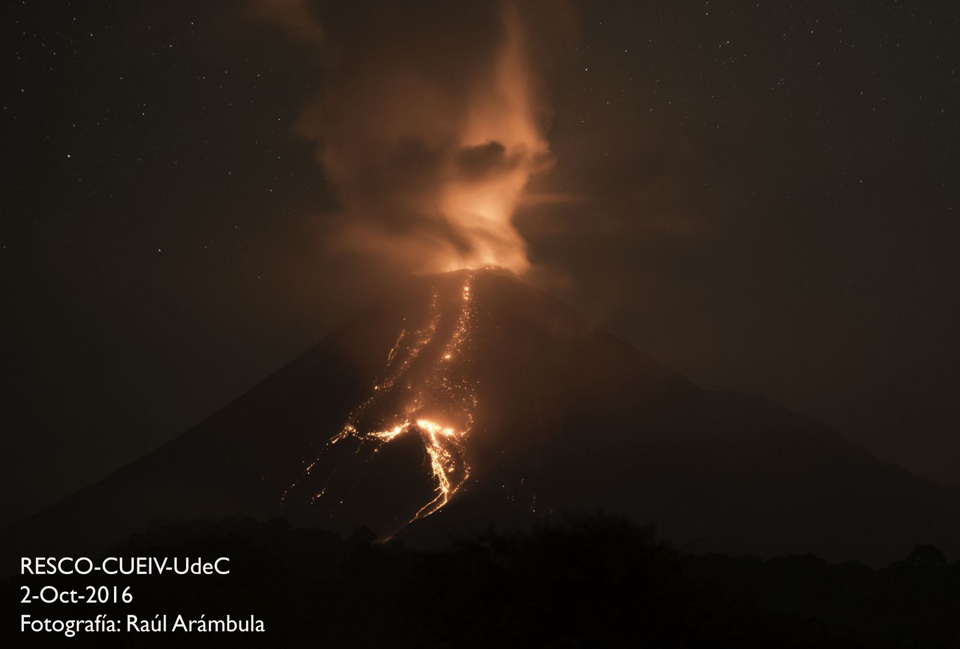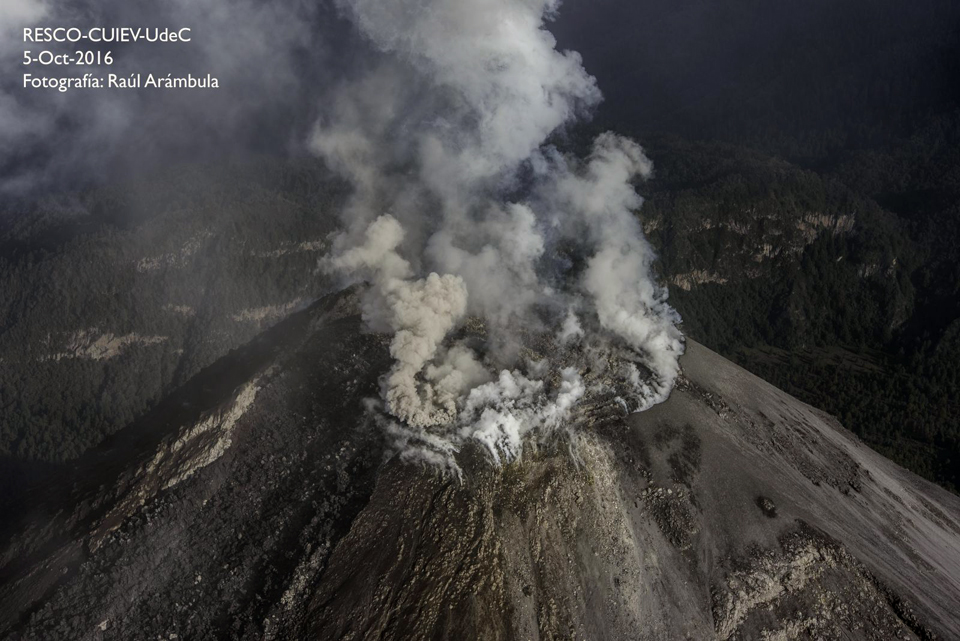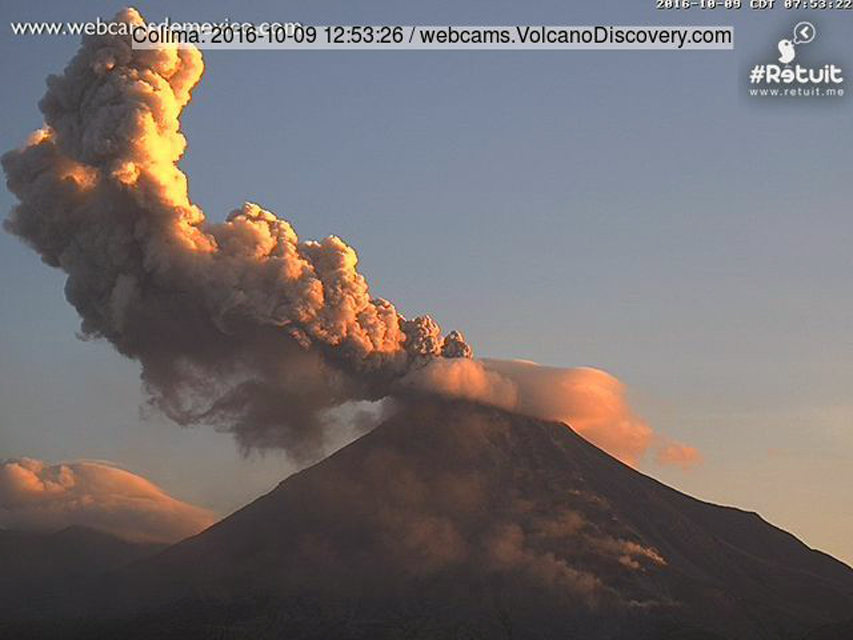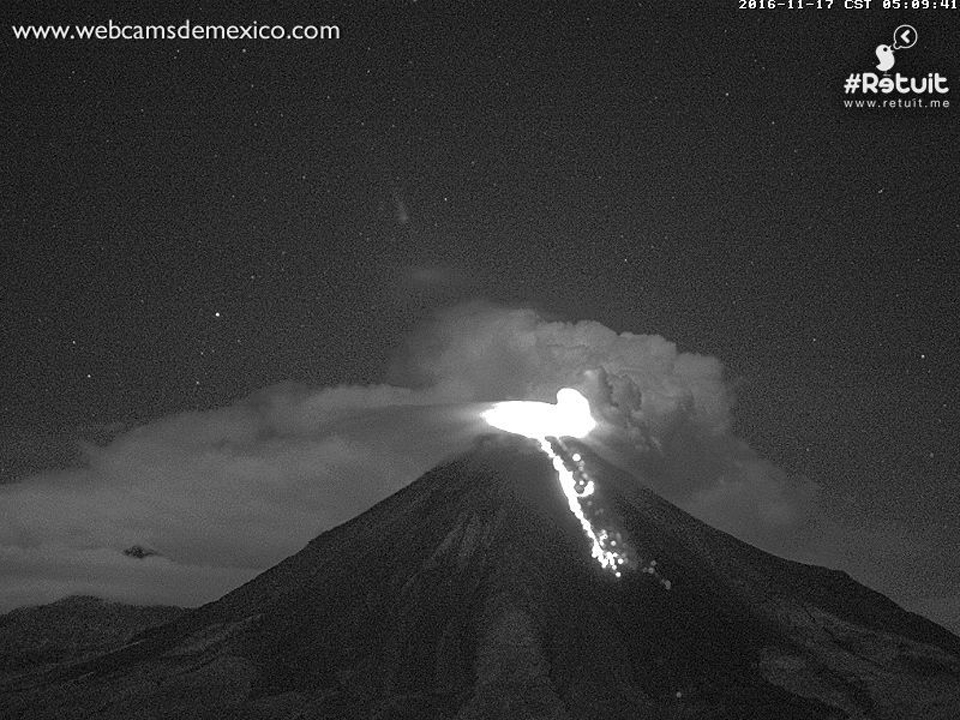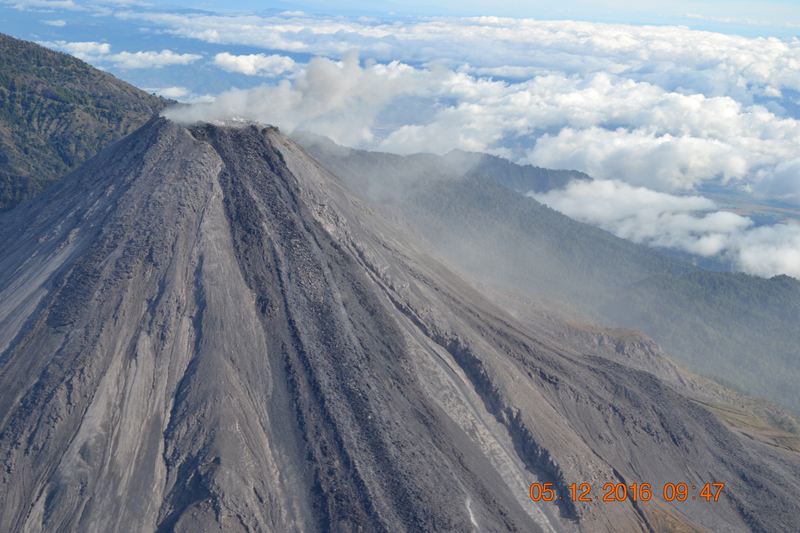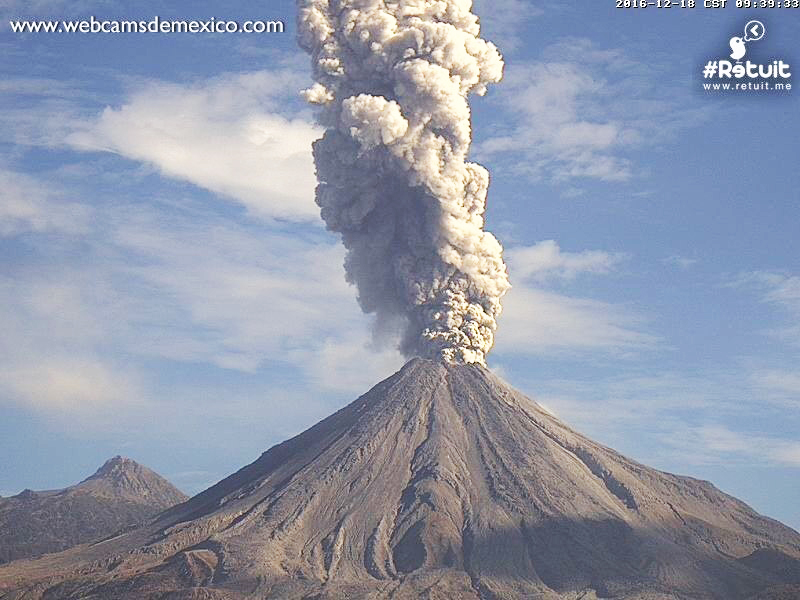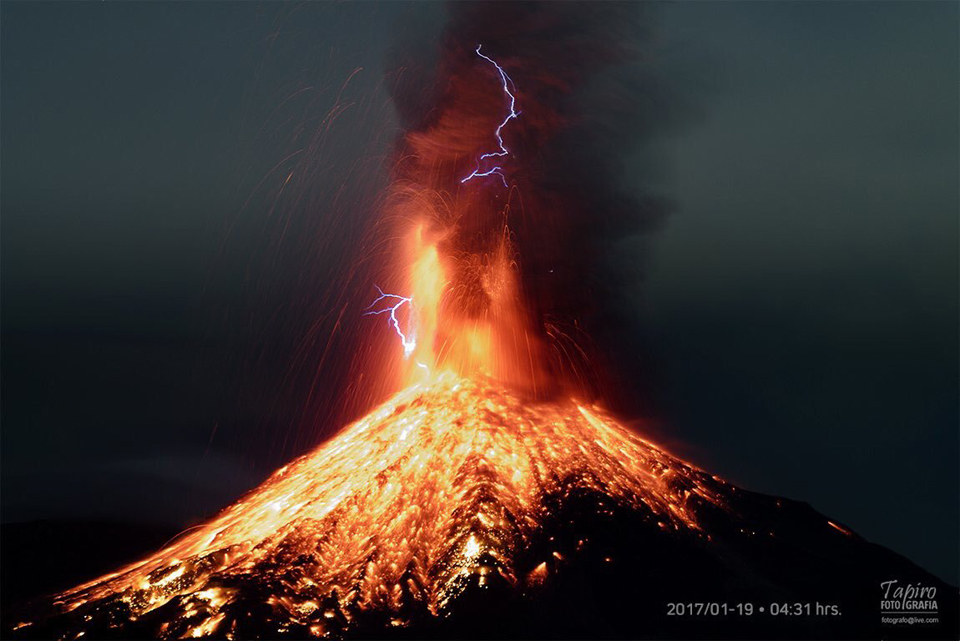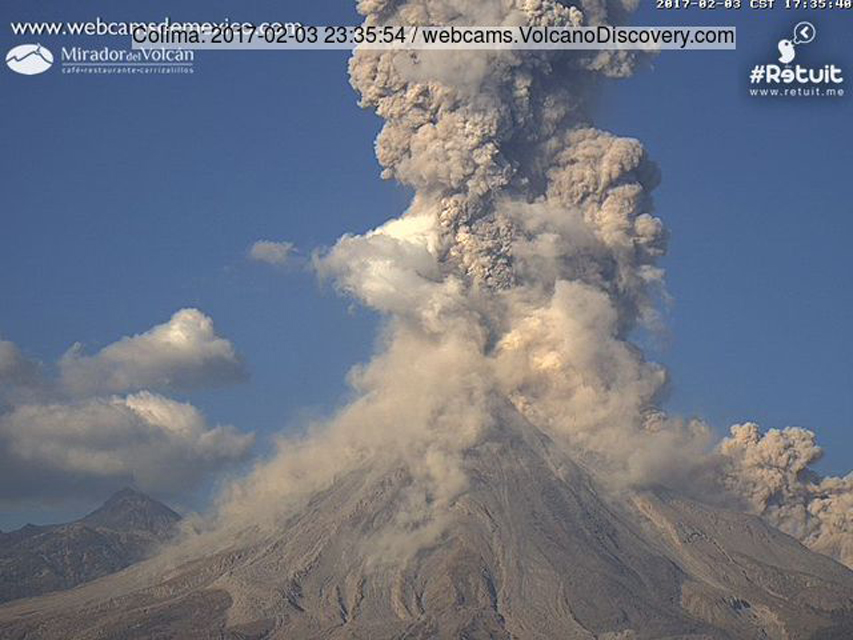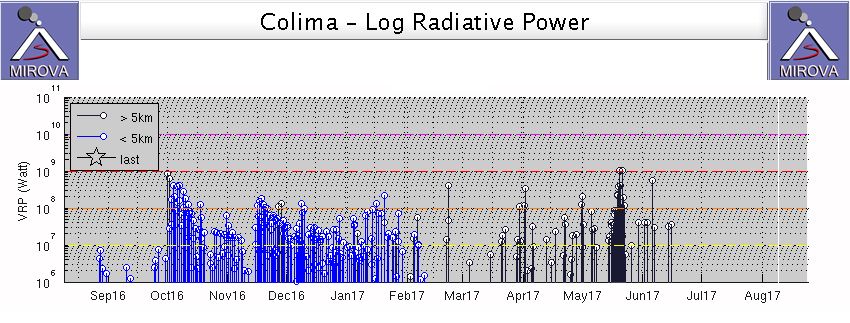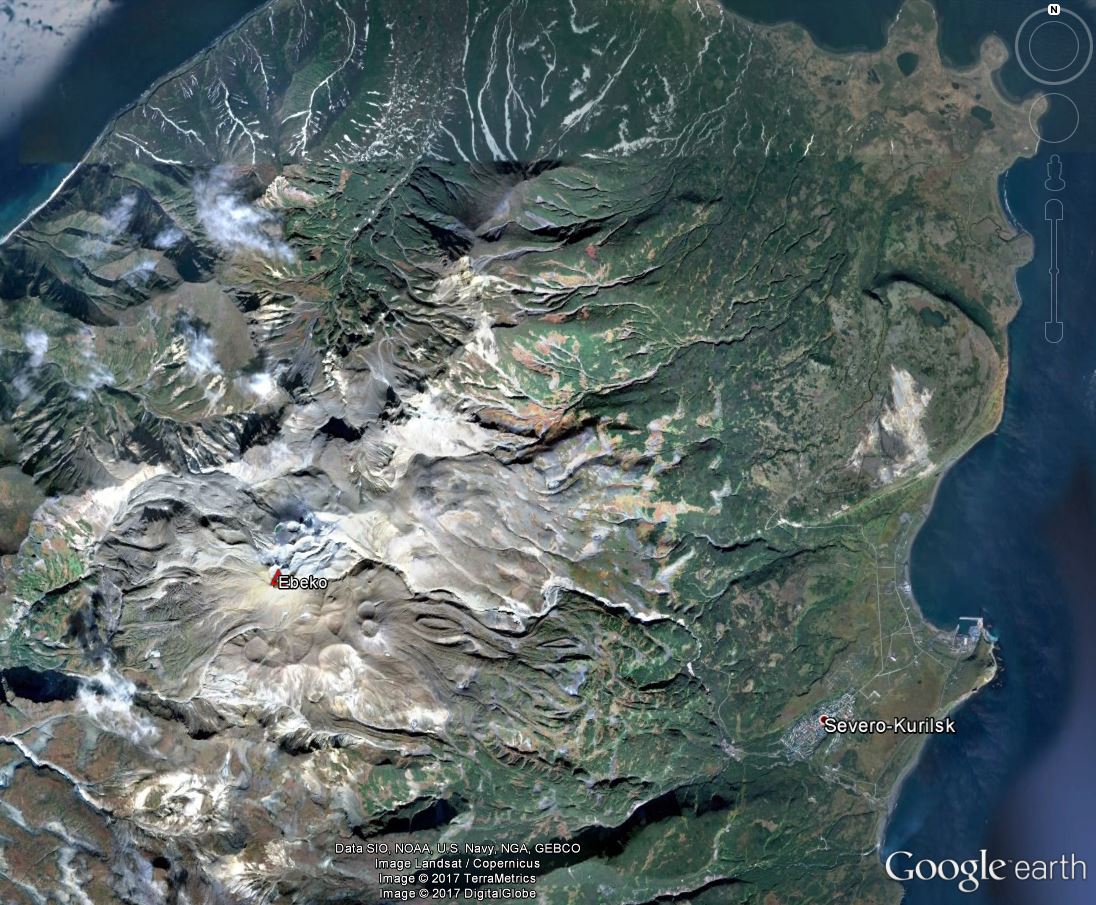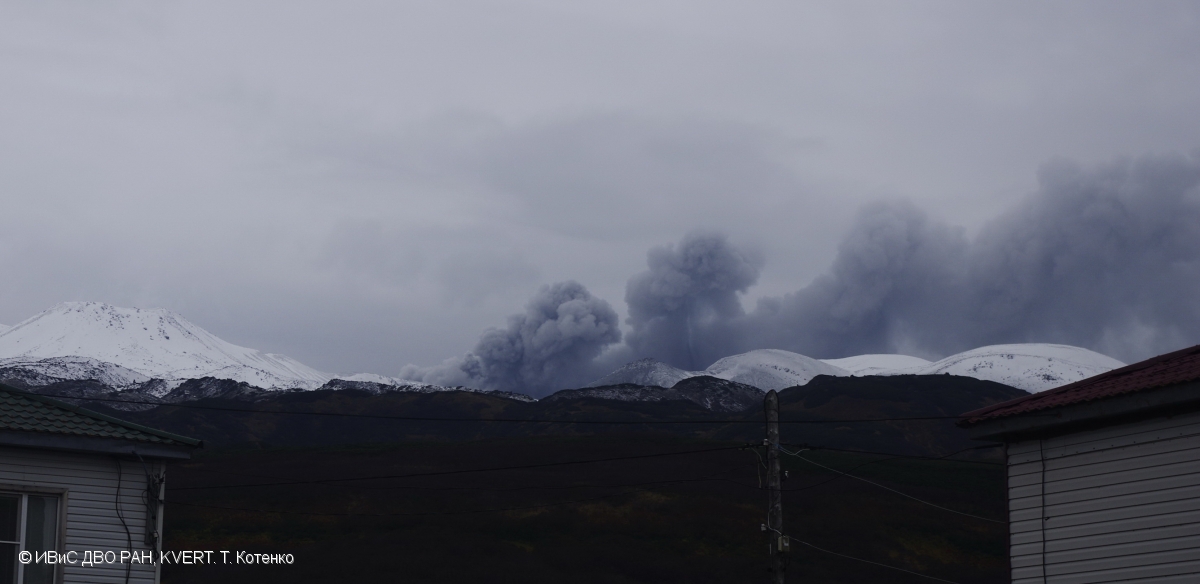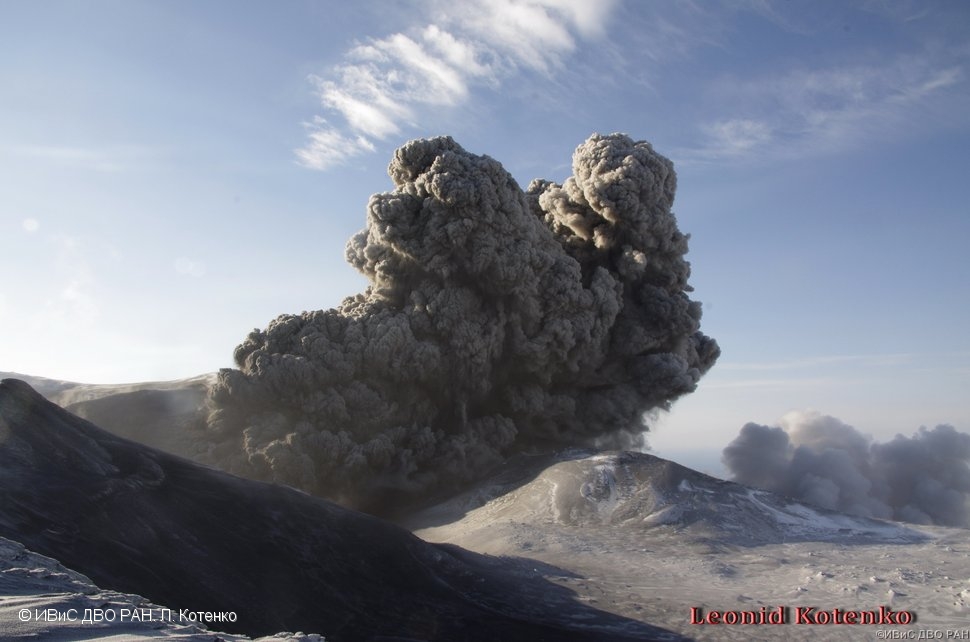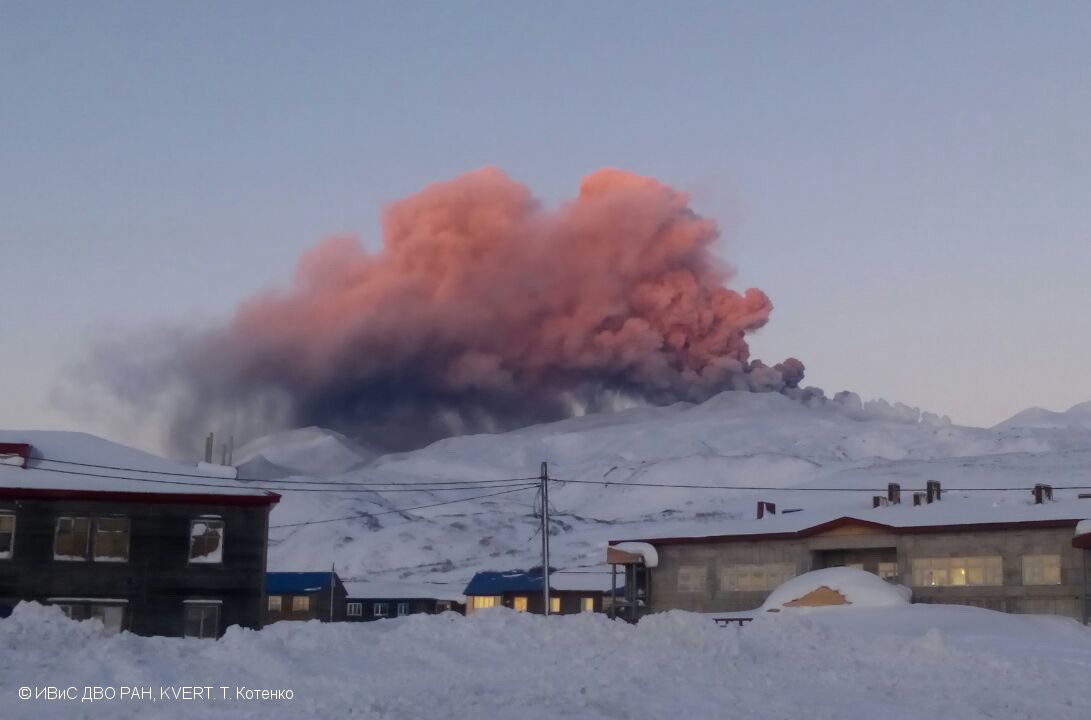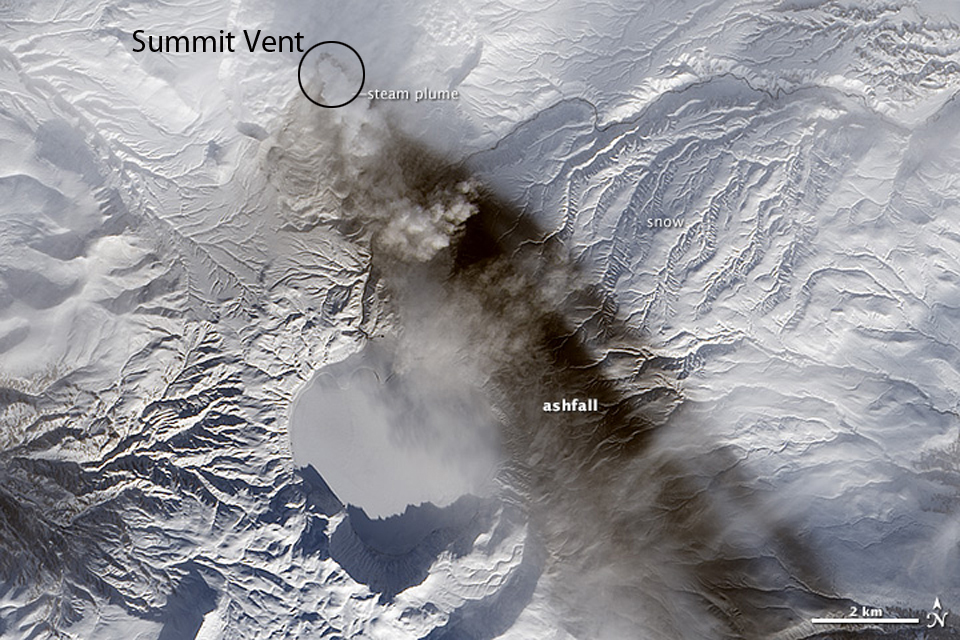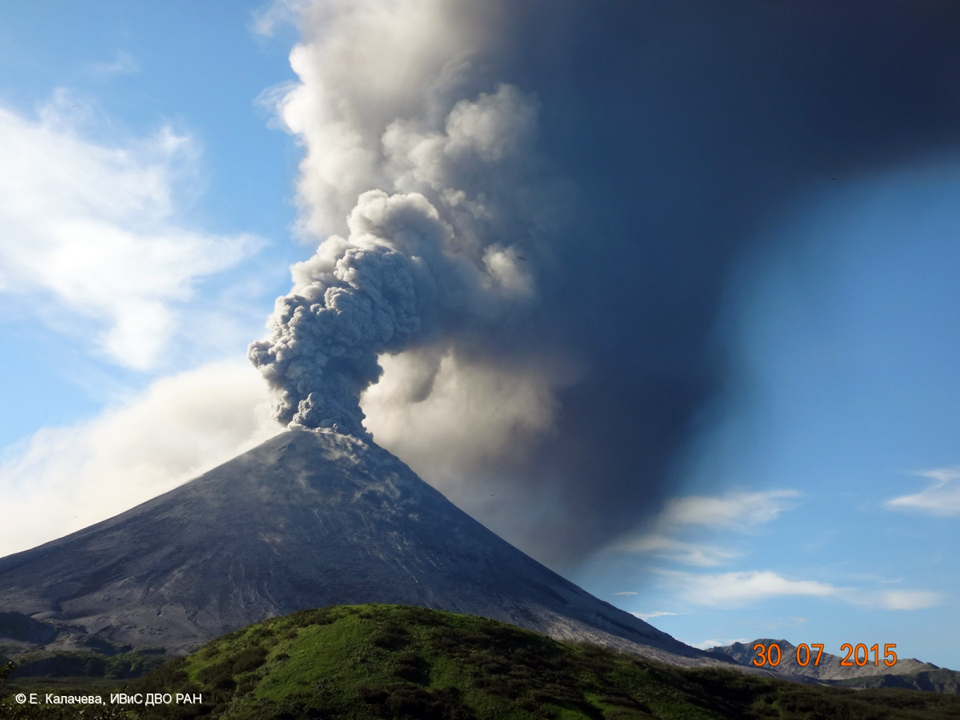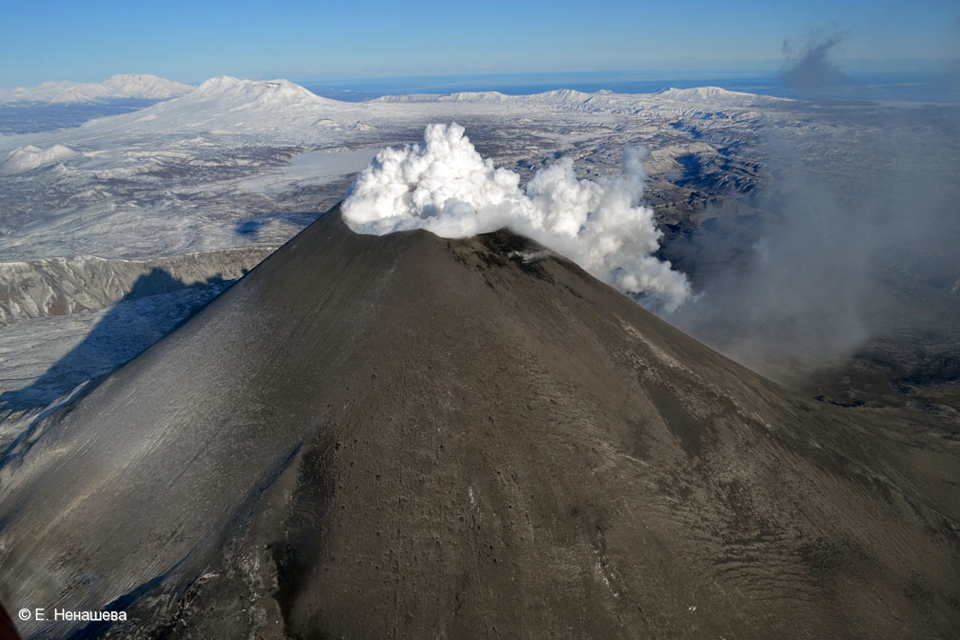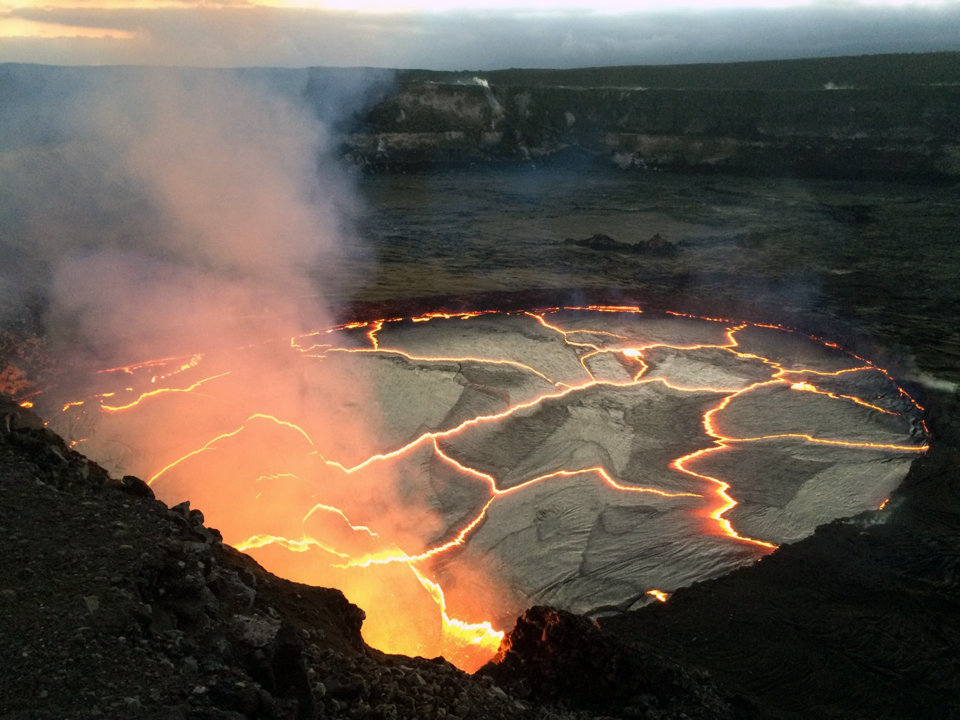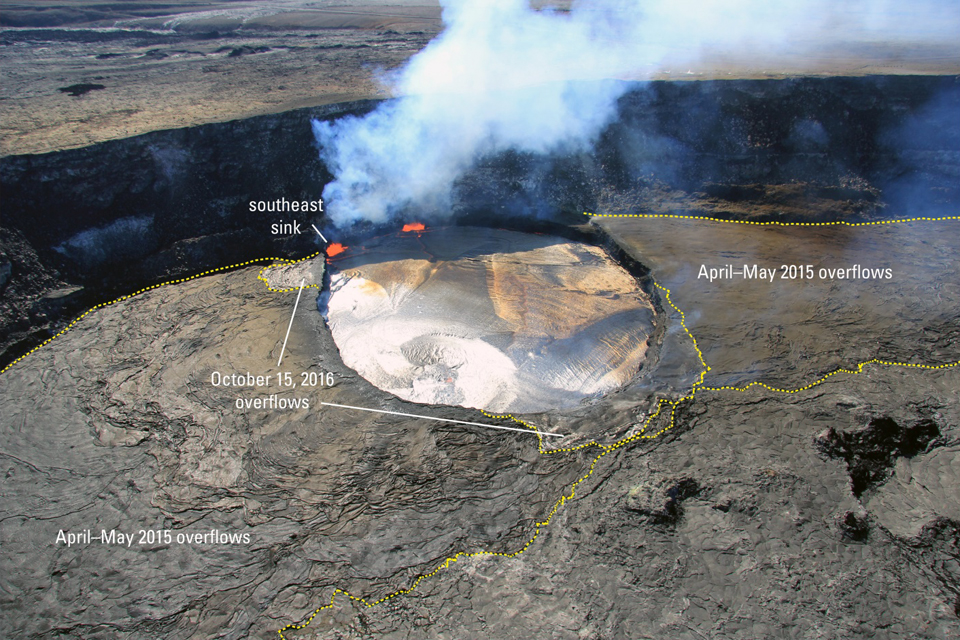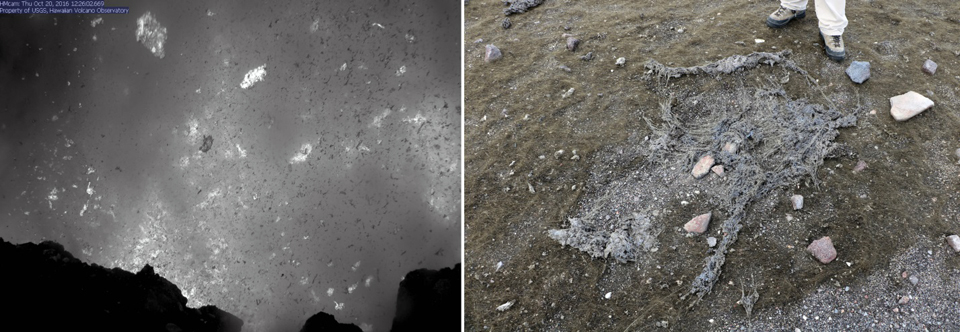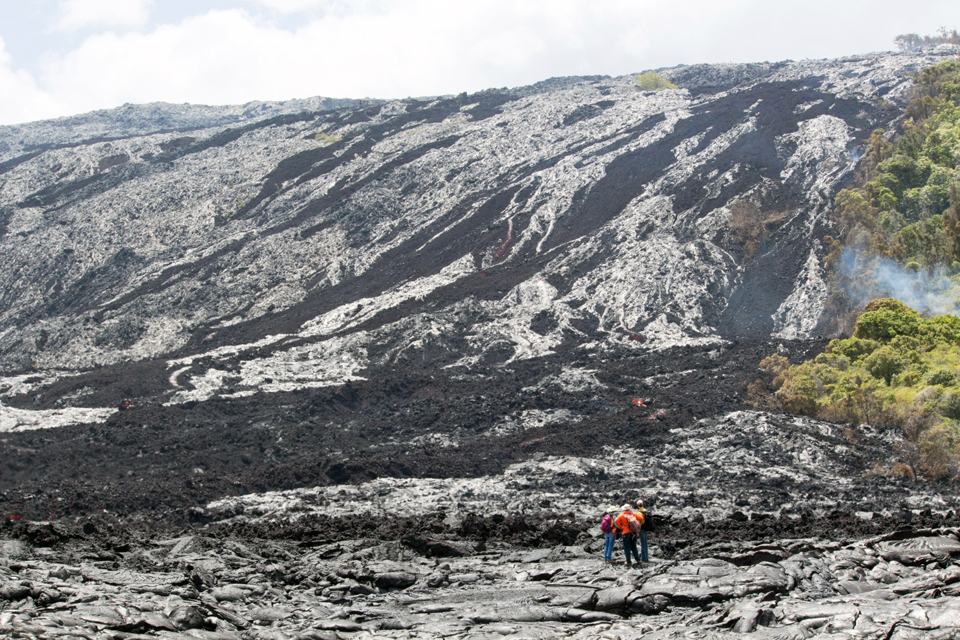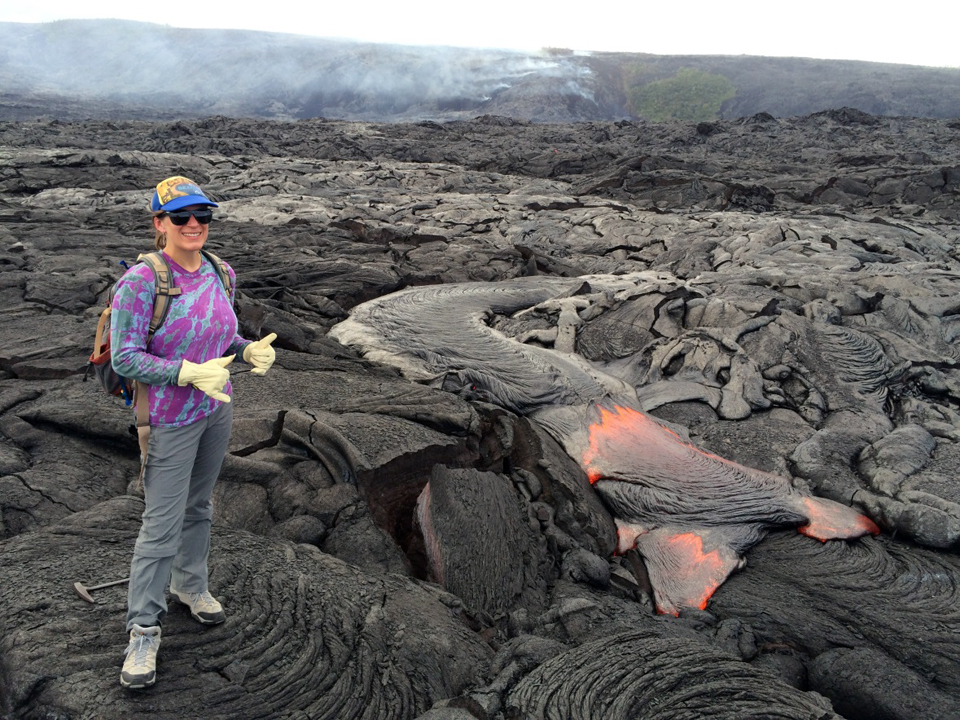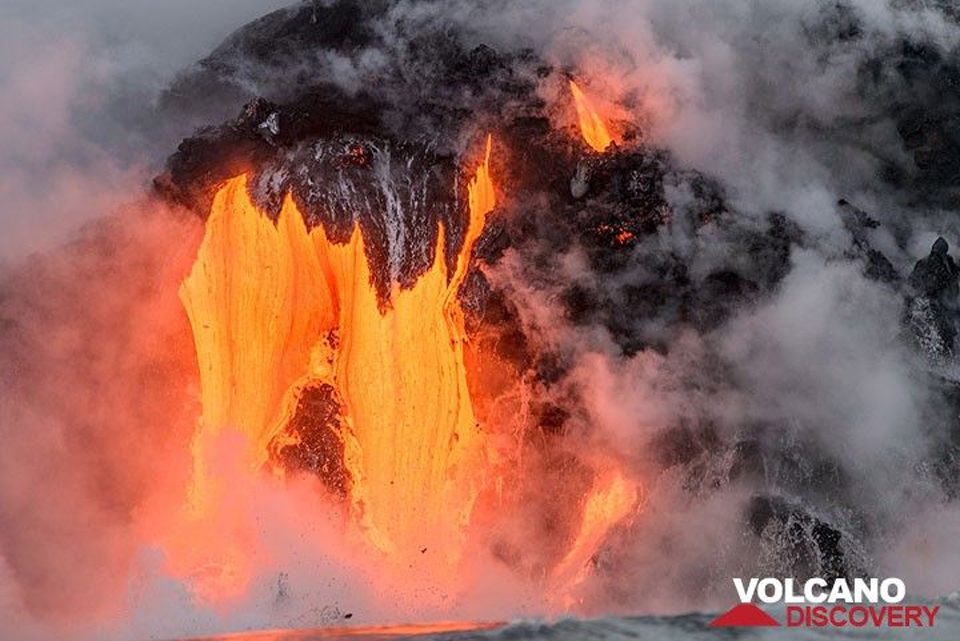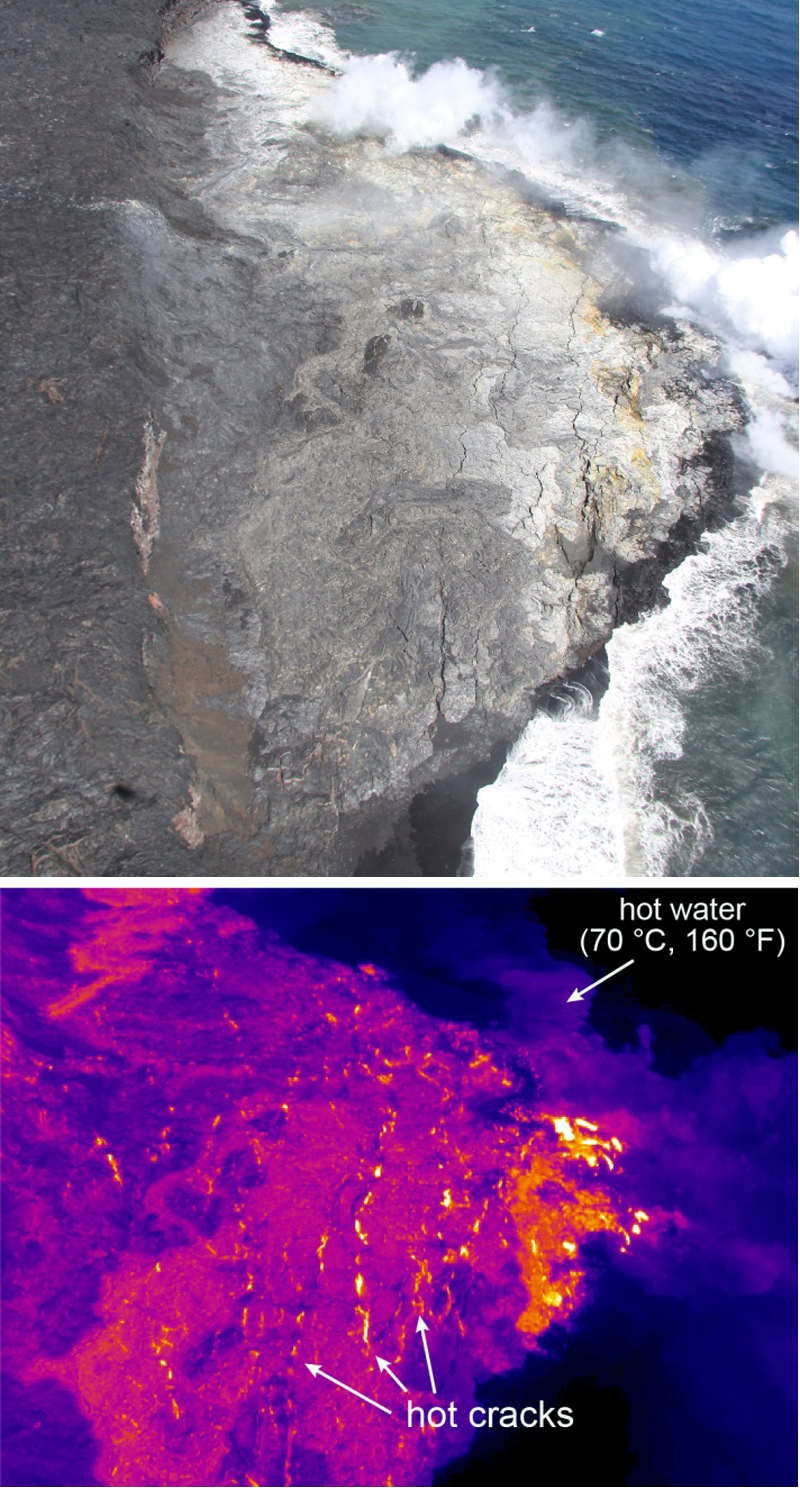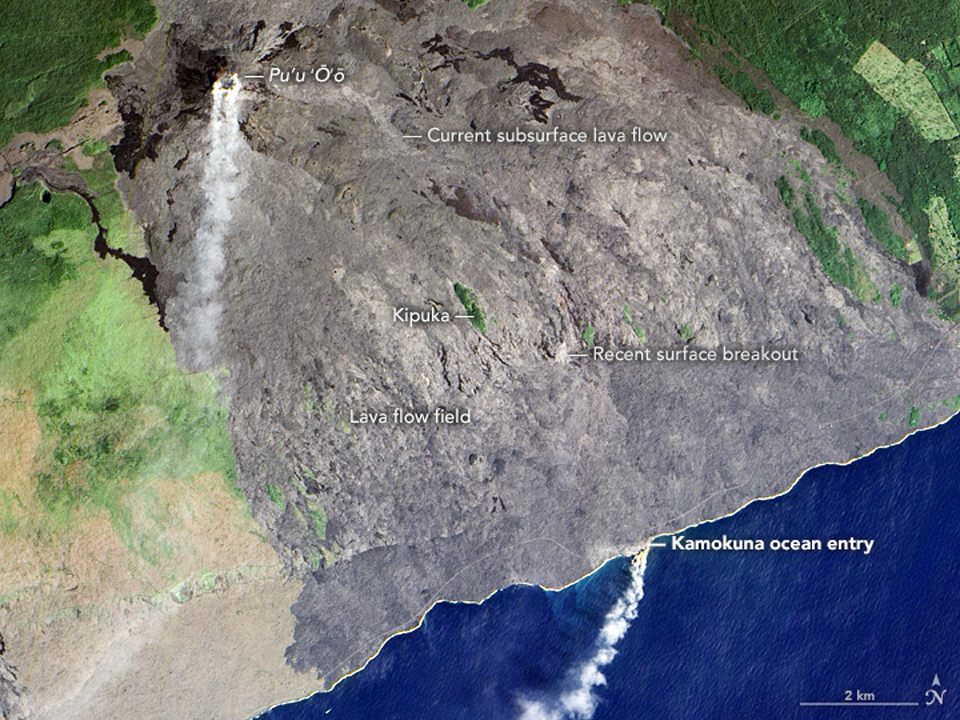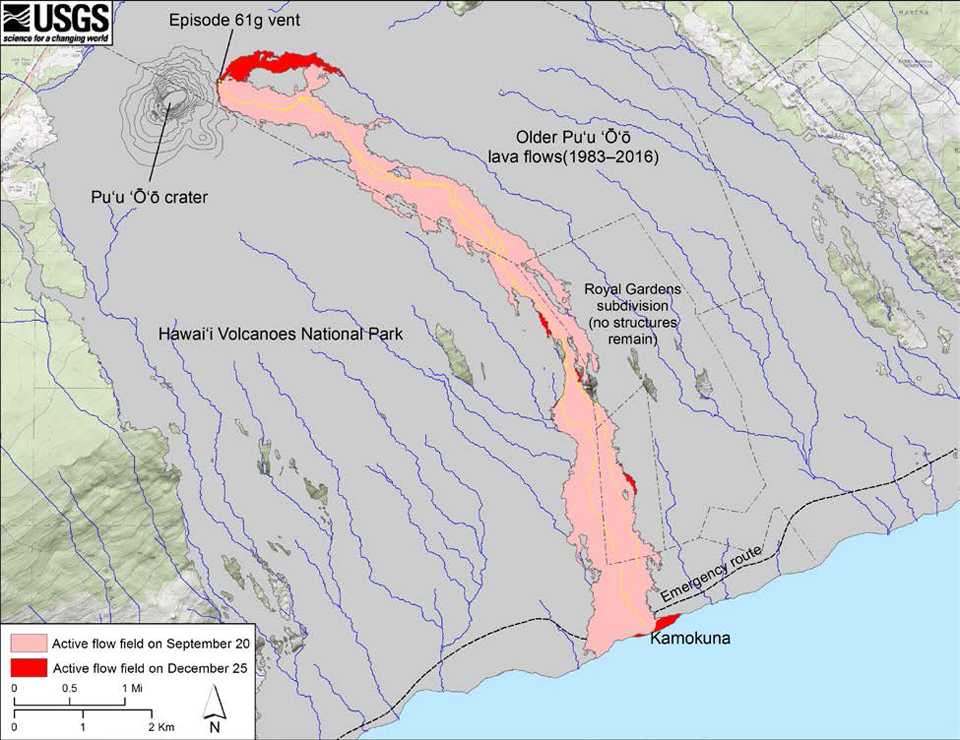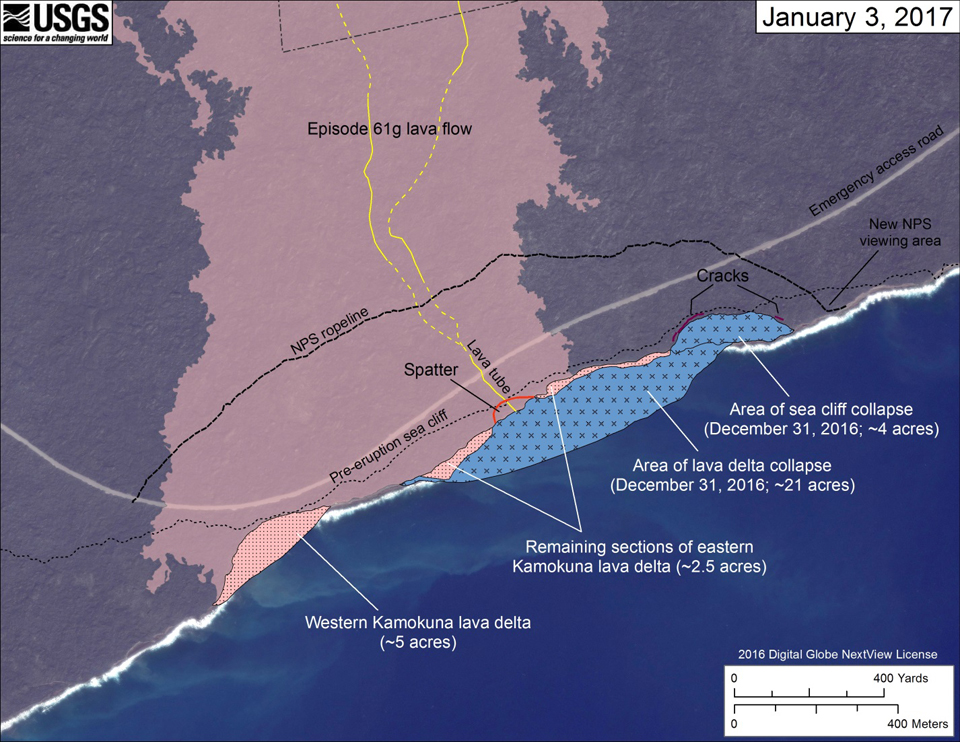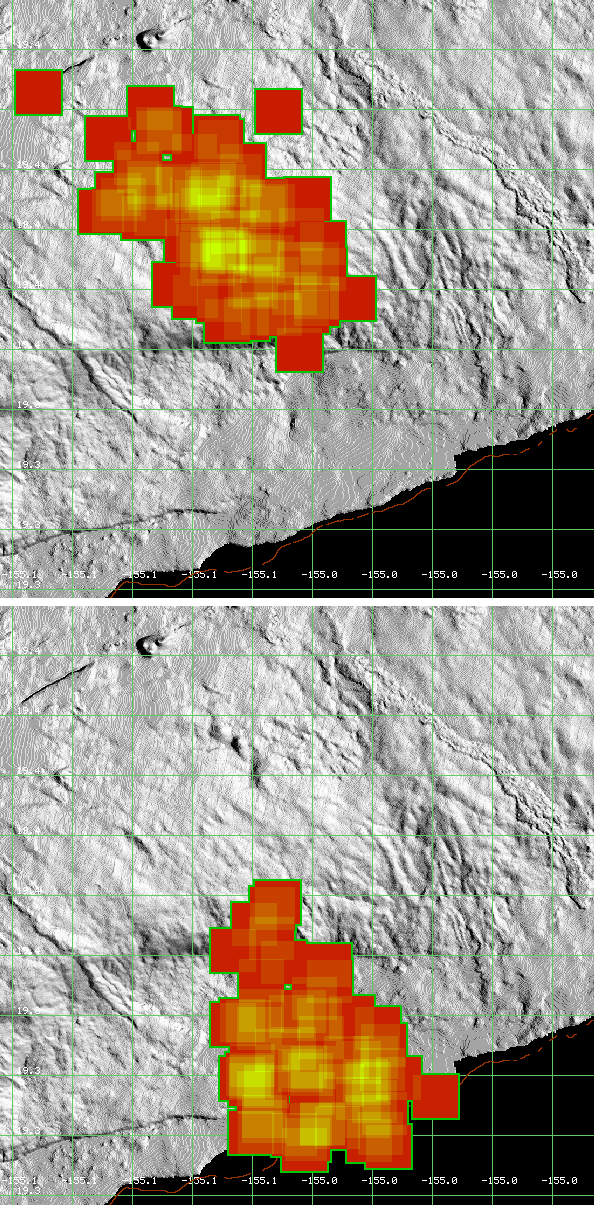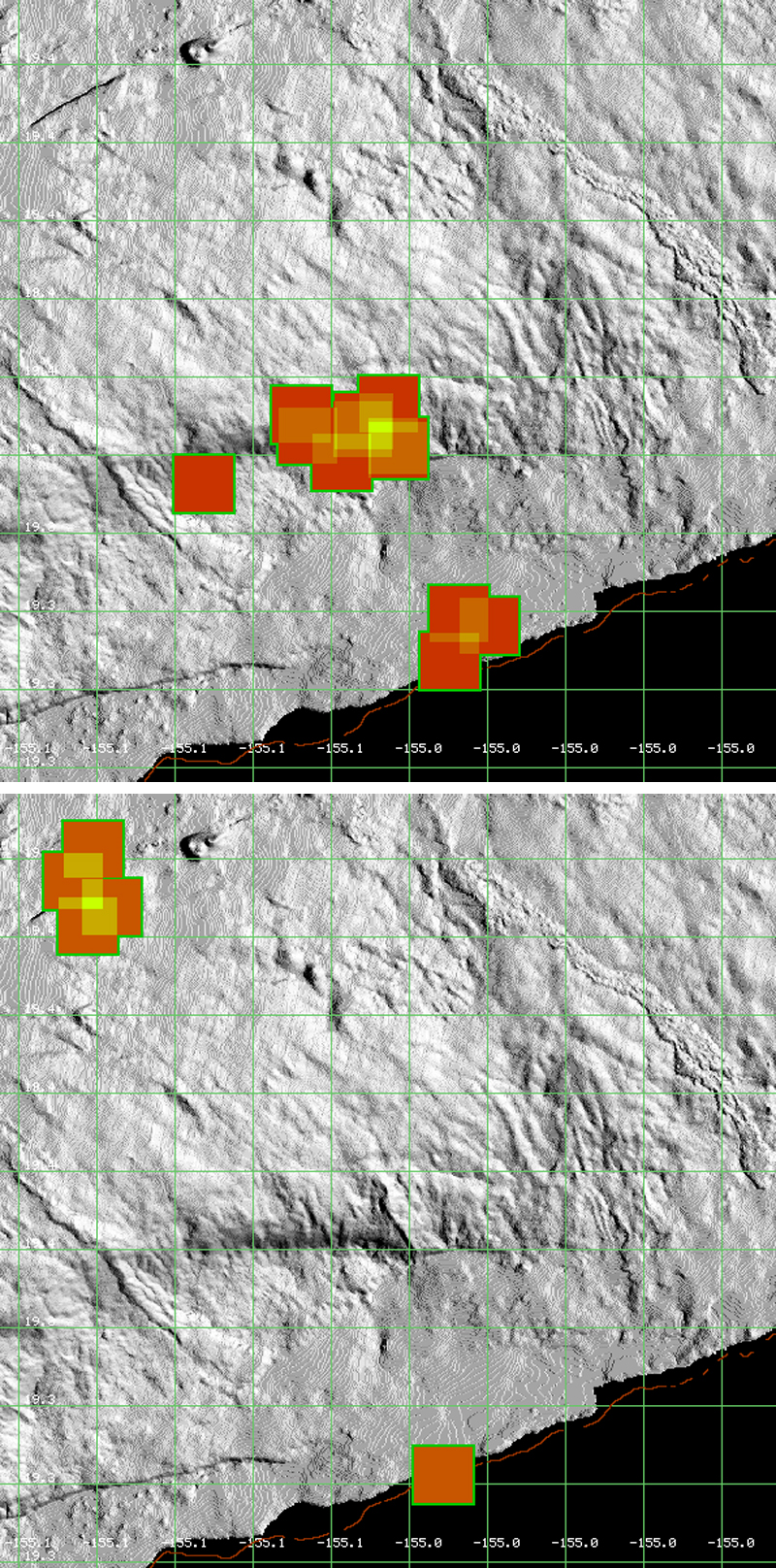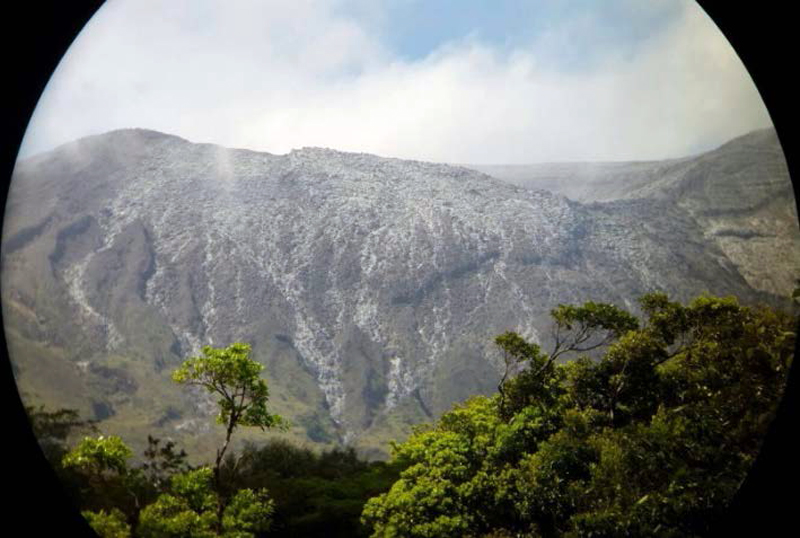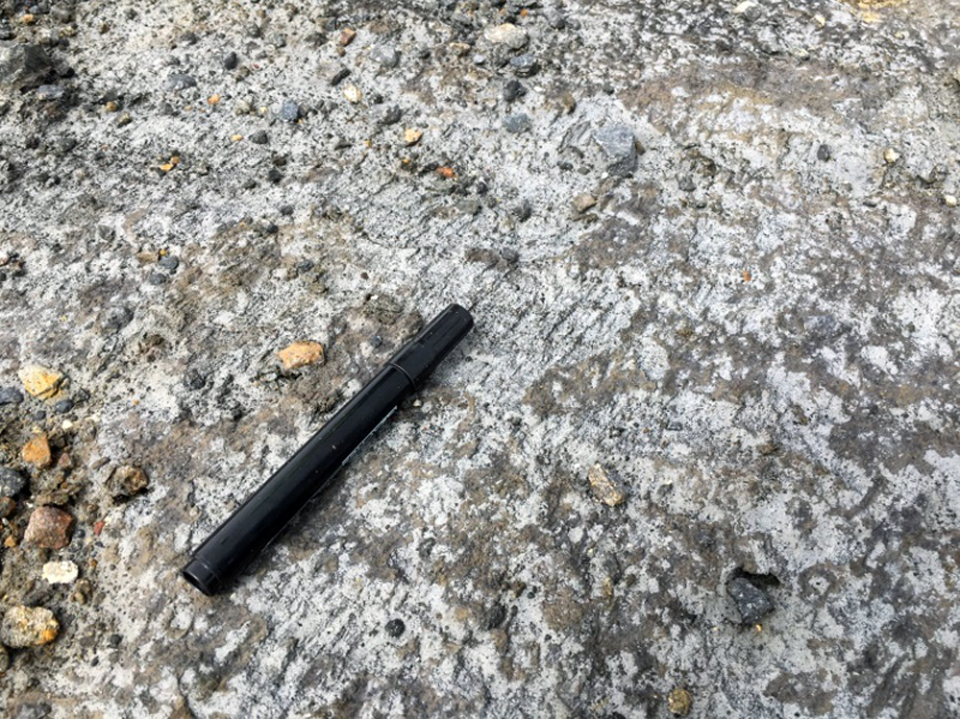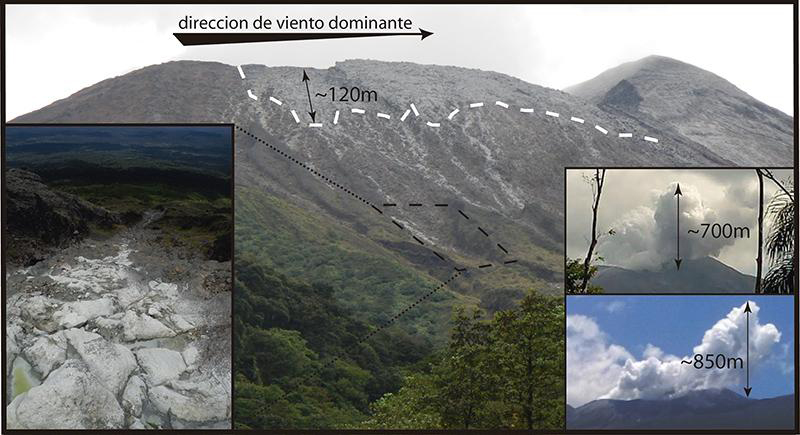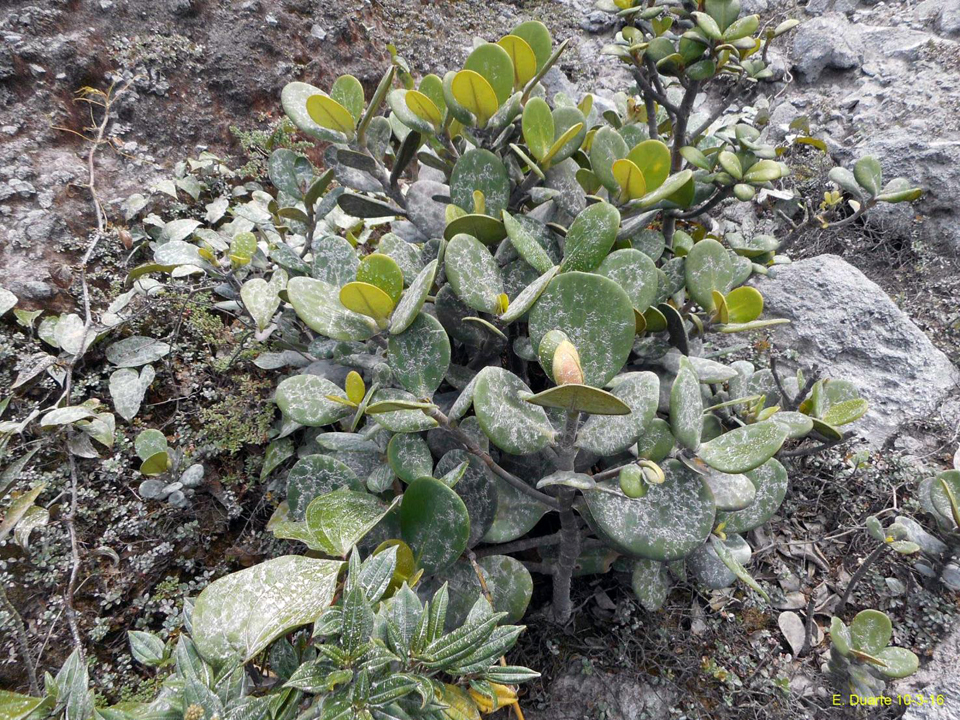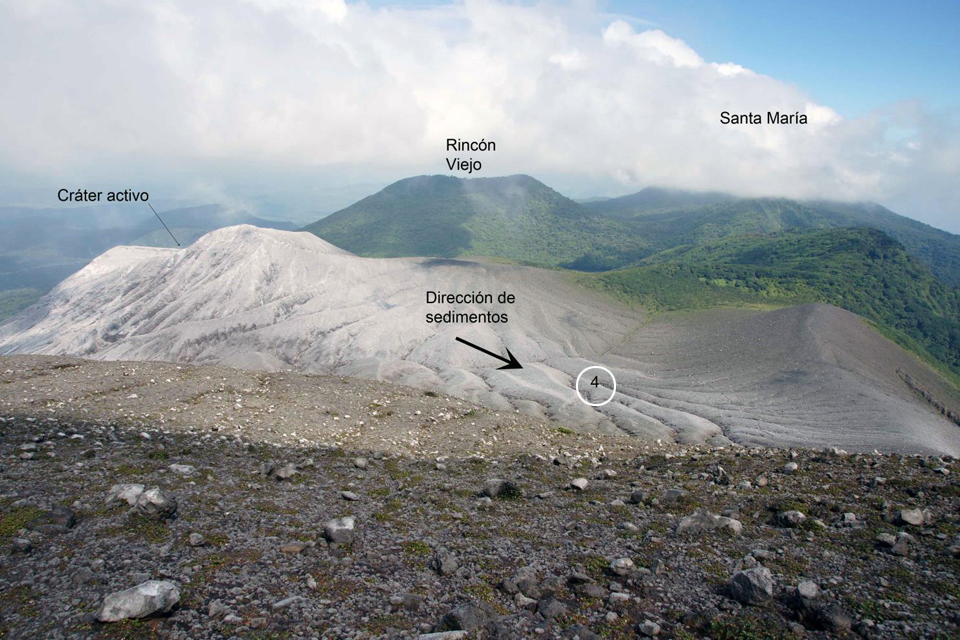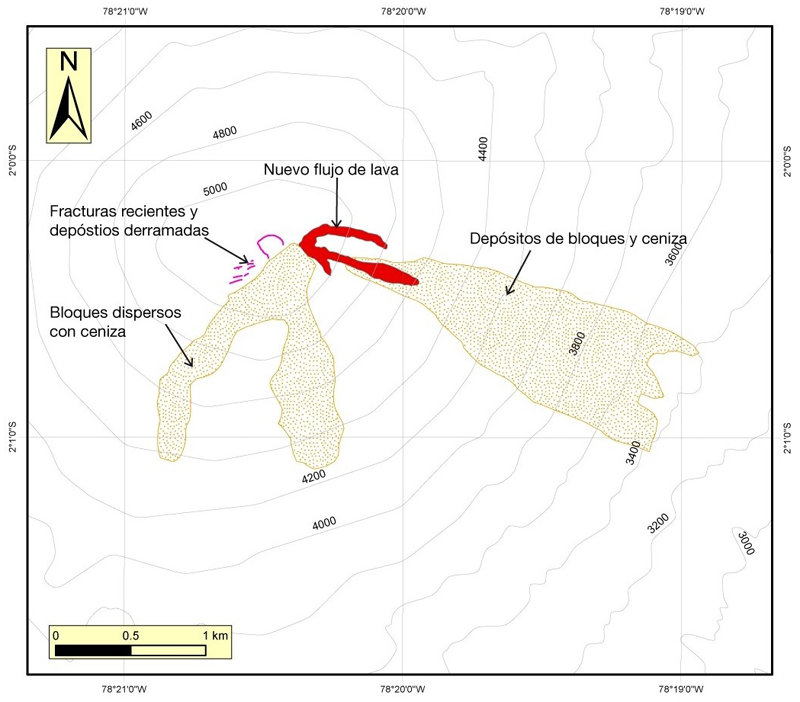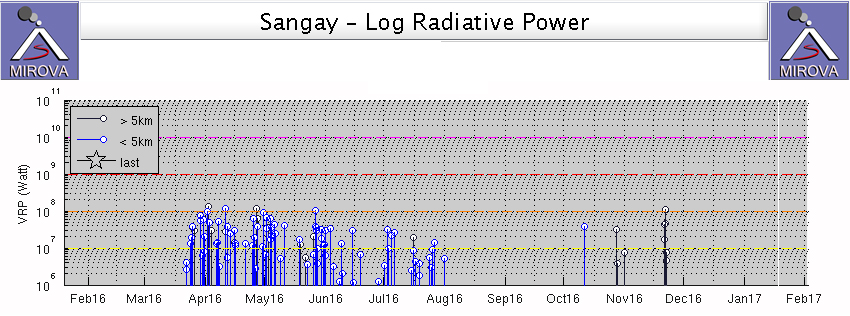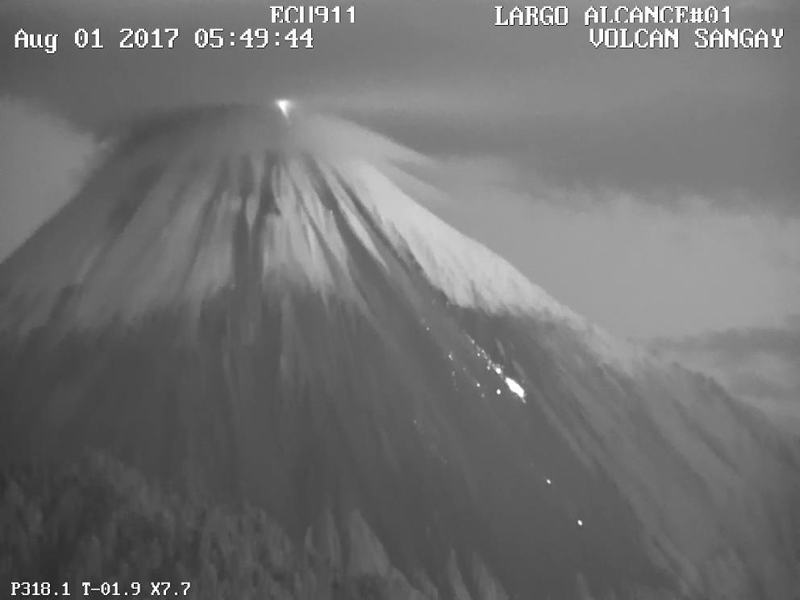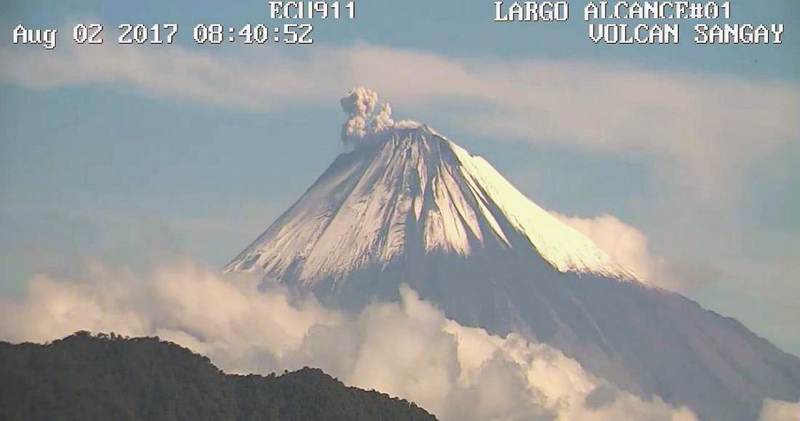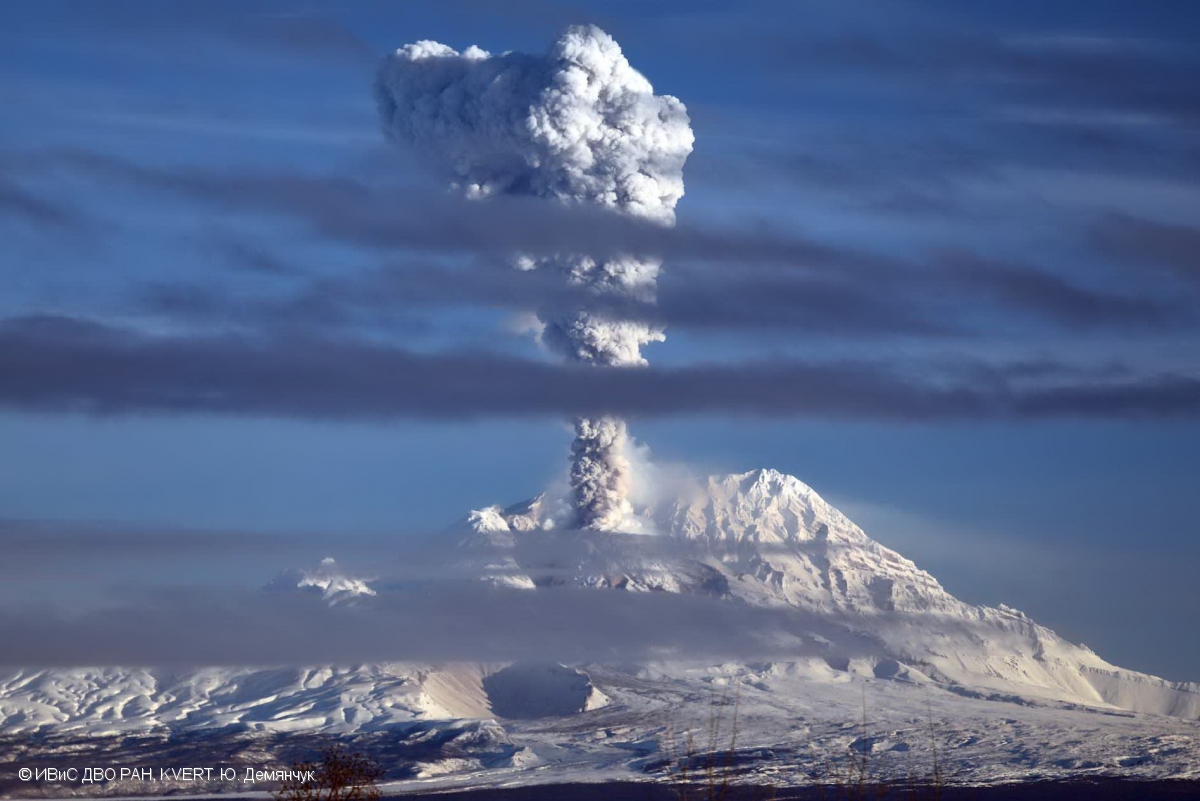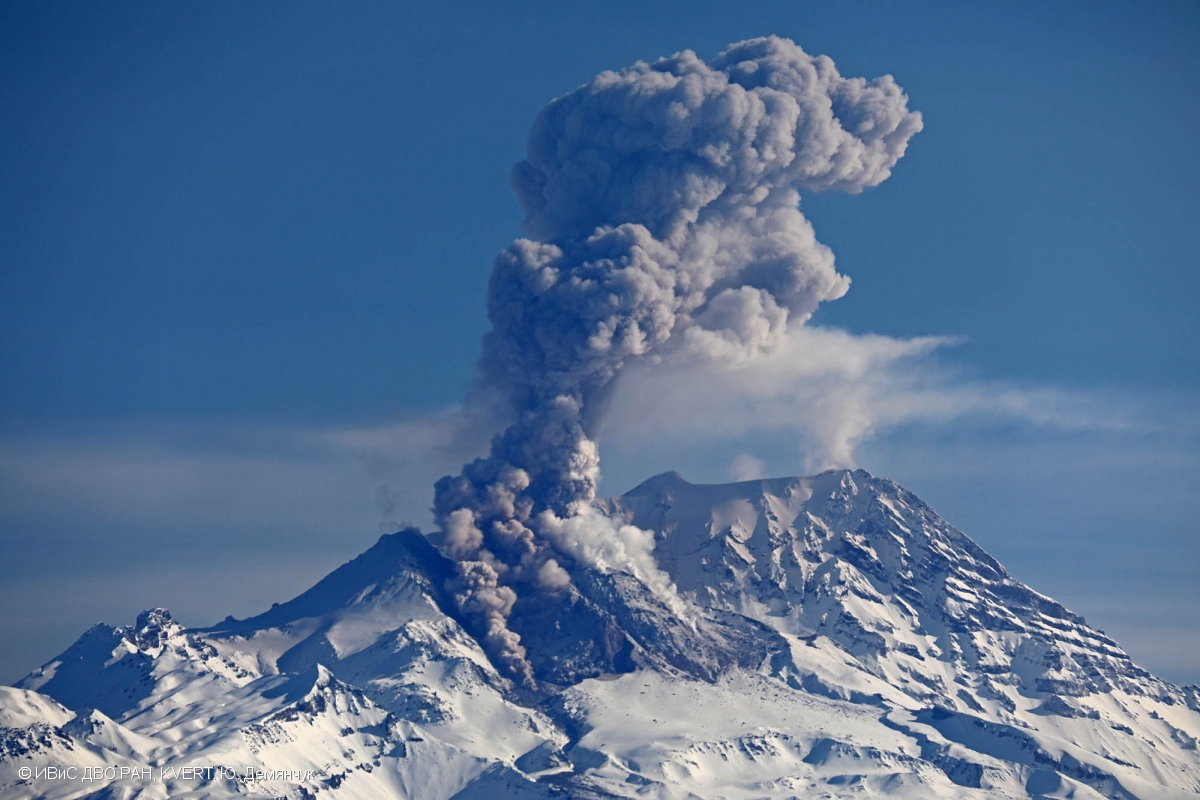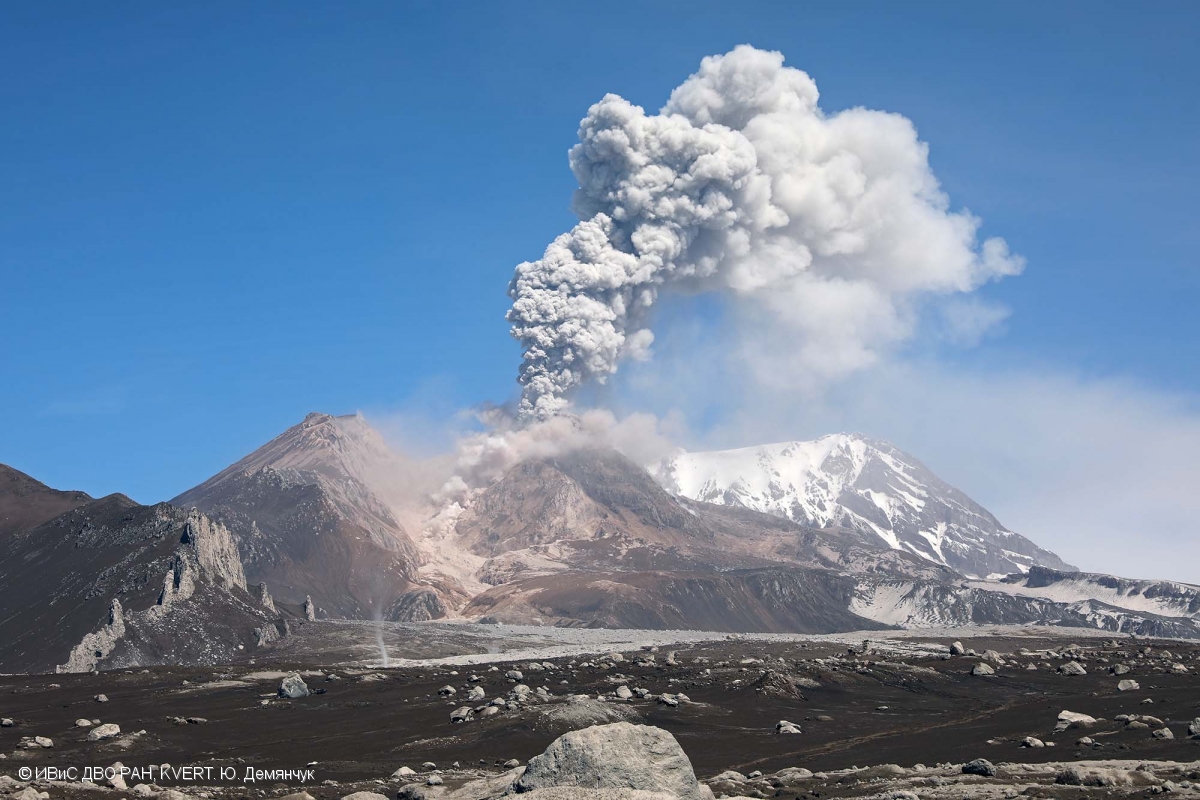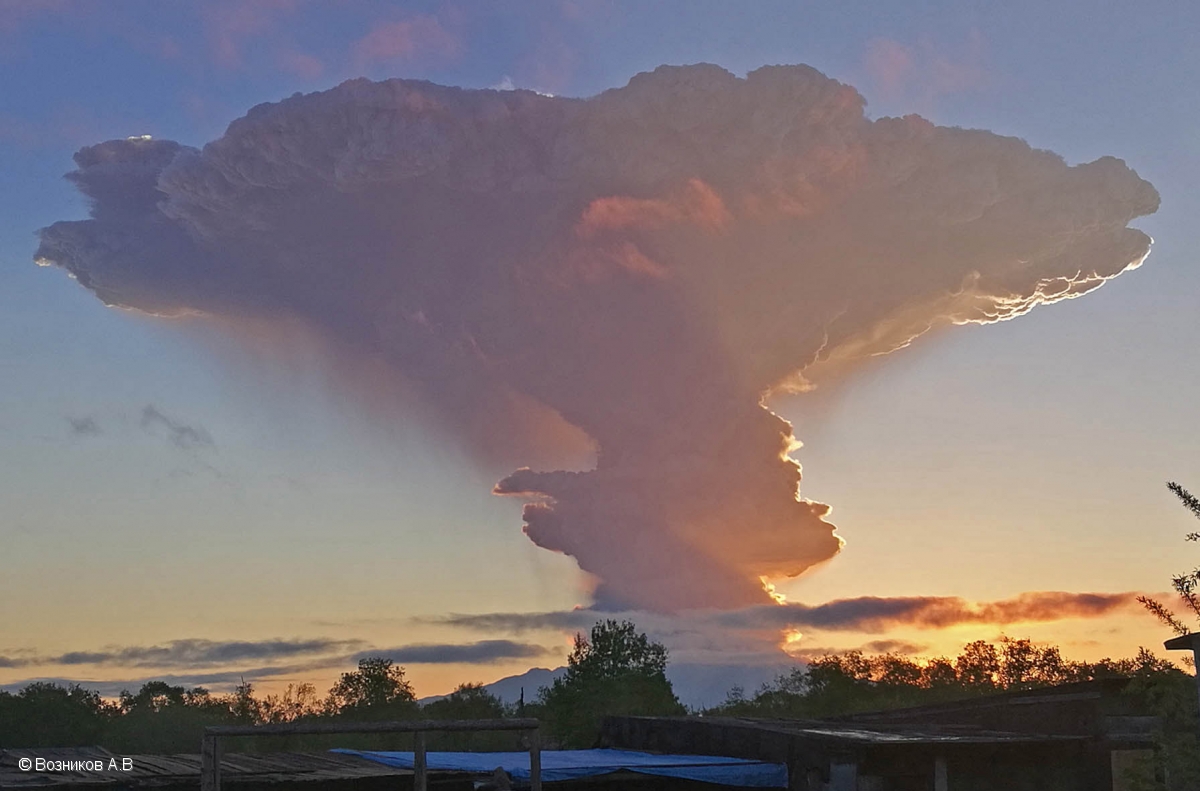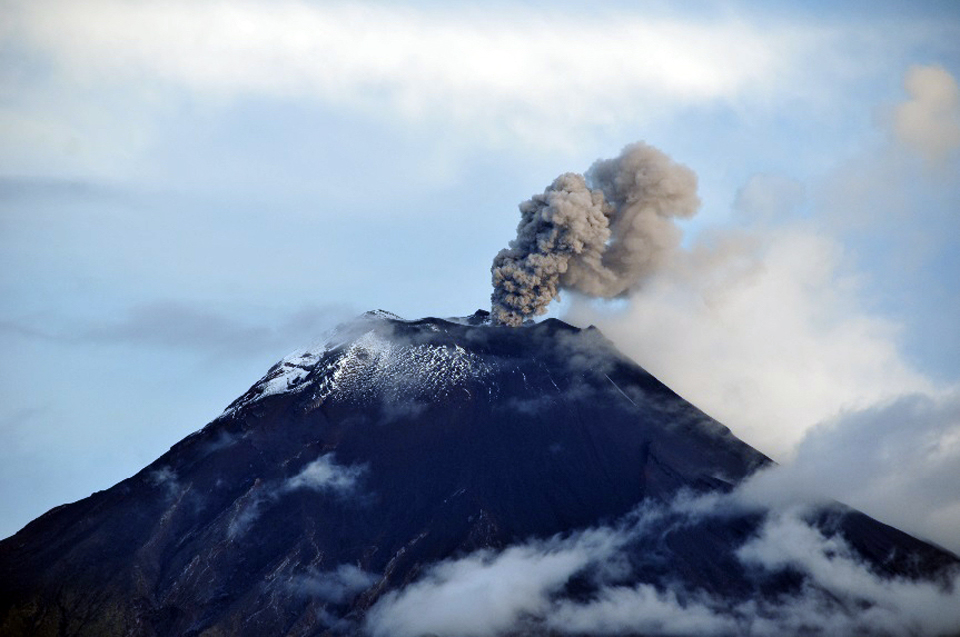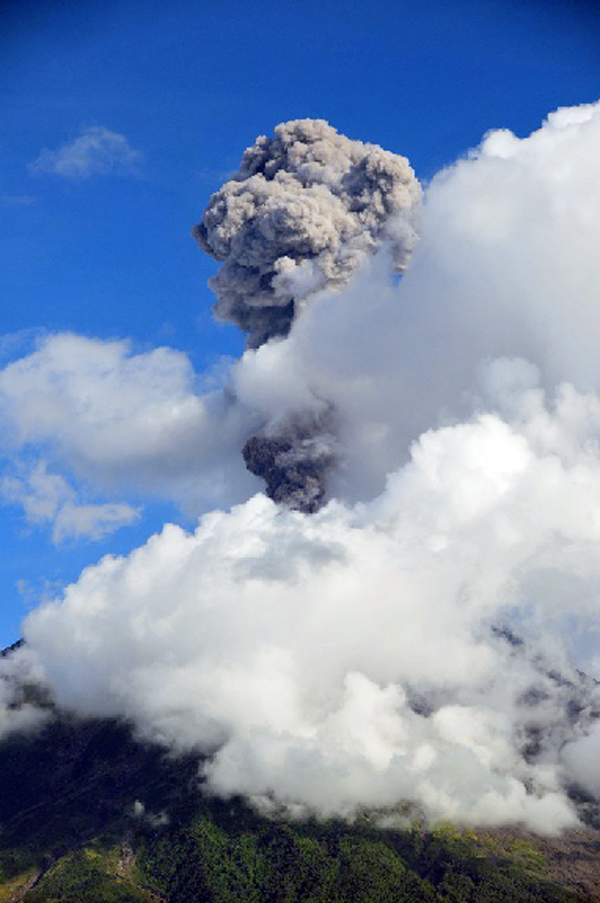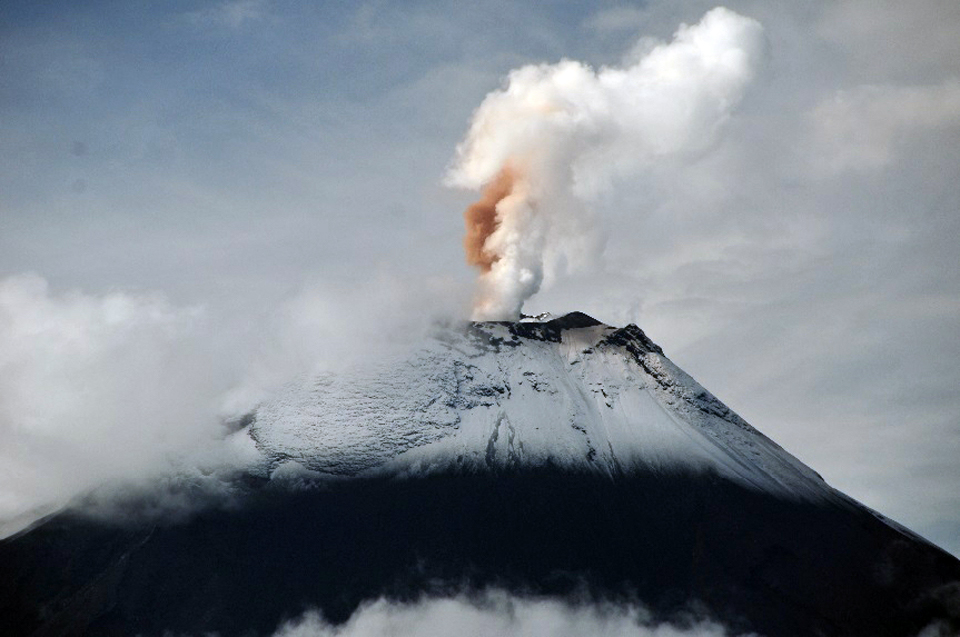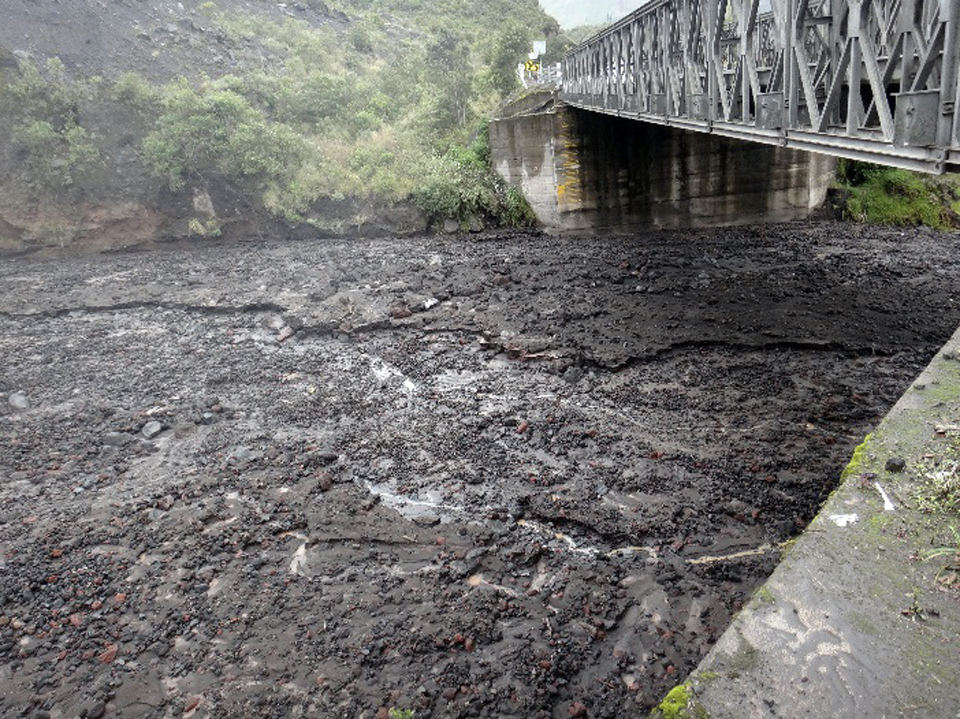Recently Published Bulletin Reports
Manam (Papua New Guinea) Few ash plumes during November-December 2022
Krakatau (Indonesia) Strombolian activity and ash plumes during November 2022-April 2023
Stromboli (Italy) Strombolian explosions and lava flows continue during January-April 2023
Nishinoshima (Japan) Small ash plumes and fumarolic activity during November 2022 through April 2023
Karangetang (Indonesia) Lava flows, incandescent avalanches, and ash plumes during January-June 2023
Ahyi (United States) Intermittent hydroacoustic signals and discolored plumes during November 2022-June 2023
Kadovar (Papua New Guinea) An ash plume and weak thermal anomaly during May 2023
San Miguel (El Salvador) Small gas-and-ash explosions during March and May 2023
Semisopochnoi (United States) Occasional explosions, ash deposits, and gas-and-steam plumes during December 2022-May 2023
Ebeko (Russia) Continued explosions, ash plumes, and ashfall during October 2022-May 2023
Home Reef (Tonga) Discolored plumes continued during November 2022-April 2023
Ambae (Vanuatu) New lava flow, ash plumes, and sulfur dioxide plumes during February-May 2023
Manam (Papua New Guinea) — July 2023  Cite this Report
Cite this Report
Manam
Papua New Guinea
4.08°S, 145.037°E; summit elev. 1807 m
All times are local (unless otherwise noted)
Few ash plumes during November-December 2022
Manam is a 10-km-wide island that consists of two active summit craters: the Main summit crater and the South summit crater and is located 13 km off the northern coast of mainland Papua New Guinea. Frequent mild-to-moderate eruptions have been recorded since 1616. The current eruption period began during June 2014 and has more recently been characterized by intermittent ash plumes and thermal activity (BGVN 47:11). This report updates activity that occurred from November 2022 through May 2023 based on information from the Darwin Volcanic Ash Advisory Center (VAAC) and various satellite data.
Ash plumes were reported during November and December 2022 by the Darwin VAAC. On 7 November an ash plume rose to 2.1 km altitude and drifted NE based on satellite images and weather models. On 14 November an ash plume rose to 2.1 km altitude and drifted W based on RVO webcam images. On 20 November ash plumes rose to 1.8 km altitude and drifted NW. On 26 December an ash plume rose to 3 km altitude and drifted S and SSE.
Intermittent sulfur dioxide plumes were detected using the TROPOMI instrument on the Sentinel-5P satellite, some of which exceeded at least two Dobson Units (DU) and drifted in different directions (figure 93). Occasional low-to-moderate power thermal anomalies were recorded by the MIROVA (Middle InfraRed Observation of Volcanic Activity) system; less than five anomalies were recorded each month during November 2022 through May 2023 (figure 94). Two thermal hotspots were detected by the MODVOLC thermal alerts system on 10 December 2022. On clear weather days, thermal activity was also captured in infrared satellite imagery in both the Main and South summit craters, accompanied by gas-and-steam emissions (figure 95).
Geologic Background. The 10-km-wide island of Manam, lying 13 km off the northern coast of mainland Papua New Guinea, is one of the country's most active volcanoes. Four large radial valleys extend from the unvegetated summit of the conical basaltic-andesitic stratovolcano to its lower flanks. These valleys channel lava flows and pyroclastic avalanches that have sometimes reached the coast. Five small satellitic centers are located near the island's shoreline on the northern, southern, and western sides. Two summit craters are present; both are active, although most observed eruptions have originated from the southern crater, concentrating eruptive products during much of the past century into the SE valley. Frequent eruptions, typically of mild-to-moderate scale, have been recorded since 1616. Occasional larger eruptions have produced pyroclastic flows and lava flows that reached flat-lying coastal areas and entered the sea, sometimes impacting populated areas.
Information Contacts: Rabaul Volcano Observatory (RVO), Geohazards Management Division, Department of Mineral Policy and Geohazards Management (DMPGM), PO Box 3386, Kokopo, East New Britain Province, Papua New Guinea; Darwin Volcanic Ash Advisory Centre (VAAC), Bureau of Meteorology, Northern Territory Regional Office, PO Box 40050, Casuarina, NT 0811, Australia (URL: http://www.bom.gov.au/info/vaac/); MIROVA (Middle InfraRed Observation of Volcanic Activity), a collaborative project between the Universities of Turin and Florence (Italy) supported by the Centre for Volcanic Risk of the Italian Civil Protection Department (URL: http://www.mirovaweb.it/); Hawai'i Institute of Geophysics and Planetology (HIGP) - MODVOLC Thermal Alerts System, School of Ocean and Earth Science and Technology (SOEST), Univ. of Hawai'i, 2525 Correa Road, Honolulu, HI 96822, USA (URL: http://modis.higp.hawaii.edu/); NASA Global Sulfur Dioxide Monitoring Page, Atmospheric Chemistry and Dynamics Laboratory, NASA Goddard Space Flight Center (NASA/GSFC), 8800 Greenbelt Road, Goddard, Maryland, USA (URL: https://so2.gsfc.nasa.gov/); Copernicus Browser, Copernicus Data Space Ecosystem, European Space Agency (URL: https://dataspace.copernicus.eu/browser/).
Krakatau (Indonesia) — July 2023  Cite this Report
Cite this Report
Krakatau
Indonesia
6.1009°S, 105.4233°E; summit elev. 285 m
All times are local (unless otherwise noted)
Strombolian activity and ash plumes during November 2022-April 2023
Krakatau is located in the Sunda Strait between Java and Sumatra, Indonesia. Caldera collapse during the catastrophic 1883 eruption destroyed Danan and Perbuwatan cones and left only a remnant of Rakata. The post-collapse cone of Anak Krakatau (Child of Krakatau) was constructed within the 1883 caldera at a point between the former Danan and Perbuwatan cones; it has been the site of frequent eruptions since 1927. The current eruption period began in May 2021 and has recently consisted of explosions, ash plumes, and thermal activity (BGVN 47:11). This report covers activity during November 2022 through April 2023 based on information provided by the Indonesian Center for Volcanology and Geological Hazard Mitigation, referred to as Pusat Vulkanologi dan Mitigasi Bencana Geologi (PVMBG), MAGMA Indonesia, the Darwin Volcanic Ash Advisory Center (VAAC), and several sources of satellite data.
Activity was relatively low during November and December 2022. Daily white gas-and-steam plumes rose 25-100 m above the summit and drifted in different directions. Gray ash plumes rose 200 m above the summit and drifted NE at 1047 and at 2343 on 11 November. On 14 November at 0933 ash plumes rose 300 m above the summit and drifted E. An ash plume was reported at 0935 on 15 December that rose 100 m above the summit and drifted NE. An eruptive event at 1031 later that day generated an ash plume that rose 700 m above the summit and drifted NE. A gray ash plume at 1910 rose 100 m above the summit and drifted E. Incandescent material was ejected above the vent based on an image taken at 1936.
During January 2023 daily white gas-and-steam plumes rose 25-300 m above the summit and drifted in multiple directions. Gray-to-brown ash plumes were reported at 1638 on 3 January, at 1410 and 1509 on 4 January, and at 0013 on 5 January that rose 100-750 m above the summit and drifted NE and E; the gray-to-black ash plume at 1509 on 4 January rose as high as 3 km above the summit and drifted E. Gray ash plumes were recorded at 1754, 2241, and 2325 on 11 January and at 0046 on 12 January and rose 200-300 m above the summit and drifted NE. Toward the end of January, PVMBG reported that activity had intensified; Strombolian activity was visible in webcam images taken at 0041, 0043, and 0450 on 23 January. Multiple gray ash plumes throughout the day rose 200-500 m above the summit and drifted E and SE (figure 135). Webcam images showed progressively intensifying Strombolian activity at 1919, 1958, and 2113 on 24 January; a gray ash plume at 1957 rose 300 m above the summit and drifted E (figure 135). Eruptive events at 0231 and 2256 on 25 January and at 0003 on 26 January ejected incandescent material from the vent, based on webcam images. Gray ash plumes observed during 26-27 January rose 300-500 m above the summit and drifted NE, E, and SE.
Low levels of activity were reported during February and March. Daily white gas-and-steam plumes rose 25-300 m above the summit and drifted in different directions. The Darwin VAAC reported that continuous ash emissions rose to 1.5-1.8 km altitude and drifted W and NW during 1240-1300 on 10 March, based on satellite images, weather models, and PVMBG webcams. White-and-gray ash plumes rose 500 m and 300 m above the summit and drifted SW at 1446 and 1846 on 18 March, respectively. An eruptive event was recorded at 2143, though it was not visible due to darkness. Multiple ash plumes were reported during 27-29 March that rose as high as 2.5 km above the summit and drifted NE, W, and SW (figure 136). Webcam images captured incandescent ejecta above the vent at 0415 and around the summit area at 2003 on 28 March and at 0047 above the vent on 29 March.
Daily white gas-and-steam plumes rose 25-300 m above the summit and drifted in multiple directions during April and May. White-and-gray and black plumes rose 50-300 m above the summit on 2 and 9 April. On 11 May at 1241 a gray ash plume rose 1-3 km above the summit and drifted SW. On 12 May at 0920 a gray ash plume rose 2.5 km above the summit and drifted SW and at 2320 an ash plume rose 1.5 km above the summit and drifted SW. An accompanying webcam image showed incandescent ejecta. On 13 May at 0710 a gray ash plume rose 2 km above the summit and drifted SW (figure 137).
The MIROVA (Middle InfraRed Observation of Volcanic Activity) graph of MODIS thermal anomaly data showed intermittent low-to-moderate power thermal anomalies during November 2022 through April 2023 (figure 138). Some of this thermal activity was also visible in infrared satellite imagery at the crater, accompanied by gas-and-steam and ash plumes that drifted in different directions (figure 139).
Geologic Background. The renowned Krakatau (frequently mis-named as Krakatoa) volcano lies in the Sunda Strait between Java and Sumatra. Collapse of an older edifice, perhaps in 416 or 535 CE, formed a 7-km-wide caldera. Remnants of that volcano are preserved in Verlaten and Lang Islands; subsequently the Rakata, Danan, and Perbuwatan cones were formed, coalescing to create the pre-1883 Krakatau Island. Caldera collapse during the catastrophic 1883 eruption destroyed Danan and Perbuwatan, and left only a remnant of Rakata. This eruption caused more than 36,000 fatalities, most as a result of tsunamis that swept the adjacent coastlines of Sumatra and Java. Pyroclastic surges traveled 40 km across the Sunda Strait and reached the Sumatra coast. After a quiescence of less than a half century, the post-collapse cone of Anak Krakatau (Child of Krakatau) was constructed within the 1883 caldera at a point between the former Danan and Perbuwatan cones. Anak Krakatau has been the site of frequent eruptions since 1927.
Information Contacts: Pusat Vulkanologi dan Mitigasi Bencana Geologi (PVMBG, also known as Indonesian Center for Volcanology and Geological Hazard Mitigation, CVGHM), Jalan Diponegoro 57, Bandung 40122, Indonesia (URL: http://www.vsi.esdm.go.id/); MAGMA Indonesia, Kementerian Energi dan Sumber Daya Mineral (URL: https://magma.esdm.go.id/v1); Darwin Volcanic Ash Advisory Centre (VAAC), Bureau of Meteorology, Northern Territory Regional Office, PO Box 40050, Casuarina, NT 0811, Australia (URL: http://www.bom.gov.au/info/vaac/); MIROVA (Middle InfraRed Observation of Volcanic Activity), a collaborative project between the Universities of Turin and Florence (Italy) supported by the Centre for Volcanic Risk of the Italian Civil Protection Department (URL: http://www.mirovaweb.it/); Copernicus Browser, Copernicus Data Space Ecosystem, European Space Agency (URL: https://dataspace.copernicus.eu/browser/).
Stromboli
Italy
38.789°N, 15.213°E; summit elev. 924 m
All times are local (unless otherwise noted)
Strombolian explosions and lava flows continue during January-April 2023
Stromboli, located in Italy, has exhibited nearly constant lava fountains for the past 2,000 years; recorded eruptions date back to 350 BCE. Eruptive activity occurs at the summit from multiple vents, which include a north crater area (N area) and a central-southern crater (CS area) on a terrace known as the ‘terrazza craterica’ at the head of the Sciara del Fuoco, a large scarp that runs from the summit down the NW side of the volcano-island. Activity typically consists of Strombolian explosions, incandescent ejecta, lava flows, and pyroclastic flows. Thermal and visual monitoring cameras are located on the nearby Pizzo Sopra La Fossa, above the terrazza craterica, and at multiple flank locations. The current eruption period has been ongoing since 1934 and recent activity has consisted of frequent Strombolian explosions and lava flows (BGVN 48:02). This report updates activity during January through April 2023 primarily characterized by Strombolian explosions and lava flows based on reports from Italy's Istituto Nazionale di Geofisica e Vulcanologia (INGV) and various satellite data.
Frequent explosive activity continued throughout the reporting period, generally in the low-to-medium range, based on the number of hourly explosions in the summit crater (figure 253, table 16). Intermittent thermal activity was recorded by the MIROVA (Middle InfraRed Observation of Volcanic Activity) analysis of MODIS satellite data (figure 254). According to data collected by the MODVOLC thermal algorithm, a total of 9 thermal alerts were detected: one on 2 January 2023, one on 1 February, five on 24 March, and two on 26 March. The stronger pulses of thermal activity likely reflected lava flow events. Infrared satellite imagery captured relatively strong thermal hotspots at the two active summit craters on clear weather days, showing an especially strong event on 8 March (figure 255).
Table 16. Summary of type, frequency, and intensity of explosive activity at Stromboli by month during January-April 2023; information from webcam observations. Courtesy of INGV weekly reports.
| Month |
Explosive Activity |
| Jan 2023 |
Typical Strombolian activity with spattering and lava overflows in the N crater area. Explosions were reported from 4 vents in the N area and 1-2 vents in the CS area. The average hourly frequency of explosions was low-to-medium (1-12 events/hour). The intensity of the explosions varied from low (less than 80 m high) to medium (less than 150 m high) in the N crater area and up to high (greater than 150 m high) in the CS crater area. |
| Feb 2023 |
Typical Strombolian activity with spattering in the N crater area. Explosions were reported from 2-3 vents in the N area and 1-4 vents in the CS area. The average hourly frequency of explosions was low-to-medium (1-14 events/hour). The intensity of the explosions varied from low (less than 80 m high) to medium (less than 150 m high) in the N crater area and up to high (greater than 150 m high) in the CS crater area. |
| Mar 2023 |
Typical Strombolian activity with spattering and lava overflows in the N crater area. Explosions were reported from 2-3 vents in the N area and 2-4 vents in the CS area. The average hourly frequency of explosions was low-to-medium (1-18 events/hour). The intensity of the explosions varied from low (less than 80 m high) to medium (less than 150 m high) in the N crater area and up to high (greater than 150 m high) in the CS crater area. |
| Apr 2023 |
Typical Strombolian activity. Explosions were reported from 2 vents in the N area and 2-3 vents in the CS area. The average hourly frequency of explosions was low-to-high (1-16 events/hour). The intensity of the explosions varied from low (less than 80 m high) to medium (less than 150 m high) in both the N and CS crater areas. |
Activity during January-February 2023. Strombolian explosions were reported in the N crater area, as well as lava effusion. Explosive activity in the N crater area ejected coarse material (bombs and lapilli). Intense spattering was observed in both the N1 and N2 craters. In the CS crater area, explosions generally ejected fine material (ash), sometimes to heights greater than 250 m. The intensity of the explosions was characterized as low-to-medium in the N crater and medium-to-high in the CS crater. After intense spattering activity from the N crater area, a lava overflow began at 2136 on 2 January that flowed part way down the Sciara del Fuoco, possibly moving down the drainage that formed in October, out of view from webcams. The flow remained active for a couple of hours before stopping and beginning to cool. A second lava flow was reported at 0224 on 4 January that similarly remained active for a few hours before stopping and cooling. Intense spattering was observed on 11 and 13 January from the N1 crater. After intense spattering activity at the N2 crater at 1052 on 17 January another lava flow started to flow into the upper part of the Sciara del Fuoco (figure 256), dividing into two: one that traveled in the direction of the drainage formed in October, and the other one moving parallel to the point of emission. By the afternoon, the rate of the flow began to decrease, and at 1900 it started to cool. A lava flow was reported at 1519 on 24 January following intense spattering in the N2 area, which began to flow into the upper part of the Sciara del Fuoco. By the morning of 25 January, the lava flow had begun to cool. During 27 January the frequency of eruption in the CS crater area increased to 6-7 events/hour compared to the typical 1-7 events/hour; the following two days showed a decrease in frequency to less than 1 event/hour. Starting at 1007 on 30 January a high-energy explosive sequence was produced by vents in the CS crater area. The sequence began with an initial energetic pulse that lasted 45 seconds, ejecting predominantly coarse products 300 m above the crater that fell in an ESE direction. Subsequent and less intense explosions ejected material 100 m above the crater. The total duration of this event lasted approximately two minutes. During 31 January through 6, 13, and 24 February spattering activity was particularly intense for short periods in the N2 crater.
An explosive sequence was reported on 16 February that was characterized by a major explosion in the CS crater area (figure 257). The sequence began at 1817 near the S2 crater that ejected material radially. A few seconds later, lava fountains were observed in the central part of the crater. Three explosions of medium intensity (material was ejected less than 150 m high) were recorded at the S2 crater. The first part of this sequence lasted approximately one minute, according to INGV, and material rose 300 m above the crater and then was deposited along the Sciara del Fuoco. The second phase began at 1818 at the S1 crater; it lasted seven seconds and material was ejected 150 m above the crater. Another event 20 seconds later lasted 12 seconds, also ejecting material 150 m above the crater. The sequence ended with at least three explosions of mostly fine material from the S1 crater. The total duration of this sequence was about two minutes.
Short, intense spattering activity was noted above the N1 crater on 27 and 28 February. A lava overflow was first reported at 0657 from the N2 crater on 27 February that flowed into the October 2022 drainage. By 1900 the flow had stopped. A second lava overflow also in the N crater area occurred at 2149, which overlapped the first flow and then stopped by 0150 on 28 February. Material detached from both the lava overflows rolled down the Sciara del Fuoco, some of which was visible in webcam images.
Activity during March-April 2023. Strombolian activity continued with spattering activity and lava overflows in the N crater area during March. Explosive activity at the N crater area varied from low (less than 80 m high) to medium (less than 150 m high) and ejected coarse material, such as bombs and lapilli. Spattering was observed above the N1 crater, while explosive activity at the CS crater area varied from medium to high (greater than 150 m high) and ejected coarse material. Intense spattering activity was observed for short periods on 6 March above the N1 crater. At approximately 0610 a lava overflow was reported around the N2 crater on 8 March, which then flowed into the October 2022 drainage. By 1700 the flow started to cool. A second overflow began at 1712 on 9 March and overlapped the previous flow. It had stopped by 2100. Material from both flows was deposited along the Sciara del Fuoco, though much of the activity was not visible in webcam images. On 11 March a lava overflow was observed at 0215 that overlapped the two previous flows in the October 2022 drainage. By late afternoon on 12 March, it had stopped.
During a field excursion on 16 March, scientists noted that a vent in the central crater area was degassing. Another vent showed occasional Strombolian activity that emitted ash and lapilli. During 1200-1430 low-to-medium intense activity was reported; the N1 crater emitted ash emissions and the N2 crater emitted both ash and coarse material. Some explosions also occurred in the CS crater area that ejected coarse material. The C crater in the CS crater area occasionally showed gas jetting and low intensity explosions on 17 and 22 March; no activity was observed at the S1 crater. Intense, longer periods of spattering were reported in the N1 crater on 19, 24, and 25 March. Around 2242 on 23 March a lava overflow began from the N1 crater that, after about an hour, began moving down the October 2022 drainage and flow along the Sciara del Fuoco (figure 258). Between 0200 and 0400 on 26 March the flow rate increased, which generated avalanches of material from collapses at the advancing flow front. By early afternoon, the flow began to cool. On 25 March at 1548 an explosive sequence began from one of the vents at S2 in the CS crater area (figure 258). Fine ash mixed with coarse material was ejected 300 m above the crater rim and drifted SSE. Some modest explosions around Vent C were detected at 1549 on 25 March, which included an explosion at 1551 that ejected coarse material. The entire explosive sequence lasted approximately three minutes.
During April explosions persisted in both the N and CS crater areas. Fine material was ejected less than 80 m above the N crater rim until 6 April, followed by ejection of coarser material. Fine material was also ejected less than 80 m above the CS crater rim. The C and S2 crater did not show significant eruptive activity. On 7 April an explosive sequence was detected in the CS crater area at 1203 (figure 259). The first explosion lasted approximately 18 seconds and ejected material 400 m above the crater rim, depositing pyroclastic material in the upper part of the Sciara del Fuoco. At 1204 a second, less intense explosion lasted approximately four seconds and deposited pyroclastic products outside the crater area and near Pizzo Sopra La Fossa. A third explosion at 1205 was mainly composed of ash that rose about 150 m above the crater and lasted roughly 20 seconds. A fourth explosion occurred at 1205 about 28 seconds after the third explosion and ejected a mixture of coarse and fine material about 200 m above the crater; the explosion lasted roughly seven seconds. Overall, the entire explosive sequence lasted about two minutes and 20 seconds. After the explosive sequence on 7 April, explosions in both the N and CS crater areas ejected material as high as 150 m above the crater.
On 21 April research scientists from INGV made field observations in the summit area of Stromboli, and some lapilli samples were collected. In the N crater area near the N1 crater, a small cone was observed with at least two active vents, one of which was characterized by Strombolian explosions. The other vent produced explosions that ejected ash and chunks of cooled lava. At the N2 crater at least one vent was active and frequently emitted ash. In the CS crater area, a small cone contained 2-3 degassing vents and a smaller, possible fissure area also showed signs of degassing close to the Pizzo Sopra La Fossa. In the S part of the crater, three vents were active: a small hornito was characterized by modest and rare explosions, a vent that intermittently produced weak Strombolian explosions, and a vent at the end of the terrace that produced frequent ash emissions. Near the S1 crater there was a hornito that generally emitted weak gas-and-steam emissions, sometimes associated with “gas rings”. On 22 April another field inspection was carried out that reported two large sliding surfaces on the Sciara del Fuoco that showed where blocks frequently descended toward the sea. A thermal anomaly was detected at 0150 on 29 April.
Geologic Background. Spectacular incandescent nighttime explosions at Stromboli have long attracted visitors to the "Lighthouse of the Mediterranean" in the NE Aeolian Islands. This volcano has lent its name to the frequent mild explosive activity that has characterized its eruptions throughout much of historical time. The small island is the emergent summit of a volcano that grew in two main eruptive cycles, the last of which formed the western portion of the island. The Neostromboli eruptive period took place between about 13,000 and 5,000 years ago. The active summit vents are located at the head of the Sciara del Fuoco, a prominent scarp that formed about 5,000 years ago due to a series of slope failures which extends to below sea level. The modern volcano has been constructed within this scarp, which funnels pyroclastic ejecta and lava flows to the NW. Essentially continuous mild Strombolian explosions, sometimes accompanied by lava flows, have been recorded for more than a millennium.
Information Contacts: Istituto Nazionale di Geofisica e Vulcanologia (INGV), Sezione di Catania, Piazza Roma 2, 95123 Catania, Italy, (URL: http://www.ct.ingv.it/en/); MIROVA (Middle InfraRed Observation of Volcanic Activity), a collaborative project between the Universities of Turin and Florence (Italy) supported by the Centre for Volcanic Risk of the Italian Civil Protection Department (URL: http://www.mirovaweb.it/); Hawai'i Institute of Geophysics and Planetology (HIGP) - MODVOLC Thermal Alerts System, School of Ocean and Earth Science and Technology (SOEST), Univ. of Hawai'i, 2525 Correa Road, Honolulu, HI 96822, USA (URL: http://modis.higp.hawaii.edu/); Copernicus Browser, Copernicus Data Space Ecosystem, European Space Agency (URL: https://dataspace.copernicus.eu/browser/).
Nishinoshima (Japan) — July 2023  Cite this Report
Cite this Report
Nishinoshima
Japan
27.247°N, 140.874°E; summit elev. 100 m
All times are local (unless otherwise noted)
Small ash plumes and fumarolic activity during November 2022 through April 2023
Nishinoshima is a small island located about 1,000 km S of Tokyo in the Ogasawara Arc in Japan. The island is the summit of a massive submarine volcano that has prominent peaks to the S, W, and NE. Eruptions date back to 1973; the most recent eruption period began in October 2022 and was characterized by ash plumes and fumarolic activity (BGVN 47:12). This report describes ash plumes and fumarolic activity during November 2022 through April 2023 based on monthly reports from the Japan Meteorological Agency (JMA) monthly reports and satellite data.
The most recent eruptive activity prior to the reporting internal occurred on 12 October 2022, when an ash plume rose 3.5 km above the crater rim. An aerial observation conducted by the Japan Coast Guard (JCG) on 25 November reported that white fumaroles rose approximately 200 m above the central crater of a pyroclastic cone (figure 119), and multiple plumes were observed on the ESE flank of the cone. Discolored water ranging from reddish-brown to brown and yellowish-green were visible around the perimeter of the island (figure 119). No significant activity was reported in December.
During an overflight conducted by JCG on 25 January 2023 intermittent activity and small, blackish-gray plumes rose 900 m above the central part of the crater were observed (figure 120). The fumarolic zone of the E flank and base of the cone had expanded and emissions had intensified. Dark brown discolored water was visible around the perimeter of the island.
No significant activity was reported during February through March. Ash plumes at 1050 and 1420 on 11 April rose 1.9 km above the crater rim and drifted NW and N. These were the first ash plumes observed since 12 October 2022. On 14 April JCG carried out an overflight and reported that no further eruptive activity was visible, although white gas-and-steam plumes were visible from the central crater and rose 900 m high (figure 121). Brownish and yellow-green discolored water surrounded the island.
Intermittent low-to-moderate power thermal anomalies were recorded in the MIROVA graph (Middle InfraRed Observation of Volcanic Activity) during November 2022 through April 2023 (figure 123). A cluster of six to eight anomalies were detected during November while a smaller number were detected during the following months: two to three during December, one during mid-January 2023, one during February, five during March, and two during April. Thermal activity was also reflected in infrared satellite data at the summit crater, accompanied by occasional gas-and-steam plumes (figure 124).
Geologic Background. The small island of Nishinoshima was enlarged when several new islands coalesced during an eruption in 1973-74. Multiple eruptions that began in 2013 completely covered the previous exposed surface and continued to enlarge the island. The island is the summit of a massive submarine volcano that has prominent peaks to the S, W, and NE. The summit of the southern cone rises to within 214 m of the ocean surface 9 km SSE.
Information Contacts: Japan Meteorological Agency (JMA), 1-3-4 Otemachi, Chiyoda-ku, Tokyo 100-8122, Japan (URL: http://www.jma.go.jp/jma/indexe.html); MIROVA (Middle InfraRed Observation of Volcanic Activity), a collaborative project between the Universities of Turin and Florence (Italy) supported by the Centre for Volcanic Risk of the Italian Civil Protection Department (URL: http://www.mirovaweb.it/); Copernicus Browser, Copernicus Data Space Ecosystem, European Space Agency (URL: https://dataspace.copernicus.eu/browser/).
Karangetang (Indonesia) — July 2023  Cite this Report
Cite this Report
Karangetang
Indonesia
2.781°N, 125.407°E; summit elev. 1797 m
All times are local (unless otherwise noted)
Lava flows, incandescent avalanches, and ash plumes during January-June 2023
Karangetang (also known as Api Siau), at the northern end of the island of Siau, Indonesia, contains five summit craters along a N-S line. More than 40 eruptions have been recorded since 1675; recent eruptions have included frequent explosive activity, sometimes accompanied by pyroclastic flows and lahars. Lava dome growth has occurred in the summit craters and collapses of lava flow fronts have produced pyroclastic flows. The two active summit craters are Kawah Dua (the N crater) and Kawah Utama (the S crater, also referred to as the “Main Crater”). The most recent eruption began in late November 2018 and has more recently consisted of weak thermal activity and gas-and-steam emissions (BGVN 48:01). This report updates activity characterized by lava flows, incandescent avalanches, and ash plumes during January through June 2023 using reports from Pusat Vulkanologi dan Mitigasi Bencana Geologi (PVMBG, also known as CVGHM, or the Center of Volcanology and Geological Hazard Mitigation), MAGMA Indonesia, the Darwin VAAC (Volcano Ash Advisory Center), and satellite data.
Activity during January was relatively low and mainly consisted of white gas-and-steam emissions that rose 25-150 m above Main Crater (S crater) and drifted in different directions. Incandescence was visible from the lava dome in Kawah Dua (the N crater). Weather conditions often prevented clear views of the summit. On 18 January the number of seismic signals that indicated avalanches of material began to increase. In addition, there were a total of 71 earthquakes detected during the month.
Activity continued to increase during the first week of February. Material from Main Crater traveled as far as 800 m down the Batuawang (S) and Batang (W) drainages and as far as 1 km W down the Beha (W) drainage on 4 February. On 6 February 43 earthquake events were recorded, and on 7 February, 62 events were recorded. White gas-and-steam emissions rose 25-250 m above both summit craters throughout the month. PVMBG reported an eruption began during the evening of 8 February around 1700. Photos showed incandescent material at Main Crater. Incandescent material had also descended the flank in at least two unconfirmed directions as far as 2 km from Main Crater, accompanied by ash plumes (figure 60). As a result, PVMBG increased the Volcano Alert Level (VAL) to 3 (the second highest level on a 1-4 scale).
Occasional nighttime webcam images showed three main incandescent lava flows of differing lengths traveling down the S, SW, and W flanks (figure 61). Incandescent rocks were visible on the upper flanks, possibly from ejected or collapsed material from the crater, and incandescence was the most intense at the summit. Based on analyses of satellite imagery and weather models, the Darwin VAAC reported that daily ash plumes during 16-20 February rose to 2.1-3 km altitude and drifted NNE, E, and SE. BNPB reported on 16 February that as many as 77 people were evacuated and relocated to the East Siau Museum. A webcam image taken at 2156 on 17 February possibly showed incandescent material descending the SE flank. Ash plumes rose to 2.1 km altitude and drifted SE during 22-23 February, according to the Darwin VAAC.
Incandescent avalanches of material and summit incandescence at Main Crater continued during March. White gas-and-steam emissions during March generally rose 25-150 m above the summit crater; on 31 March gas-and-steam emissions rose 200-400 m high. An ash plume rose to 2.4 km altitude and drifted S at 1710 on 9 March and a large thermal anomaly was visible in images taken at 0550 and 0930 on 10 March. Incandescent material was visible at the summit and on the flanks based on webcam images taken at 0007 and 2345 on 16 March, at 1828 on 17 March, at 1940 on 18 March, at 2311 on 19 March, and at 2351 on 20 March. Incandescence was most intense on 18 and 20 March and webcam images showed possible Strombolian explosions (figure 62). An ash plume rose to 2.4 km altitude and drifted SW on 18 March, accompanied by a thermal anomaly.
Summit crater incandescence at Main Crater and on the flanks persisted during April. Incandescent material at the S crater and on the flanks was reported at 0016 on 1 April. The lava flows had stopped by 1 April according to PVMBG, although incandescence was still visible up to 10 m high. Seismic signals indicating effusion decreased and by 6 April they were no longer detected. Incandescence was visible from both summit craters. On 26 April the VAL was lowered to 2 (the second lowest level on a 1-4 scale). White gas-and-steam emissions rose 25-200 m above the summit crater.
During May white gas-and-steam emissions generally rose 50-250 m above the summit, though it was often cloudy, which prevented clear views; on 21 May gas-and-steam emissions rose 50-400 m high. Nighttime N summit crater incandescence rose 10-25 m above the lava dome, and less intense incandescence was noted above Main Crater, which reached about 10 m above the dome. Sounds of falling rocks at Main Crater were heard on 15 May and the seismic network recorded 32 rockfall events in the crater on 17 May. Avalanches traveled as far as 1.5 km down the SW and S flanks, accompanied by rumbling sounds on 18 May. Incandescent material descending the flanks was captured in a webcam image at 2025 on 19 May (figure 63) and on 29 May; summit crater incandescence was observed in webcam images at 2332 on 26 May and at 2304 on 29 May. On 19 May the VAL was again raised to 3.
Occasional Main Crater incandescence was reported during June, as well as incandescent material on the flanks. White gas-and-steam emissions rose 10-200 m above the summit crater. Ash plumes rose to 2.1 km altitude and drifted SE and E during 2-4 June, according to the Darwin VAAC. Material on the flanks of Main Crater were observed at 2225 on 7 June, at 2051 on 9 June, at 0007 on 17 June, and at 0440 on 18 June. Webcam images taken on 21, 25, and 27 June showed incandescence at Main Crater and from material on the flanks.
MIROVA (Middle InfraRed Observation of Volcanic Activity) analysis of MODIS satellite data showed strong thermal activity during mid-February through March and mid-May through June, which represented incandescent avalanches and lava flows (figure 64). During April through mid-May the power of the anomalies decreased but frequent anomalies were still detected. Brief gaps in activity occurred during late March through early April and during mid-June. Infrared satellite images showed strong lava flows mainly affecting the SW and S flanks, accompanied by gas-and-steam emissions (figure 65). According to data recorded by the MODVOLC thermal algorithm, there were a total of 79 thermal hotspots detected: 28 during February, 24 during March, one during April, five during May, and 21 during June.
Geologic Background. Karangetang (Api Siau) volcano lies at the northern end of the island of Siau, about 125 km NNE of the NE-most point of Sulawesi. The stratovolcano contains five summit craters along a N-S line. It is one of Indonesia's most active volcanoes, with more than 40 eruptions recorded since 1675 and many additional small eruptions that were not documented (Neumann van Padang, 1951). Twentieth-century eruptions have included frequent explosive activity sometimes accompanied by pyroclastic flows and lahars. Lava dome growth has occurred in the summit craters; collapse of lava flow fronts have produced pyroclastic flows.
Information Contacts: Pusat Vulkanologi dan Mitigasi Bencana Geologi (PVMBG, also known as Indonesian Center for Volcanology and Geological Hazard Mitigation, CVGHM), Jalan Diponegoro 57, Bandung 40122, Indonesia (URL: http://www.vsi.esdm.go.id/); MAGMA Indonesia, Kementerian Energi dan Sumber Daya Mineral (URL: https://magma.esdm.go.id/v1); Badan Nasional Penanggulangan Bencana (BNPB), National Disaster Management Agency, Graha BNPB - Jl. Scout Kav.38, East Jakarta 13120, Indonesia (URL: http://www.bnpb.go.id/); Darwin Volcanic Ash Advisory Centre (VAAC), Bureau of Meteorology, Northern Territory Regional Office, PO Box 40050, Casuarina, NT 0811, Australia (URL: http://www.bom.gov.au/info/vaac/); MIROVA (Middle InfraRed Observation of Volcanic Activity), a collaborative project between the Universities of Turin and Florence (Italy) supported by the Centre for Volcanic Risk of the Italian Civil Protection Department (URL: http://www.mirovaweb.it/); Hawai'i Institute of Geophysics and Planetology (HIGP) - MODVOLC Thermal Alerts System, School of Ocean and Earth Science and Technology (SOEST), Univ. of Hawai'i, 2525 Correa Road, Honolulu, HI 96822, USA (URL: http://modis.higp.hawaii.edu/); Copernicus Browser, Copernicus Data Space Ecosystem, European Space Agency (URL: https://dataspace.copernicus.eu/browser/); IDN Times, Jl. Jend. Gatot Subroto Kav. 27 3rd Floor Kuningan, Jakarta, Indonesia 12950, Status of Karangetang Volcano in Sitaro Islands Increases (URL: https://sulsel.idntimes.com/news/indonesia/savi/status-gunung-api-karangetang-di-kepulauan-sitaro-meningkat?page=all).
Ahyi (United States) — July 2023  Cite this Report
Cite this Report
Ahyi
United States
20.42°N, 145.03°E; summit elev. -75 m
All times are local (unless otherwise noted)
Intermittent hydroacoustic signals and discolored plumes during November 2022-June 2023
Ahyi seamount is a large, conical submarine volcano that rises to within 75 m of the ocean surface about 18 km SE of the island of Farallon de Pajaros in the Northern Marianas. The remote location of the seamount has made eruptions difficult to document, but seismic stations installed in the region confirmed an eruption in the vicinity in 2001. No new activity was detected until April-May 2014 when an eruption was detected by NOAA (National Oceanic and Atmospheric Administration) divers, hydroacoustic sensors, and seismic stations (BGVN 42:04). New activity was first detected on 15 November by hydroacoustic sensors that were consistent with submarine volcanic activity. This report covers activity during November 2022 through June 2023 based on daily and weekly reports from the US Geological Survey.
Starting in mid-October, hydroacoustic sensors at Wake Island (2.2 km E) recorded signals consistent with submarine volcanic activity, according to a report from the USGS issued on 15 November 2022. A combined analysis of the hydroacoustic signals and seismic stations located at Guam and Chichijima Island, Japan, suggested that the source of this activity was at or near the Ahyi seamount. After a re-analysis of a satellite image of the area that was captured on 6 November, USGS confirmed that there was no evidence of discoloration at the ocean surface. Few hydroacoustic and seismic signals continued through November, including on 18 November, which USGS suggested signified a decline or pause in unrest. A VONA (Volcano Observatory Notice for Aviation) reported that a discolored water plume was persistently visible in satellite data starting on 18 November (figure 6). Though clouds often obscured clear views of the volcano, another discolored water plume was captured in a satellite image on 26 November. The Aviation Color Code (ACC) was raised to Yellow (the second lowest level on a four-color scale) and the Volcano Alert Level (VAL) was raised to Advisory (the second lowest level on a four-level scale) on 29 November.
During December, occasional detections were recorded on the Wake Island hydrophone sensors and discolored water over the seamount remained visible. During 2-7, 10-12, and 16-31 December possible explosion signals were detected. A small area of discolored water was observed in high-resolution Sentinel-2 satellite images during 1-6 December (figure 7). High-resolution satellite images recorded discolored water plumes on 13 December that originated from the summit region; no observations indicated that activity breached the ocean surface. A possible underwater plume was visible in satellite images on 18 December, and during 19-20 December a definite but diffuse underwater plume located SSE from the main vent was reported. An underwater plume was visible in a satellite image taken on 26 December (figure 7).
Hydrophone sensors continued to detect signals consistent with possible explosions during 1-8 January 2023. USGS reported that the number of detections decreased during 4-5 January. The hydrophone sensors experienced a data outage that started at 0118 on 8 January and continued through 10 January, though according to USGS, possible explosions were recorded prior to the data outage and likely continued during the outage. A discolored water plume originating from the summit region was detected in a partly cloudy satellite image on 8 January. On 11-12 and 15-17 January possible explosion signals were recorded again. One small signal was detected during 22-23 January and several signals were recorded on 25 and 31 January. During 27-31 January a plume of discolored water was observed above the seamount in satellite imagery (figure 8).
Low levels of activity continued during February and March, based on data from pressure sensors on Wake Island. During 1 and 4-6 February activity was reported, and a submarine plume was observed on 4 February (figure 8). Possible explosion signals were detected during 7-8, 10, 13-14, and 24 February. During 1-2 and 3-5 March a plume of discolored water was observed in satellite imagery (figure 8). Almost continuous hydroacoustic signals were detected in remote pressure sensor data on Wake Island 2,270 km E from the volcano during 7-13 March. During 12-13 March water discoloration around the seamount was observed in satellite imagery, despite cloudy weather. By 14 March discolored water extended about 35 km, but no direction was noted. USGS reported that the continuous hydroacoustic signals detected during 13-14 March stopped abruptly on 14 March and no new detections were observed. Three 30 second hydroacoustic detections were reported during 17-19 March, but no activity was visible due to cloudy weather. A data outage was reported during 21-22 March, making pressure sensor data unavailable; a discolored water plume was, however, visible in satellite data. A possible underwater explosion signal was detected by pressure sensors at Wake Island on 26, 29, and 31 March, though the cause and origin of these events were unclear.
Similar low activity continued during April, May, and June. Several signals were detected during 1-3 April in pressure sensors at Wake Island. USGS suggested that these may be related to underwater explosions or earthquakes at the volcano, but no underwater plumes were visible in clear satellite images. The pressure sensors had data outages during 12-13 April and no data were recorded; no underwater plumes were visible in satellite images, although cloudy weather obscured most clear views. Eruptive activity was reported starting at 2210 on 21 May. On 22 May a discolored water plume that extended 4 km was visible in satellite images, though no direction was recorded. During 23-24 May some signals were detected by the underwater pressure sensors. Possible hydroacoustic signals were detected during 2-3 and 6-8 June. Multiple hydroacoustic signals were detected during 9-11 and 16-17 June, although no activity was visible in satellite images. One hydroacoustic signal was detected during 23-24 June, but there was some uncertainty about its association with volcanic activity. A single possible hydroacoustic signal was detected during 30 June to 1 July.
Geologic Background. Ahyi seamount is a large conical submarine volcano that rises to within 75 m of the ocean surface ~18 km SE of the island of Farallon de Pajaros in the northern Marianas. Water discoloration has been observed there, and in 1979 the crew of a fishing boat felt shocks over the summit area, followed by upwelling of sulfur-bearing water. On 24-25 April 2001 an explosive eruption was detected seismically by a station on Rangiroa Atoll, Tuamotu Archipelago. The event was well constrained (+/- 15 km) at a location near the southern base of Ahyi. An eruption in April-May 2014 was detected by NOAA divers, hydroacoustic sensors, and seismic stations.
Information Contacts: US Geological Survey, Volcano Hazards Program (USGS-VHP), 12201 Sunrise Valley Drive, Reston, VA, USA, https://volcanoes.usgs.gov/index.html; Copernicus Browser, Copernicus Data Space Ecosystem, European Space Agency (URL: https://dataspace.copernicus.eu/browser/).
Kadovar (Papua New Guinea) — June 2023  Cite this Report
Cite this Report
Kadovar
Papua New Guinea
3.608°S, 144.588°E; summit elev. 365 m
All times are local (unless otherwise noted)
An ash plume and weak thermal anomaly during May 2023
Kadovar is a 2-km-wide island that is the emergent summit of a Bismarck Sea stratovolcano. It lies off the coast of New Guinea, about 25 km N of the mouth of the Sepik River. Prior to an eruption that began in 2018, a lava dome formed the high point of the volcano, filling an arcuate landslide scarp open to the S. Submarine debris-avalanche deposits occur to the S of the island. The current eruption began in January 2018 and has comprised lava effusion from vents at the summit and at the E coast; more recent activity has consisted of ash plumes, weak thermal activity, and gas-and-steam plumes (BGVN 48:02). This report covers activity during February through May 2023 using information from the Darwin Volcanic Ash Advisory Center (VAAC) and satellite data.
Activity during the reporting period was relatively low and mainly consisted of white gas-and-steam plumes that were visible in natural color satellite images on clear weather days (figure 67). According to a Darwin VAAC report, at 2040 on 6 May an ash plume rose to 4.6 km altitude and drifted W; by 2300 the plume had dissipated. MODIS satellite instruments using the MODVOLC thermal algorithm detected a single thermal hotspot on the SE side of the island on 7 May. Weak thermal activity was also detected in a satellite image on the E side of the island on 14 May, accompanied by a white gas-and-steam plume that drifted SE (figure 68).
Geologic Background. The 2-km-wide island of Kadovar is the emergent summit of a Bismarck Sea stratovolcano of Holocene age. It is part of the Schouten Islands, and lies off the coast of New Guinea, about 25 km N of the mouth of the Sepik River. Prior to an eruption that began in 2018, a lava dome formed the high point of the andesitic volcano, filling an arcuate landslide scarp open to the south; submarine debris-avalanche deposits occur in that direction. Thick lava flows with columnar jointing forms low cliffs along the coast. The youthful island lacks fringing or offshore reefs. A period of heightened thermal phenomena took place in 1976. An eruption began in January 2018 that included lava effusion from vents at the summit and at the E coast.
Information Contacts: Darwin Volcanic Ash Advisory Centre (VAAC), Bureau of Meteorology, Northern Territory Regional Office, PO Box 40050, Casuarina, NT 0811, Australia (URL: http://www.bom.gov.au/info/vaac/); Hawai'i Institute of Geophysics and Planetology (HIGP) - MODVOLC Thermal Alerts System, School of Ocean and Earth Science and Technology (SOEST), Univ. of Hawai'i, 2525 Correa Road, Honolulu, HI 96822, USA (URL: http://modis.higp.hawaii.edu/); Copernicus Browser, Copernicus Data Space Ecosystem, European Space Agency (URL: https://dataspace.copernicus.eu/browser/).
San Miguel (El Salvador) — June 2023  Cite this Report
Cite this Report
San Miguel
El Salvador
13.434°N, 88.269°W; summit elev. 2130 m
All times are local (unless otherwise noted)
Small gas-and-ash explosions during March and May 2023
San Miguel in El Salvador is a broad, deep crater complex that has been frequently modified by eruptions recorded since the early 16th century and consists of the summit known locally as Chaparrastique. Flank eruptions have produced lava flows that extended to the N, NE, and SE during the 17-19th centuries. The most recent activity has consisted of minor ash eruptions from the summit crater. The current eruption period began in November 2022 and has been characterized by frequent phreatic explosions, gas-and-ash emissions, and sulfur dioxide plumes (BGVN 47:12). This report describes small gas-and-ash explosions during December 2022 through May 2023 based on special reports from the Ministero de Medio Ambiente y Recursos Naturales (MARN).
Activity has been relatively low since the last recorded explosions on 29 November 2022. Seismicity recorded by the San Miguel Volcano Station (VSM) located on the N flank at 1.7 km elevation had decreased by 7 December. Sulfur dioxide gas measurements taken with DOAS (Differential Optical Absorption Spectroscopy) mobile equipment were below typical previously recorded values: 300 tons per day (t/d). During December, small explosions were recorded by the seismic network and manifested as gas-and-steam emissions.
Gas-and-ash explosions in the crater occurred during January 2023, which were recorded by the seismic network. Sulfur dioxide values remained low, between 300-400 t/d through 10 March. At 0817 on 14 January a gas-and-ash emission was visible in webcam images, rising just above the crater rim. Some mornings during February, small gas-and-steam plumes were visible in the crater. On 7 March at 2252 MARN noted an increase in degassing from the central crater; gas emissions were constantly observed through the early morning hours on 8 March. During the early morning of 8 March through the afternoon on 9 March, 12 emissions were registered, some accompanied by ash. The last gas-and-ash emission was recorded at 1210 on 9 March; very fine ashfall was reported in El Tránsito (10 km S), La Morita (6 km W), and La Piedrita (3 km W). The smell of sulfur was reported in Piedra Azul (5 km SW). On 16 March MARN reported that gas-and-steam emissions decreased.
Low degassing and very low seismicity were reported during April; no explosions have been detected between 9 March and 27 May. The sulfur dioxide emissions remained between 350-400 t/d; during 13-20 April sulfur dioxide values fluctuated between 30-300 t/d. Activity remained low through most of May; on 23 May seismicity increased. An explosion was detected at 1647 on 27 May generated a gas-and-ash plume that rose 700 m high (figure 32); a decrease in seismicity and gas emissions followed. The DOAS station installed on the W flank recorded sulfur dioxide values that reached 400 t/d on 27 May; subsequent measurements showed a decrease to 268 t/d on 28 May and 100 t/d on 29 May.
Geologic Background. The symmetrical cone of San Miguel, one of the most active volcanoes in El Salvador, rises from near sea level to form one of the country's most prominent landmarks. A broad, deep, crater complex that has been frequently modified by eruptions recorded since the early 16th century caps the truncated unvegetated summit, also known locally as Chaparrastique. Flanks eruptions of the basaltic-andesitic volcano have produced many lava flows, including several during the 17th-19th centuries that extended to the N, NE, and SE. The SE-flank flows are the largest and form broad, sparsely vegetated lava fields crossed by highways and a railroad skirting the base of the volcano. Flank vent locations have migrated higher on the edifice during historical time, and the most recent activity has consisted of minor ash eruptions from the summit crater.
Information Contacts: Ministero de Medio Ambiente y Recursos Naturales (MARN), Km. 5½ Carretera a Nueva San Salvador, Avenida las Mercedes, San Salvador, El Salvador (URL: http://www.snet.gob.sv/ver/vulcanologia).
Semisopochnoi (United States) — June 2023  Cite this Report
Cite this Report
Semisopochnoi
United States
51.93°N, 179.58°E; summit elev. 1221 m
All times are local (unless otherwise noted)
Occasional explosions, ash deposits, and gas-and-steam plumes during December 2022-May 2023
Semisopochnoi is located in the western Aleutians, is 20-km-wide at sea level, and contains an 8-km-wide caldera. The three-peaked Mount Young (formerly Cerberus) was constructed within the caldera during the Holocene. Each of these peaks contains a summit crater; the lava flows on the N flank appear younger than those on the S side. The current eruption period began in early February 2021 and has more recently consisted of intermittent explosions and ash emissions (BGVN 47:12). This report updates activity during December 2022 through May 2023 using daily, weekly, and special reports from the Alaska Volcano Observatory (AVO). AVO monitors the volcano using local seismic and infrasound sensors, satellite data, web cameras, and remote infrasound and lightning networks.
Activity during most of December 2022 was relatively quiet; according to AVO no eruptive or explosive activity was observed since 7 November 2022. Intermittent tremor and occasional small earthquakes were observed in geophysical data. Continuous gas-and-steam emissions were observed from the N crater of Mount Young in webcam images on clear weather days (figure 25). On 24 December, there was a slight increase in earthquake activity and several small possible explosion signals were detected in infrasound data. Eruptive activity resumed on 27 December at the N crater of Mount Young; AVO issued a Volcano Activity Notice (VAN) that reported minor ash deposits on the flanks of Mount Young that extended as far as 1 km from the vent, according to webcam images taken during 27-28 December (figure 26). No ash plumes were observed in webcam or satellite imagery, but a persistent gas-and-steam plume that might have contained some ash rose to 1.5 km altitude. As a result, AVO raised the Aviation Color Code (ACC) to Orange (the second highest level on a four-color scale) and the Volcano Alert Level (VAL) to Watch (the second highest level on a four-level scale). Possible explosions were detected during 21 December 2022 through 1 January 2023 and seismic tremor was recorded during 30-31 December.
During January 2023 eruptive activity continued at the active N crater of Mount Young. Minor ash deposits were observed on the flanks, extending about 2 km SSW, based on webcam images from 1 and 3 January. A possible explosion occurred during 1-2 January based on elevated seismicity recorded on local seismometers and an infrasound signal recorded minutes later by an array at Adak. Though no ash plumes were observed in webcam or satellite imagery, a persistent gas-and-steam plume rose to 1.5 km altitude that might have carried minor traces of ash. Ash deposits were accompanied by periods of elevated seismicity and infrasound signals from the local geophysical network, which AVO reported were likely due to weak explosive activity. Low-level explosive activity was also detected during 2-3 January, with minor gas-and-steam emissions and a new ash deposit that was visible in webcam images. Low-level explosive activity was detected in geophysical data during 4-5 January, with elevated seismicity and infrasound signals observed on local stations. Volcanic tremor was detected during 7-9 January and very weak explosive activity was detected in seismic and infrasound data on 9 January. Weak seismic and infrasound signals were recorded on 17 January, which indicated minor explosive activity, but no ash emissions were observed in clear webcam images; a gas-and-steam plume continued to rise to 1.5 km altitude. During 29-30 January, ash deposits near the summit were observed on fresh snow, according to webcam images.
The active N cone at Mount Young continued to produce a gas-and-steam plume during February, but no ash emissions or explosive events were detected. Seismicity remained elevated with faint tremor during early February. Gas-and-steam emissions from the N crater were observed in clear webcam images on 11-13 and 16 February; no explosive activity was detected in seismic, infrasound, or satellite data. Seismicity has also decreased, with no significant seismic tremor observed since 25 January. Therefore, the ACC was lowered to Yellow (the second lowest level on a four-color scale) and the VAL was lowered to Advisory (the second lowest level on a four-color scale) on 22 February.
Gas-and-steam emissions persisted during March from the N cone of Mount Young, based on clear webcam images. A few brief episodes of weak tremor were detected in seismic data, although seismicity decreased over the month. A gas-and-steam plume detected in satellite data extended 150 km on 18 March. Low-level ash emissions from the N cone at Mount Young were observed in several webcam images during 18-19 March, in addition to small explosions and volcanic tremor. The ACC was raised to Orange and the VAL increased to Watch on 19 March. A small explosion was detected in seismic and infrasound data on 21 March.
Low-level unrest continued during April, although cloudy weather often obscured views of the summit; periods of seismic tremor and local earthquakes were recorded. During 3-4 April a gas-and-steam plume was visible traveling more than 200 km overnight; no ash was evident in the plume, according to AVO. A gas-and-steam plume was observed during 4-6 April that extended 400 km but did not seem to contain ash. Small explosions were detected in seismic and infrasound data on 5 April. Occasional clear webcam images showed continuing gas-and-steam emissions rose from Mount Young, but no ash deposits were observed on the snow. On 19 April small explosions and tremor were detected in seismic and infrasound data. A period of seismic tremor was detected during 22-25 April, with possible weak explosions on 25 April. Ash deposits were visible near the crater rim, but it was unclear if these deposits were recent or due to older deposits.
Occasional small earthquakes were recorded during May, but there were no signs of explosive activity seen in geophysical data. Gas-and-steam emissions continued from the N crater of Mount Young, based on webcam images, and seismicity remained slightly elevated. A new, light ash deposit was visible during the morning of 5 May on fresh snow on the NW flank of Mount Young. During 10 May periods of volcanic tremor were observed. The ACC was lowered to Yellow and the VAL to Advisory on 17 May due to no additional evidence of activity.
Geologic Background. Semisopochnoi, the largest subaerial volcano of the western Aleutians, is 20 km wide at sea level and contains an 8-km-wide caldera. It formed as a result of collapse of a low-angle, dominantly basaltic volcano following the eruption of a large volume of dacitic pumice. The high point of the island is Anvil Peak, a double-peaked late-Pleistocene cone that forms much of the island's northern part. The three-peaked Mount Cerberus (renamed Mount Young in 2023) was constructed within the caldera during the Holocene. Each of the peaks contains a summit crater; lava flows on the N flank appear younger than those on the south side. Other post-caldera volcanoes include the symmetrical Sugarloaf Peak SSE of the caldera and Lakeshore Cone, a small cinder cone at the edge of Fenner Lake in the NE part of the caldera. Most documented eruptions have originated from Young, although Coats (1950) considered that both Sugarloaf and Lakeshore Cone could have been recently active.
Information Contacts: Alaska Volcano Observatory (AVO), a cooperative program of a) U.S. Geological Survey, 4200 University Drive, Anchorage, AK 99508-4667 USA (URL: https://avo.alaska.edu/), b) Geophysical Institute, University of Alaska, PO Box 757320, Fairbanks, AK 99775-7320, USA, and c) Alaska Division of Geological & Geophysical Surveys, 794 University Ave., Suite 200, Fairbanks, AK 99709, USA (URL: http://dggs.alaska.gov/).
Ebeko
Russia
50.686°N, 156.014°E; summit elev. 1103 m
All times are local (unless otherwise noted)
Continued explosions, ash plumes, and ashfall during October 2022-May 2023
Ebeko, located on the N end of Paramushir Island in the Kuril Islands, consists of three summit craters along a SSW-NNE line at the northern end of a complex of five volcanic cones. Eruptions date back to the late 18th century and have been characterized as small-to-moderate explosions from the summit crater, accompanied by intense fumarolic activity. The current eruption period began in June 2022 and has recently consisted of frequent explosions, ash plumes, and thermal activity (BGVN 47:10). This report covers similar activity during October 2022 through May 2023, based on information from the Kamchatka Volcanic Eruptions Response Team (KVERT) and satellite data.
Activity during October consisted of explosive activity, ash plumes, and occasional thermal anomalies. Visual data by volcanologists from Severo-Kurilsk showed explosions producing ash clouds up to 2.1-3 km altitude which drifted E, N, NE, and SE during 1-8, 10, 16, and 18 October. KVERT issued several Volcano Observatory Notices for Aviation (VONA) on 7, 13-15, and 27 October 2022, stating that explosions generated ash plumes that rose to 2.3-4 km altitude and drifted 5 km E, NE, and SE. Ashfall was reported in Severo-Kurilsk (Paramushir Island, about 7 km E) on 7 and 13 October. Satellite data showed a thermal anomaly over the volcano on 15-16 October. Visual data showed ash plumes rising to 2.5-3.6 km altitude on 22, 25-29, and 31 October and moving NE due to constant explosions.
Similar activity continued during November, with explosions, ash plumes, and ashfall occurring. KVERT issued VONAs on 1-2, 4, 6-7, 9, 13, and 16 November that reported explosions and resulting ash plumes that rose to 1.7-3.6 km altitude and drifted 3-5 km SE, ESE, E, and NE. On 1 November ash plumes extended as far as 110 km SE. On 5, 8, 12, and 24-25 November explosions and ash plumes rose to 2-3.1 km altitude and drifted N and E. Ashfall was observed in Severo-Kurilsk on 7 and 16 November. A thermal anomaly was visible during 1-4, 16, and 20 November. Explosions during 26 November rose as high as 2.7 km altitude and drifted NE (figure 45).
Explosions and ash plumes continued to occur in December. During 1-2 and 4 December volcanologists from Severo-Kurilsk observed explosions that sent ash to 1.9-2.5 km altitude and drifted NE and SE (figure 46). VONAs were issued on 5, 9, and 16 December reporting that explosions generated ash plumes rising to 1.9 km, 2.6 km, and 2.4 km altitude and drifted 5 km SE, E, and NE, respectively. A thermal anomaly was visible in satellite imagery on 16 December. On 18 and 27-28 December explosions produced ash plumes that rose to 2.5 km altitude and drifted NE and SE. On 31 December an ash plume rose to 2 km altitude and drifted NE.
Explosions continued during January 2023, based on visual observations by volcanologists from Severo-Kurilsk. During 1-7 January explosions generated ash plumes that rose to 4 km altitude and drifted NE, E, W, and SE. According to VONAs issued by KVERT on 2, 4, 10, and 23 January, explosions produced ash plumes that rose to 2-4 km altitude and drifted 5 km N, NE, E, and ENE; the ash plume that rose to 4 km altitude occurred on 10 January (figure 47). Satellite data showed a thermal anomaly during 3-4, 10, 13, 16, 21, 22, and 31 January. KVERT reported that an ash cloud on 4 January moved 12 km NE. On 6 and 9-11 January explosions sent ash plumes to 4.5 km altitude and drifted W and ESE. On 13 January an ash plume rose to 3 km altitude and drifted SE. During 20-24 January ash plumes from explosions rose to 3.7 km altitude and drifted SE, N, and NE. On 21 January the ash plume drifted as far as 40 km NE. During 28-29 and 31 January and 1 February ash plumes rose to 4 km altitude and drifted NE.
During February, explosions, ash plumes, and ashfall were reported. During 1, 4-5 and 7-8 February explosions generated ash plumes that rose to 4.5 km altitude and drifted E and NE; ashfall was observed on 5 and 8 February. On 6 February an explosion produced an ash plume that rose to 3 km altitude and drifted 7 km E, causing ashfall in Severo-Kurilsk. A thermal anomaly was visible in satellite data on 8, 9, 13, and 21 February. Explosions on 9 and 12-13 February produced ash plumes that rose to 4 km altitude and drifted E and NE; the ash cloud on 12 February extended as far as 45 km E. On 22 February explosions sent ash to 3 km altitude that drifted E. During 24 and 26-27 February ash plumes rose to 4 km altitude and drifted E. On 28 February an explosion sent ash to 2.5-3 km altitude and drifted 5 km E; ashfall was observed in Severo-Kurilsk.
Activity continued during March; visual observations showed that explosions generated ash plumes that rose to 3.6 km altitude on 3, 5-7, and 9-12 March and drifted E, NE, and NW. Thermal anomalies were visible on 10, 13, and 29-30 March in satellite imagery. On 18, 21-23, 26, and 29-30 March explosions produced ash plumes that rose to 2.8 km altitude and drifted NE and E; the ash plumes during 22-23 March extended up to 76 km E. A VONA issued on 21 March reported an explosion that produced an ash plume that rose to 2.8 km altitude and drifted 5 km E. Another VONA issued on 23 March reported that satellite data showed an ash plume rising to 3 km altitude and drifted 14 km E.
Explosions during April continued to generate ash plumes. On 1 and 4 April an ash plume rose to 2.8-3.5 km altitude and drifted SE and NE. A thermal anomaly was visible in satellite imagery during 1-6 April. Satellite data showed ash plumes and clouds rising to 2-3 km altitude and drifting up to 12 km SW and E on 3 and 6 April (figure 48). KVERT issued VONAs on 3, 5, 14, 16 April describing explosions that produced ash plumes rising to 3 km, 3.5 km, 3.5 km, and 3 km altitude and drifting 5 km S, 5 km NE and SE, 72 km NNE, and 5 km NE, respectively. According to satellite data, the resulting ash cloud from the explosion on 14 April was 25 x 7 km in size and drifted 72-104 km NNE during 14-15 April. According to visual data by volcanologists from Severo-Kurilsk explosions sent ash up to 3.5 km altitude that drifted NE and E during 15-16, 22, 25-26, and 29 April.
The explosive eruption continued during May. Explosions during 3-4, 6-7, and 9-10 May generated ash plumes that rose to 4 km altitude and drifted SW and E. Satellite data showed a thermal anomaly on 3, 9, 13-14, and 24 May. During 12-16, 23-25, and 27-28 May ash plumes rose to 3.5 km altitude and drifted in different directions due to explosions. Two VONA notices were issued on 16 and 25 May, describing explosions that generated ash plumes rising to 3 km and 3.5 km altitude, respectively and extending 5 km E. The ash cloud on 25 May drifted 75 km SE.
Thermal activity in the summit crater, occasionally accompanied by ash plumes and ash deposits on the SE and E flanks due to frequent explosions, were visible in infrared and true color satellite images (figure 49).
Geologic Background. The flat-topped summit of the central cone of Ebeko volcano, one of the most active in the Kuril Islands, occupies the northern end of Paramushir Island. Three summit craters located along a SSW-NNE line form Ebeko volcano proper, at the northern end of a complex of five volcanic cones. Blocky lava flows extend west from Ebeko and SE from the neighboring Nezametnyi cone. The eastern part of the southern crater contains strong solfataras and a large boiling spring. The central crater is filled by a lake about 20 m deep whose shores are lined with steaming solfataras; the northern crater lies across a narrow, low barrier from the central crater and contains a small, cold crescentic lake. Historical activity, recorded since the late-18th century, has been restricted to small-to-moderate explosive eruptions from the summit craters. Intense fumarolic activity occurs in the summit craters, on the outer flanks of the cone, and in lateral explosion craters.
Information Contacts: Kamchatka Volcanic Eruptions Response Team (KVERT), Far Eastern Branch, Russian Academy of Sciences, 9 Piip Blvd., Petropavlovsk-Kamchatsky, 683006, Russia (URL: http://www.kscnet.ru/ivs/kvert/); MIROVA (Middle InfraRed Observation of Volcanic Activity), a collaborative project between the Universities of Turin and Florence (Italy) supported by the Centre for Volcanic Risk of the Italian Civil Protection Department (URL: http://www.mirovaweb.it/); Copernicus Browser, Copernicus Data Space Ecosystem, European Space Agency (URL: https://dataspace.copernicus.eu/browser/).
Home Reef
Tonga
18.992°S, 174.775°W; summit elev. -10 m
All times are local (unless otherwise noted)
Discolored plumes continued during November 2022-April 2023
Home Reef is a submarine volcano located in the central Tonga islands between Lateiki (Metis Shoal) and Late Island. The first recorded eruption occurred in the mid-19th century, when an ephemeral island formed. An eruption in 1984 produced a 12-km-high eruption plume, a large volume of floating pumice, and an ephemeral island 500 x 1,500 m wide, with cliffs 30-50 m high that enclosed a water-filled crater. Another island-forming eruption in 2006 produced widespread pumice rafts that drifted as far as Australia; by 2008 the island had eroded below sea level. The previous eruption occurred during October 2022 and was characterized by a new island-forming eruption, lava effusion, ash plumes, discolored water, and gas-and-steam plumes (BGVN 47:11). This report covers discolored water plumes during November 2022 through April 2023 using satellite data.
Discolored plumes continued during the reporting period and were observed in true color satellite images on clear weather days. Satellite images show light green-yellow discolored water extending W on 8 and 28 November 2022 (figure 31), and SW on 18 November. Light green-yellow plumes extended W on 3 December, S on 13 December, SW on 18 December, and W and S on 23 December (figure 31). On 12 January 2023 discolored green-yellow plumes extended to the NE, E, SE, and N. The plume moved SE on 17 January and NW on 22 January. Faint discolored water in February was visible moving NE on 1 February. A discolored plume extended NW on 8 and 28 March and NW on 13 March (figure 31). During April, clear weather showed green-blue discolored plumes moving S on 2 April, W on 7 April, and NE and S on 12 April. A strong green-yellow discolored plume extended E and NE on 22 April for several kilometers (figure 31).
Geologic Background. Home Reef, a submarine volcano midway between Metis Shoal and Late Island in the central Tonga islands, was first reported active in the mid-19th century, when an ephemeral island formed. An eruption in 1984 produced a 12-km-high eruption plume, large amounts of floating pumice, and an ephemeral 500 x 1,500 m island, with cliffs 30-50 m high that enclosed a water-filled crater. In 2006 an island-forming eruption produced widespread dacitic pumice rafts that drifted as far as Australia. Another island was built during a September-October 2022 eruption.
Information Contacts: Copernicus Browser, Copernicus Data Space Ecosystem, European Space Agency (URL: https://dataspace.copernicus.eu/browser/).
Ambae
Vanuatu
15.389°S, 167.835°E; summit elev. 1496 m
All times are local (unless otherwise noted)
New lava flow, ash plumes, and sulfur dioxide plumes during February-May 2023
Ambae, also known as Aoba, is a large basaltic shield volcano in Vanuatu. A broad pyroclastic cone containing three crater lakes (Manaro Ngoru, Voui, and Manaro Lakua) is located at the summit within the youngest of at least two nested calderas. Periodic phreatic and pyroclastic explosions have been reported since the 16th century. A large eruption more than 400 years ago resulted in a volcanic cone within the summit crater that is now filled by Lake Voui; the similarly sized Lake Manaro fills the western third of the caldera. The previous eruption ended in August 2022 that was characterized by gas-and-steam and ash emissions and explosions of wet tephra (BGVN 47:10). This report covers a new eruption during February through May 2023 that consisted of a new lava flow, ash plumes, and sulfur dioxide emissions, using information from the Vanuatu Meteorology and Geo-Hazards Department (VMGD) and satellite data.
During the reporting period, the Alert Level remained at a 2 (on a scale of 0-5), which has been in place since December 2021. Activity during October 2022 through March 2023 remained relatively low and mostly consisted of gas-and-steam emissions in Lake Voui. VMGD reported that at 1300 on 15 November a satellite image captured a strong amount of sulfur dioxide rising above the volcano (figure 99), and that seismicity slightly increased. The southern and northern part of the island reported a strong sulfur dioxide smell and heard explosions. On 20 February 2023 a gas-and-ash plume rose 1.3 km above the summit and drifted SSW, according to a webcam image (figure 100). Gas-and-steam and possibly ash emissions continued on 23 February and volcanic earthquakes were recorded by the seismic network.
During April, volcanic earthquakes and gas-and-steam and ash emissions were reported from the cone in Lake Voui. VMGD reported that activity increased during 5-7 April; high gas-and-steam and ash plumes were visible, accompanied by nighttime incandescence. According to a Wellington VAAC report, a low-level ash plume rose as high as 2.5 km above the summit and drifted W and SW on 5 April, based on satellite imagery. Reports in Saratamata stated that a dark ash plume drifted to the WSW, but no loud explosion was heard. Webcam images from 2100 showed incandescence above the crater and reflected in the clouds. According to an aerial survey, field observations, and satellite data, water was no longer present in the lake. A lava flow was reported effusing from the vent and traveling N into the dry Lake Voui, which lasted three days. The next morning at 0745 on 6 April a gas-and-steam and ash plume rose 5.4 km above the summit and drifted ESE, based on information from VMGD (figure 101). The Wellington VAAC also reported that light ashfall was observed on the island. Intermittent gas-and-steam and ash emissions were visible on 7 April, some of which rose to an estimated 3 km above the summit and drifted E. Webcam images during 0107-0730 on 7 April showed continuing ash emissions. A gas-and-steam and ash plume rose 695 m above the summit crater at 0730 on 19 April and drifted ESE, based on a webcam image (figure 102).
According to visual and infrared satellite data, water was visible in Lake Voui as late as 24 March 2023 (figure 103). The vent in the caldera showed a gas-and-steam plume drifted SE. On 3 April thermal activity was first detected, accompanied by a gas-and-ash plume that drifted W (figure 103). The lava flow moved N within the dry lake and was shown cooling by 8 April. By 23 April much of the water in the lake had returned. Occasional sulfur dioxide plumes were detected by the TROPOMI instrument on the Sentinel-5P satellite that exceeded 2 Dobson Units (DU) and drifted in different directions (figure 104).
Geologic Background. The island of Ambae, also known as Aoba, is a massive 2,500 km3 basaltic shield that is the most voluminous volcano of the New Hebrides archipelago. A pronounced NE-SW-trending rift zone with numerous scoria cones gives the 16 x 38 km island an elongated form. A broad pyroclastic cone containing three crater lakes (Manaro Ngoru, Voui, and Manaro Lakua) is located at the summit within the youngest of at least two nested calderas, the largest of which is 6 km in diameter. That large central edifice is also called Manaro Voui or Lombenben volcano. Post-caldera explosive eruptions formed the summit craters about 360 years ago. A tuff cone was constructed within Lake Voui (or Vui) about 60 years later. The latest known flank eruption, about 300 years ago, destroyed the population of the Nduindui area near the western coast.
Information Contacts: Geo-Hazards Division, Vanuatu Meteorology and Geo-Hazards Department (VMGD), Ministry of Climate Change Adaptation, Meteorology, Geo-Hazards, Energy, Environment and Disaster Management, Private Mail Bag 9054, Lini Highway, Port Vila, Vanuatu (URL: http://www.vmgd.gov.vu/, https://www.facebook.com/VanuatuGeohazardsObservatory/); Wellington Volcanic Ash Advisory Centre (VAAC), Meteorological Service of New Zealand Ltd (MetService), PO Box 722, Wellington, New Zealand (URL: http://www.metservice.com/vaac/, http://www.ssd.noaa.gov/VAAC/OTH/NZ/messages.html); MIROVA (Middle InfraRed Observation of Volcanic Activity), a collaborative project between the Universities of Turin and Florence (Italy) supported by the Centre for Volcanic Risk of the Italian Civil Protection Department (URL: http://www.mirovaweb.it/); Global Sulfur Dioxide Monitoring Page, Atmospheric Chemistry and Dynamics Laboratory, NASA Goddard Space Flight Center (NASA/GSFC), 8800 Greenbelt Road, Goddard, Maryland, USA (URL: https://so2.gsfc.nasa.gov/); Copernicus Browser, Copernicus Data Space Ecosystem, European Space Agency (URL: https://dataspace.copernicus.eu/browser/).
Search Bulletin Archive by Publication Date
Select a month and year from the drop-downs and click "Show Issue" to have that issue displayed in this tab.
The default month and year is the latest issue available.
Bulletin of the Global Volcanism Network - Volume 42, Number 08 (August 2017)
Managing Editor: Edward Venzke
Bagana (Papua New Guinea)
Frequent ash plumes and thermal anomalies from July 2016 through mid-June 2017
Bulusan (Philippines)
Weak phreatic explosions on 2 March and 5 June 2017
Colima (Mexico)
Multiple flows from the lava dome during October-December 2016; frequent explosions and ash emissions until 7 March 2017
Ebeko (Russia)
New eruption with ash explosions began on 20 October 2016; ongoing through May 2017
Karymsky (Russia)
Persistent ash plumes and thermal anomalies January 2015-March 2016; short-lived explosions with ash, 5-8 October 2016
Kilauea (United States)
New flow from Pu'u 'O'o reaches the sea on 26 July; Kamokuna delta collapses on 31 December 2016
Rincon de la Vieja (Costa Rica)
Phreatic explosions disperse material up to 2 km from the active crater in March 2016 and June 2017
Sangay (Ecuador)
Intermittent ash emissions and thermal anomalies, January 2015-July 2017
Sheveluch (Russia)
Ash explosions, pyroclastic flows, and lava dome growth continues through July 2017
Tungurahua (Ecuador)
Eruptive episode during April-May 2015, persistent ash emissions and many lahars
Bagana (Papua New Guinea) — August 2017  Cite this Report
Cite this Report
Bagana
Papua New Guinea
6.137°S, 155.196°E; summit elev. 1855 m
All times are local (unless otherwise noted)
Frequent ash plumes and thermal anomalies from July 2016 through mid-June 2017
Eruptive activity has been ongoing at Bagana since February 2000, and frequently active for over 150 years. Due to the remote location of this volcano, the most reliable observations of activity come from the identification of ash plumes in satellite imagery by the Darwin Volcanic Ash Advisory Centre (VAAC) and thermal anomalies from satellite infrared sensors.
Since July 2016 (BGVN 41:07), the Darwin VAAC issued aviation warnings of ash plumes almost every week through mid-June 2017. The plumes typically rose to between 1.8 and 3.4 km; the most commonly reported altitude of the plume was about 2.1 km. The plumes drifted in multiple directions depending on the local wind patterns. Drift directions were not always reported, but a few reached 110-120 km, and one was observed as far as 160 km away on 7 September 2016.
MODIS data processed by the MIROVA algorithm (figure 20) reinforce the Darwin VAAC reports of a nearly continuous eruption since July 2016 through mid-June 2017. Frequent MODVOLC thermal alerts, also based on MODIS satellite-based data, corroborate the MIROVA analysis.
Geologic Background. Bagana volcano, in a remote portion of central Bougainville Island, is frequently active. This massive symmetrical cone was largely constructed by an accumulation of viscous andesitic lava flows. The entire edifice could have been constructed in about 300 years at its present rate of lava production. Eruptive activity is characterized by non-explosive effusion of viscous lava that maintains a small lava dome in the summit crater, although occasional explosive activity produces pyroclastic flows. Lava flows with tongue-shaped lobes up to 50 m thick and prominent levees descend the flanks on all sides.
Information Contacts: Darwin Volcanic Ash Advisory Centre (VAAC), Bureau of Meteorology, Northern Territory Regional Office, PO Box 40050, Casuarina, NT 0811, Australia (URL: http://www.bom.gov.au/info/vaac/); MIROVA (Middle InfraRed Observation of Volcanic Activity), a collaborative project between the Universities of Turin and Florence (Italy) supported by the Centre for Volcanic Risk of the Italian Civil Protection Department (URL: http://www.mirovaweb.it/); Hawai'i Institute of Geophysics and Planetology (HIGP), MODVOLC Thermal Alerts System, School of Ocean and Earth Science and Technology (SOEST), Univ. of Hawai'i, 2525 Correa Road, Honolulu, HI 96822, USA (URL: http://modis.higp.hawaii.edu/).
Bulusan (Philippines) — August 2017  Cite this Report
Cite this Report
Bulusan
Philippines
12.769°N, 124.056°E; summit elev. 1535 m
All times are local (unless otherwise noted)
Weak phreatic explosions on 2 March and 5 June 2017
Activity at Bulusan typically has included phreatic explosions from the summit crater and flank vents, ash-and-steam plumes, and minor ashfall in nearby villages (BGVN 41:03, 42:02). The danger zone was expanded in October 2016 when a fissure extended 2 km down the upper S flank that was the source of multiple phreatic explosions (figure 10, and see BGVN 42:02). During the first eight months of 2017, eruptive activity included similar episodes on 2 March and 5 June. Information was provided by the Philippine Institute of Volcanology and Seismology (PHIVOLCS). Throughout the reporting period of 1 January-8 September 2017 the Alert Level remained at 1, indicating a low level of volcanic unrest and a 4-km-radius Permanent Danger Zone (PDZ).
According to PHIVOLCS, a weak phreatic eruption occurred at 1357 on 2 March 2017. The event was recorded by the seismic network as an explosion-type earthquake followed by short-duration tremor that lasted approximately 26 minutes. Visual observations were obscured by weather clouds, although a small steam plume rising from the SE vent was recorded by a webcam.
On 5 June 2017 another weak phreatic eruption was recorded at 1029 by the seismic network for 12 minutes. The eruption again could not be visually observed due to dense weather clouds covering the summit. Minor ashfall, a sulfuric odor, and a rumbling sound were reported in the barangays (neighborhoods) of Monbon and Cogon, while sulfuric odor was noted in the barangay of Bolos. These three neighborhoods are within the municipality of Irosin, about 8 km SSW of the volcano.
According to a news account (Manila Bulletin), precise leveling data obtained during 29 January to 3 February 2017 indicated deflationary changes since October 2016. PHIVOLCS reported that precise leveling data obtained during 14-23 June 2017 indicated inflation since February 2017. According to PHIVOLCS, continuous GPS measurements have indicated an inflationary trend since July 2016.
Sulfur dioxide emissions on 31 July and 20 August, reported by PHIVOLCS, averaged 82 tonnes/day, which according to a news account (Manila Bulletin) was the same as measured on 29 April 2017. The seismic monitoring network recorded three volcanic earthquakes on 7-8 September. Weak steam plumes from the active vents rose to 50 meters and drifted SW.
Geologic Background. Luzon's southernmost volcano, Bulusan, was constructed along the rim of the 11-km-diameter dacitic-to-rhyolitic Irosin caldera, which was formed about 36,000 years ago. It lies at the SE end of the Bicol volcanic arc occupying the peninsula of the same name that forms the elongated SE tip of Luzon. A broad, flat moat is located below the topographically prominent SW rim of Irosin caldera; the NE rim is buried by the andesitic complex. Bulusan is flanked by several other large intracaldera lava domes and cones, including the prominent Mount Jormajan lava dome on the SW flank and Sharp Peak to the NE. The summit is unvegetated and contains a 300-m-wide, 50-m-deep crater. Three small craters are located on the SE flank. Many moderate explosive eruptions have been recorded since the mid-19th century.
Information Contacts: Philippine Institute of Volcanology and Seismology (PHIVOLCS), Department of Science and Technology, University of the Philippines Campus, Diliman, Quezon City, Philippines (URL: http://www.phivolcs.dost.gov.ph/); Manila Bulletin (URL: http://mb.com.ph/); Philippine Star (URL: http://www.philstar.com/).
Colima
Mexico
19.514°N, 103.62°W; summit elev. 3850 m
All times are local (unless otherwise noted)
Multiple flows from the lava dome during October-December 2016; frequent explosions and ash emissions until 7 March 2017
Frequent historical eruptions at México's Volcán de Colima (Volcán Fuego) date back to the 16th century and include vulcanian and phreatic explosions, lava flows, large debris avalanches, and pyroclastic flows. The latest eruptive episode began in January 2013. Extensive activity in 2015 included near-constant ash plumes with extensive ashfall, lava flows, and pyroclastic flows (BGVN 41:01). The eruption continued throughout 2016 until the last ash-bearing explosion was reported on 7 March 2017. This report covers the activity through June 2017. Most of the information for this report was gathered from the Unidad Estatal de Protección Civil de Colima (UEPCC), the Centro Universitario de Estudios e Investigaciones de Vulcanologia, Universidad de Colima (CUEIV-UdC), and the Washington Volcanic Ash Advisory Center (VAAC).
Colima was very active from January through April 2016 with hundreds of ash emissions, and a slow-growing lava dome that was first observed on 19 February. Activity decreased during May-September, although multiple explosions with ash plumes still took place most weeks during the period. On 30 September, the lava dome overflowed the crater rim, and sent a slow-moving lava flow and incandescent material down the SW flank. The lava flow continued to grow, reaching over 2 km in length by the end of October. A second lava flow appeared in mid-November, and advanced 1.7 km by early December. Strong ash-bearing explosions during December 2016-January 2017 sent plumes to heights of 4-6 km above the crater. Activity decreased during the second half of February; the last ash-bearing explosion was reported on 7 March 2017. Decreasing seismicity and minor landslides were reported through June 2017 with no further eruptive activity.
Incandescent activity during explosions in January 2016 sent glowing blocks down the flanks of Colima along with spectacular lightning in the ash plumes (figure 119). Ash emissions continued at Colima at a very high rate of multiple daily events, similar to December 2015 (figure 120). The Washington VAAC issued multiple advisories nearly every day during the month with information based on satellite imagery, wind data, webcam images, and notices from the México City Meteorological Watch Office (MWO). The ash plumes rose to altitudes of 4.3-6.7 km and most commonly drifted N or E. They generally drifted a few tens of kilometers before dissipating, but a few were still visible as far as 200 km from the summit.
Multiple daily ash advisories from the Washington VAAC continued during 1-9 February. They resumed on 14 February, and were intermittent for the rest of the month with similar altitudes and drift directions as those observed during January, but at a slightly lower frequency, decreasing towards the end of the month. On 19 February, CUEIV-UdC researcher Nick Varley observed a lava dome emerging from the floor of the crater (figure 121) during a helicopter overflight. It was estimated to be 25-30 m in diameter and 10 m high inside the almost 300-m-diameter, 50-m-deep summit crater. By 29 February, the dome had increased in size (figure 122), and fumarolic activity had also increased on the SE side of the summit crater.
Ash plume heights during March 2016 were slightly lower than during February (4.0-6.1 km altitude). Most of the plumes continued to drift NE or SE, and most dissipated within 50 km. During the first week of April, scientists observed fresh ashfall covering the dome at the center of the crater, which had not changed significantly since the previous overflight at the end of February. Persistent ash plumes continued throughout April with a three-minute-long ash emission recorded on 28 April by Colima's webcam.
The frequency of ash emissions decreased during May 2016 and further still during June 2016, when advisories from the Washington VAAC only appeared during five days of the month (1, 4, 13, 23, 30); the plume heights remained similar to previous months, except for a 16 May plume observed moving ENE at 7.6 km. After a two week pause, ash emissions resumed on 17 July with plume heights ranging from 4.3 to 7.3 km altitude through the end of the month. During the second half of August and for part of September, intermittent plumes did not exceed 6.1 km altitude, and dissipated within a few tens of kilometers of the summit.
The Unidad Estatal de Protección Civil de Colima reported that on 26 September seismicity at Colima increased, and incandescence appeared at the crater. On 27 September, small landslides originating from the growing lava dome traveled 100 m down the S flank. By the evening of 30 September, the webcam showed intense activity and crater incandescence as lava spilled over the crater rim and flowed down the SW flank (figure 123). An intense thermal anomaly was visible in short-wave infrared satellite images. An ash plume detected on 1 October in satellite images drifted almost 40 km S and SW; the webcam recorded explosions and pyroclastic flows down the flanks. The OMI instrument on the Aura satellite also recorded significant SO2 plumes drifting W and SW from Colima on 30 September and 1 October (figure 124).
According to news articles (Noticieros Televisa), during 29 September-1 October gas-and-ash plumes rose 4 km and caused ashfall in nearby areas, including La Becererra, La Yerbabuena, San Antonio, and El Jabali in the municipality of Comala (26 km SW), Montitlán in the municipality of Cuauhtémoc (34 km NW), and Juan Barragan in Tonila, Jalisco (14 km SE). On 1 October the Colima State government stated that the communities of La Yerbabuena (80 people) and La Becerrera (230 people) were preemptively evacuated, and an exclusion zone was extended to 12 km on the SW side. A news article noted that Juan Barragan was also evacuated.
The lava flow continued down the flank with incandescent rockfalls (figure 125) and occasional pyroclastic flows; by 4 October it had reached the base of the cone. The volume of the lava dome was estimated to have exceeded 1.2 million cubic meters (figure 126). By 8 October 2016, the lava flow was about 2,000 m long and 270 m wide at its front at the base of the cone. The Washington VAAC reported a strong hotspot consistent with the lava flow in satellite imagery on 9 October. On 13 October, they noted an ash plume that had drifted over 200 km W from the summit. Strong, multi-pixel, daily thermal alerts were issued from MODVOLC during 1-14 October. On 21 October, UEPCC reported that lava continued to flow down the S flank. It was 2.3 km long, 320 m wide, and had an estimated volume of 21 million m3.
Multiple ash plumes rose to altitudes of 5.5-8.2 km and drifted 25-40 km S, SW, and W during 2-4 October. Ashfall was reported in areas on the S and SW flanks. Ash explosions were also frequent throughout the rest of October, with plumes rising to altitudes of 4.3-7 km on many days (figure 127), until they ceased on 4 November for several weeks.
Effusive activity increased again at the very end of October 2016 with the growth of a new lava dome inside the summit crater. By 17 November, a new lava flow was also visible on the S flank (figure 128); it was reported to be about 500 m long by 20 November. After intermittent MODVOLC thermal alerts during late October and early November, they intensified with daily multi-pixel alerts between 15 November and 1 December.
During 26-28 November 2016, a brief episode of ash emissions sent plumes to 4.9-5.5 km altitude that drifted W, N, and NE as far as 75 km before dissipating. Observations of Colima made on 5 December by UEPCC during a helicopter overflight indicated that the lava flow on the S flank was slowing its advance, and had reached about 1,700 m in length (figure 129).
A new series of strong explosions with abundant ash emissions began on 7 December that continued through the end of the month. Multiple daily ash emissions appeared in both the webcam and satellite imagery. The plume on 8 December rose to 7.3 km and extended about 185 km NE of the summit near Lago de Chapala before dissipating. Incandescence during the explosions was visible at night, and glowing blocks were common on the upper flanks.
Ash clouds from multiple emissions were observed drifting W to WSW on 14 December at altitudes from 6.1 to 7.9 km (about 4 km above the summit). These plumes were visible 370 km WSW of the summit the next day. Plumes rose as high as 9.1 km altitude on 15 December, and spread N and NW. A series of strong, multiple daily explosions during 16-18 December included some of the strongest explosions since July 2015 (figure 130). Many of the multiple daily explosions during 19-31 December had plumes rising over 7 km in altitude and drifting over 100 km from the summit before dissipating. MODVOLC thermal alerts appeared on 13 days during December 2016.
Frequent strong explosive activity continued during January 2017. For the first three weeks of the month, the multiple daily plumes rose to altitudes of 4.6-7.6 km, drifting in multiple directions, some as far as 135 km. The UEPCC reported that at 0027 on 18 January a moderate-to-large explosion ejected incandescent material as far as 2 km onto the W, SW, SE, and N flanks. Based on webcam and satellite images, the México City MWO, and pilot observations, the Washington VAAC reported that during 18-24 January ash plumes rose to altitudes of 4.1-6.7 km and drifted in multiple directions. On 19 January, strong explosions were recorded by the webcam and noted by the Jalisco Civil Protection Agency (figure 131); they also reported ashfall in Comala and Cuauhtémoc. A strong thermal anomaly was identified in satellite images. Remnant ash clouds from the explosions were centered about 350 km SE on 20 January. A large ash plume rose to an altitude of 10.7 km on 23 January and drifted NE; several plumes that rose to over 7 km altitude were reported through the end of January. MODVOLC thermal alerts were issued on 11 days during January, but no further alerts appeared through June 2017.
The CUEIV-UdC reported that a large explosion at 1732 on 3 February 2017 generated an ash plume that rose 6 km above the crater rim and drifted SSW (figure 132). The Washington VAAC reported the plume at 7.6 km altitude (3.7 km above the crater) shortly before midnight on 4 February. The CUEIV-UdC also noted that a small pyroclastic flow traveled down the E flank. Their report stated that the internal crater was about 250 m in diameter and 50-60 m deep; previous lava domes had been destroyed in late September and mid-November 2016.
A brief period of low-intensity explosions during 10-16 February 2017 generated ash plumes reported by the Washington VAAC at 4-5.2 km altitude. There were no further aviation alerts issued during February. According to CUEIV-UdC, a few low-intensity explosions occurred during 3-16 March. The ash plume on 7 March rose about 2 km above the crater and drifted SW. During an overflight in the middle of March, researchers from CUEIV-UdC noted degassing from small explosion craters on the floor of the main crater; there was no evidence of effusive activity or growth of a new dome. After the middle of March, seismicity steadily decreased; CUEIV-UdC reported landslides every week through June, but no additional ash emissions were reported.
The MIROVA radiative power plot of the MODIS thermal anomaly data clearly shows the thermal activity at Colima during September 2016-February 2017 (figure 133).
Geologic Background. The Colima complex is the most prominent volcanic center of the western Mexican Volcanic Belt. It consists of two southward-younging volcanoes, Nevado de Colima (the high point of the complex) on the north and the historically active Volcán de Colima at the south. A group of late-Pleistocene cinder cones is located on the floor of the Colima graben west and east of the complex. Volcán de Colima (also known as Volcán Fuego) is a youthful stratovolcano constructed within a 5-km-wide scarp, breached to the south, that has been the source of large debris avalanches. Major slope failures have occurred repeatedly from both the Nevado and Colima cones, producing thick debris-avalanche deposits on three sides of the complex. Frequent recorded eruptions date back to the 16th century. Occasional major explosive eruptions have destroyed the summit (most recently in 1913) and left a deep, steep-sided crater that was slowly refilled and then overtopped by lava dome growth.
Information Contacts: Unidad Estatal de Protección Civil de Colima (UEPCC), Roberto Esperón 1170 Col. de los Trabajadores, C.P. 28020 (URL: http://www.proteccioncivil.col.gob.mx/); Centro Universitario de Estudios e Investigaciones de Vulcanologia (CUEIV-UdC), Universidad de Colima, Colima, Col. 28045, México; Centro Universitario de Estudios Vulcanologicos y Facultad de Ciencias de la Universidad de Colima, Avenida Universidad 333, Colima, Col., 28045 México (URL: http://portal.ucol.mx/cueiv/); Washington Volcanic Ash Advisory Center (VAAC), Satellite Analysis Branch (SAB), NOAA/NESDIS OSPO, NOAA Science Center Room 401, 5200 Auth Rd, Camp Springs, MD 20746, USA (URL: http://www.ospo.noaa.gov/Products/atmosphere/vaac/, archive at: http://www.ssd.noaa.gov/VAAC/archive.html); Hawai'i Institute of Geophysics and Planetology (HIGP), MODVOLC Thermal Alerts System, School of Ocean and Earth Science and Technology (SOEST), Univ. of Hawai'i, 2525 Correa Road, Honolulu, HI 96822, USA (URL: http://modis.higp.hawaii.edu/); MIROVA (Middle InfraRed Observation of Volcanic Activity), a collaborative project between the Universities of Turin and Florence (Italy) supported by the Centre for Volcanic Risk of the Italian Civil Protection Department (URL: http://www.mirovaweb.it/); NASA Goddard Space Flight Center (NASA/GSFC), Global Sulfur Dioxide Monitoring Page, Atmospheric Chemistry and Dynamics Laboratory, 8800 Greenbelt Road, Goddard, Maryland, USA (URL: https://so2.gsfc.nasa.gov/); Webcams de México (URL: http://www.webcamsdemexico.com/); Tom Pfeiffer, Volcano Discovery (URL: http://www.volcanodiscovery.com/); SkyAlert, Twitter (@SkyAlertMx) (URL: https://twitter.com/SkyAlertMx/status/705188862318882816); Sergio Tapiro, Twitter (@tapirofoto); Noticieros Televisa (URL: http://noticeros.televisa.com).
Ebeko
Russia
50.686°N, 156.014°E; summit elev. 1103 m
All times are local (unless otherwise noted)
New eruption with ash explosions began on 20 October 2016; ongoing through May 2017
Following explosions that produced ash plumes in early July 2010 (BGVN 36:07), no additional activity was noted from Ebeko by the Kamchatkan Volcanic Eruption Response Team (KVERT) until October 2016. This rather remote volcano on the N end of Paramushir Island in the Kuril Islands (figure 6) contains many craters, lakes, and thermal features (figure 7). Ash plumes were observed on 20 October 2016 and continued to be detected intermittently through 19 April 2017 (table 4).
Table 4. Summary of activity at Ebeko volcano from mid-October 2016 to mid-April 2017. ACC is Aviation Color Code. Data courtesy of KVERT.
| Date |
Plume Altitude |
Plume Distance |
Plume Direction |
Other Observations |
| 20 Oct 2016 |
1.5 km; 1.3-1.4 km |
15 km; 10 km |
ENE; NE |
ACC raised to Yellow. |
| 24 Oct 2016 |
-- |
-- |
-- |
ACC lowered to Green. |
| 08-09 Dec 2016 |
1.5 km |
6 km |
N |
ACC raised to Yellow. |
| 09-10 Dec 2016 |
1.8-1.9 km |
4-5 km |
NW |
Minor amounts of ash from two vents, in Sredniy Crater (middle) and Severny Crater (northern). |
| 17, 20 Dec 2016 |
1.5 km |
8 km |
N, NE |
-- |
| 24-27 Dec 2016 |
2-2.5 km |
-- |
-- |
Ash plumes; ACC raised to Orange on 27 Dec. |
| 30 Dec 2016-06 Jan 2017 |
-- |
-- |
-- |
Gas and steam plumes, minor ash. |
| 12 Jan 2017 |
-- |
-- |
-- |
ACC lowered to Yellow. |
| 19 Jan 2017 |
2 km |
3 km |
SW |
ACC raised to Orange. |
| 20 Jan-03 Feb 2017 |
-- |
-- |
-- |
Minor ashfall in Severo-Kurilsk on 30 Jan. |
| 10 Feb 2017 |
-- |
-- |
-- |
Activity declined; ACC lowered to Yellow. |
| 27 Feb 2017 |
2 km |
6 km |
N |
ACC raised to Orange. |
| 24, 26, 27 Feb 2017; 02 Mar 2017 |
up to 2.5 km |
-- |
-- |
Explosions. |
| 03-10 Mar 2017 |
1.6 km |
-- |
-- |
15 explosions. |
| 20-22 Mar 2017 |
1.7-1.8 km |
-- |
-- |
Several explosions; minor ashfall in Severo-Kurilsk on 21 Mar. |
| 24-31 Mar 2017 |
1.5-3.4 km |
-- |
-- |
Several daily explosions; minor ashfall in Severo-Kurilsk on 26 Mar. |
| 04-06 Apr 2017 |
4 km |
-- |
-- |
Several explosions; minor ashfall in Severo-Kurilsk on 6 Apr. |
| 07-14 Apr 2017 |
2.6 km |
-- |
-- |
Several explosions; minor ashfall in Severo-Kurilsk on 12 Apr. |
| 14, 16, 19 Apr 2017 |
3.2 km |
-- |
-- |
Several explosions; minor ashfall in Severo-Kurilsk on 18 Apr; ACC remained at Orange. |
According to observers about 7 km E in the city of Severo-Kurilsk, a gas-and-steam plume containing a small amount of ash rose from Ebeko on 20 October 2016 (figure 8), marking the start of its most recent eruption. The Aviation Color Code (ACC) was raised from Green to Yellow. Later that day observers noted gas, steam, and ash plumes rising from the volcano. Ground-based and satellite observations during 21-23 October indicated quiet conditions; consequently, the ACC was lowered to Green on 24 October.
On 8-9 December 2016 the ACC was again raised to Yellow when a gas and steam plume containing a small amount of ash was observed. Ash rose from both Sredniy Crater (middle) and Severny Crater (northern) during 9-10 December (figure 9). Further ash plumes were seen during 17-27 December the ACC was raised to Orange. Minor ash was reported during 30 December 2016-6 January 2017, along with gas and steam plumes. An ash plume rose up to 2 km altitude on 19 January (figure 10), and ash fell in Severo-Kurilsk on 30 January. More frequent explosions took place between 24 February and 19 April 2017 (table 4). Simultaneous explosions from two craters was observed on 15 April (figure 11).
Satellite thermal data from MODVOLC showed no thermal alerts for at least the last 10 years, and MIROVA only identified two low-power anomalies in the past year, one in late February 2017 and the other in late March 2017.
Reference: Rychagov S.N., Belousov V.I., Kotenko ?.A., and Kotenko L.V., 2010, Gas-hydrothermal system of the geothermal deposit, Proceedings World Geothermal Congress 2010 Bali, Indonesia, 25-29 April 2010, 4 p.
Geologic Background. The flat-topped summit of the central cone of Ebeko volcano, one of the most active in the Kuril Islands, occupies the northern end of Paramushir Island. Three summit craters located along a SSW-NNE line form Ebeko volcano proper, at the northern end of a complex of five volcanic cones. Blocky lava flows extend west from Ebeko and SE from the neighboring Nezametnyi cone. The eastern part of the southern crater contains strong solfataras and a large boiling spring. The central crater is filled by a lake about 20 m deep whose shores are lined with steaming solfataras; the northern crater lies across a narrow, low barrier from the central crater and contains a small, cold crescentic lake. Historical activity, recorded since the late-18th century, has been restricted to small-to-moderate explosive eruptions from the summit craters. Intense fumarolic activity occurs in the summit craters, on the outer flanks of the cone, and in lateral explosion craters.
Information Contacts: Kamchatka Volcanic Eruptions Response Team (KVERT), Far Eastern Branch, Russian Academy of Sciences, 9 Piip Blvd., Petropavlovsk-Kamchatsky, 683006, Russia (URL: http://www.kscnet.ru/ivs/kvert/); Institute of Volcanology and Seismology, Far Eastern Branch, Russian Academy of Sciences (IVS FEB RAS), 9 Piip Blvd., Petropavlovsk-Kamchatsky 683006, Russia (URL: http://www.kscnet.ru/ivs/eng/); Hawai'i Institute of Geophysics and Planetology (HIGP) - MODVOLC Thermal Alerts System, School of Ocean and Earth Science and Technology (SOEST), Univ. of Hawai'i, 2525 Correa Road, Honolulu, HI 96822, USA (URL: http://modis.higp.hawaii.edu/); MIROVA (Middle InfraRed Observation of Volcanic Activity), a collaborative project between the Universities of Turin and Florence (Italy) supported by the Centre for Volcanic Risk of the Italian Civil Protection Department (URL: http://www.mirovaweb.it/).
Karymsky
Russia
54.049°N, 159.443°E; summit elev. 1513 m
All times are local (unless otherwise noted)
Persistent ash plumes and thermal anomalies January 2015-March 2016; short-lived explosions with ash, 5-8 October 2016
Karymsky volcano on Russia's Kamchatka Peninsula has a lengthy eruptive history based on both radiocarbon data (back to about 6600 BCE) and historical observations (back to 1771). Much of the volcanic cone is surrounded by lava flows less than 200 years old. The most recent activity, consisting of frequent ash explosions and a few lava flows deposited on the flanks, has been ongoing for several decades. The most recent previous report described numerous ash explosions, persistent thermal anomalies, and moderate seismic activity through 2014 (BGVN 40:09). This report covers similar activity from January 2015 through May 2017. Information was compiled from the Kamchatka Volcanic Eruptions Response Team (KVERT), the Tokyo Volcanic Ash Advisory Center (VAAC), and several sources of satellite data.
Ash-bearing explosions and thermal anomalies characterized activity throughout 2015, beginning with an explosion on 19 January. Ash plumes were common through early March 2016, after which only steam-and-gas emissions and occasional thermal anomalies were noted, although fresh ash deposits were observed near the volcano in the second half of March. A brief episode of explosive activity during 5-8 October 2016 produced low-level ash plumes that drifted for hundreds of kilometers. No additional activity was reported through May 2017.
Activity during 2015. An explosive event at Karymsky on 19 January 2015 signaled a return to activity after a few months of quiet. The ash plume from the explosion extended 50 km SE, and the NASA Earth Observatory captured a satellite image showing trace ash deposits from the event trending SE across the snow-covered landscape (figure 34). Ashfall deposits were seen on 1 March (10-15 km E and SE) and 7 March.
Throughout the year, KVERT reported multiple thermal anomalies and ash plumes each month (table 8). The Tokyo VAAC issued 192 aviation alerts during the year, and the MODVOLC system reported eight thermal alerts in January, one in July, and two in August. Ash plume altitudes ranged from 2.1 to 7 km. Continuous ash emissions were noted during 16 and 29-30 July. The ash plume observed in satellite data on 17 July was 8 km long and 5 km wide. Volcanologists observed multiple explosions during 21-22 July, and helicopter pilots in the area reported explosions on 28 July that then lasted for several days (figure 35). Large plumes were also noted during December; on 22 December one was 8 km long and 6 km wide, and on 25 December one was 56 km long and 6 km wide. The highest altitude plumes were reported at 7 km drifting N on 16 and 20 November 2015 by the Tokyo VAAC. Ash plumes drifted in various directions, and were observed as far as 250 km before dissipating.
Table 8. Summary by month of ash plumes and thermal anomalies reported for Karymsky during 2015. Details include dates of thermal anomalies and ash plumes, maximum plume altitude in kilometers, distance in kilometers of ash plume drift, and direction of drift. Multiple thermal anomalies on a given date are shown in parentheses- 23(4)-after the date. 'Date: 7/8' means time zone boundaries presented different reported days for Kamchatka time (KST) and Universal Time (UTC). Sources are KVERT and Tokyo VAAC for ash plume data; KVERT and MODVOLC for thermal data.
| Month |
Thermal Anomalies (KVERT) |
Thermal Anomalies (MODVOLC) |
Ash Plumes |
Plume Altitude (km) |
Plume Distance (km) |
Plume Directions |
| Jan 2015 |
11, 18-31 |
19, 22(2), 23(4), 26 |
19-23, 27, 31 |
2.5-5 |
65-160 |
ESE, E, N |
| Feb 2015 |
6, 21, 24 |
-- |
23, 27 |
2.7 |
254, 215 |
ENE |
| Mar 2015 |
7, 24-26, 29 |
-- |
22, 24-26, 27, 29-30 |
2.1 |
154, 150 |
E, NE, SW |
| Apr 2015 |
9, 16-17, 23 |
-- |
3, 23, 27 |
2.7-3.0 |
85, 35, 140 |
SE, SE, NE |
| May 2015 |
4-6, 15-16, 30 |
-- |
16/17, 23 |
-- |
27, 45 |
W, SE |
| Jun 2015 |
6, 8-10 |
-- |
8-10 |
4.3 |
50 |
SE, E |
| Jul 2015 |
6, 13-14, 16, 17, 25, 27-30 |
13 |
1, 9, 13, 17, 21-22, 25, 27-30 |
2-5.1 |
50-115 |
SW, S, E, NW, SE |
| Aug 2015 |
2, 6, 15, 18-21, 24-25 |
19, 24 |
2, 6, 8, 9, 12, 15, 16, 18, 21, 24, 25 |
4.3-5.8 |
25-54 |
N, W, SW, SE |
| Sep 2015 |
2, 10, 14-18, 24 |
-- |
8, 10, 20 |
4.3-4.6 |
10 |
SE, NE |
| Oct 2015 |
4, 8, 11, 20, 22-24, 28 |
-- |
3-5, 8, 17-20, 22 |
2.1-4.6 |
50, 100 |
SE, E |
| Nov 2015 |
20, 27 |
-- |
1/2, 4, 7/8, 10-12, 15-18, 20-21, 30 |
2.5-7.0 |
40-160 |
NE, SE, E, ESE |
| Dec 2015 |
3, 6-7, 14, 23-25, 27-28, 31 |
-- |
11, 19, 22, 25, 28 |
3.7-5.5 |
145 |
E, NE, NW, W, ENE |
Activity during January 2016-April 2017. Activity was variable at Karymsky during 2016 (table 9). The Tokyo VAAC issued 132 aviation notices. Ash plumes and thermal anomalies were most frequent during January and February, with over twenty instances of each during February. The plume heights during February exceeded 6 km altitude four times, with the highest plume of the year on 20 February at 7.6 km altitude. Near-continuous ash emissions during the last week of February resulted in satellite observations of ash deposits around the volcano at the end of the month and during the first few days of March (figure 36). Activity decreased significantly during March, although KVERT noted fresh ash deposits again during 18-25 March. Except for thermal anomalies noted on 1 and 6 April, only steam-and-gas emissions were reported; KVERT lowered the Aviation Alert Level from Orange to Yellow (on a four-color scale) at the end of the month. From May to July, KVERT reported a thermal anomaly once each month. Steam-and-gas emissions were the only activity reported in August, and on 2 September, they lowered the Alert Level from Yellow to Green.
Table 9. Summary by month of ash plumes and thermal anomalies reported for Karymsky during 2016. Details include dates of thermal anomalies and ash plumes, maximum plume altitude in kilometers, distance in kilometers of ash plume drift, and direction of drift. Sources are KVERT and Tokyo VAAC for ash plume data; KVERT and MODVOLC for thermal data.
| Month |
Thermal Anomalies (KVERT) |
Thermal Anomalies (MODVOLC) |
Ash Plumes |
Plume Altitude (km) |
Plume Distance (km) |
Plume Directions |
| Jan 2016 |
1, 3-4, 6-7, 11-15, 18-19, 21, 23, 26, 31 |
-- |
3, 5-7, 9, 10, 12-15, 17, 21, 24, 26-28, 31 |
3.9-7.6 |
160-270 |
E, NW, SE |
| Feb 2016 |
1-19, 22, 26-29 |
5 |
1-21, 26 |
3.4-7.6 |
125-270 |
E, SE, W |
| Mar 2016 |
1-4 |
-- |
1 |
5.2 |
-- |
NE |
| Apr 2016 |
1, 6 |
-- |
-- |
-- |
-- |
-- |
| May 2016 |
26 |
-- |
-- |
-- |
-- |
-- |
| Jun 2016 |
25 |
-- |
-- |
-- |
-- |
-- |
| Jul 2016 |
4 |
-- |
-- |
-- |
-- |
-- |
| Aug 2016 |
-- |
-- |
-- |
-- |
-- |
-- |
| Sep 2016 |
-- |
-- |
-- |
-- |
-- |
-- |
| Oct 2016 |
7, 12, 17 |
-- |
5-8 |
2.4 |
390 |
E, SE |
| Nov 2016 |
3 |
-- |
-- |
-- |
-- |
-- |
| Dec 2016 |
-- |
-- |
-- |
-- |
-- |
-- |
After six months of quiet, the Tokyo VAAC reported an ash plume on 5 (UTC)/6 (KST) October at 2.4 km altitude extending SE. Aviation alerts were issued through 8 October 2016. Although residing at a fairly low altitude (2.4 km), the plume observed in satellite imagery during 7-8 October was visible in satellite imagery drifting 390 km E and SE before dissipating. KVERT briefly raised the Alert Level to Yellow and then to Orange on 7 and 8 October, and then back to Yellow on 19 October. Three weak thermal anomalies appeared in October and one in November; KVERT lowered the Alert Level to Green on 25 November. Karymsky remained at Alert Level Green through May 2017 with no further reports issued from KVERT or the Tokyo VAAC.
Geologic Background. Karymsky, the most active volcano of Kamchatka's eastern volcanic zone, is a symmetrical stratovolcano constructed within a 5-km-wide caldera that formed during the early Holocene. The caldera cuts the south side of the Pleistocene Dvor volcano and is located outside the north margin of the large mid-Pleistocene Polovinka caldera, which contains the smaller Akademia Nauk and Odnoboky calderas. Most seismicity preceding Karymsky eruptions originated beneath Akademia Nauk caldera, located immediately south. The caldera enclosing Karymsky formed about 7600-7700 radiocarbon years ago; construction of the stratovolcano began about 2000 years later. The latest eruptive period began about 500 years ago, following a 2300-year quiescence. Much of the cone is mantled by lava flows less than 200 years old. Historical eruptions have been vulcanian or vulcanian-strombolian with moderate explosive activity and occasional lava flows from the summit crater.
Information Contacts: Kamchatka Volcanic Eruptions Response Team (KVERT), Far Eastern Branch, Russian Academy of Sciences, 9 Piip Blvd., Petropavlovsk-Kamchatsky, 683006, Russia (URL: http://www.kscnet.ru/ivs/kvert/); Institute of Volcanology and Seismology, Far Eastern Branch, Russian Academy of Sciences, (IVS FEB RAS), 9 Piip Blvd., Petropavlovsk-Kamchatsky 683006, Russia (URL: http://www.kscnet.ru/ivs/eng/); Tokyo Volcanic Ash Advisory Center (VAAC), 1-3-4 Otemachi, Chiyoda-ku, Tokyo, Japan (URL: http://ds.data.jma.go.jp/svd/vaac/data/); Hawai'i Institute of Geophysics and Planetology (HIGP), MODVOLC Thermal Alerts System, School of Ocean and Earth Science and Technology (SOEST), Univ. of Hawai'i, 2525 Correa Road, Honolulu, HI 96822, USA (URL: http://modis.higp.hawaii.edu/); NASA Earth Observatory, EOS Project Science Office, NASA Goddard Space Flight Center, Goddard, Maryland, USA (URL: http://earthobservatory.nasa.gov/).
Kilauea (United States) — August 2017  Cite this Report
Cite this Report
Kilauea
United States
19.421°N, 155.287°W; summit elev. 1222 m
All times are local (unless otherwise noted)
New flow from Pu'u 'O'o reaches the sea on 26 July; Kamokuna delta collapses on 31 December 2016
Hawaii's Kīlauea volcano continues the long-term eruptive activity that began in 1983 with lava flows from the East Rift Zone (ERZ) and a convecting lava lake inside Halema'uma'u crater. The US Geological Survey's (USGS) Hawaiian Volcano Observatory (HVO) has been monitoring and researching the volcano for over a century since its founding in 1912. HVO provided quarterly reports of activity for July-December 2016, which are summarized below.
Summary of July-December 2016 activity. Activity at Kīlauea during the second half of 2016 was consistent with long-term trends of summit inflation punctuated by DI (Deflation-Inflation) events and a slowly rising average lava lake level inside Halema?uma?u crater. Two explosive events prompted by rockfalls into the lake sent spatter high enough to reach the Halema?uma?u rim; a small overflow at the crater occurred in October, the first since April-May 2015.
Pu'u 'O'o activity continued with little change except for the steady advance of the episode 61g lava flow towards the coast. The pahoehoe front reached the Emergency Access Road near the coast on 25 July and cascaded slowly over the seacliff into the ocean on 26 July just after midnight. It was the first time since August 2013 that lava from Pu'u 'O'o entered the sea. A growing lava delta of about 10 hectares (25 acres) at the Kamokuna entry was the focus of attention by visitors until most of it collapsed into the sea on 31 December 2016.
Activity at Halema'uma'u. Eruptive activity at Halema'uma'u crater was typical during July-December 2016, with a slightly elevated lake level for the last quarter of the year. The lava lake circulation pattern continued in the usual N-S direction, with occasional shifts due to short-lived spattering in areas other than the normal Southeast sink. The lake level rose and fell in concert with the regular summit DI events. On 7 September, the lake level rose to the level of the old rim prior to the April/May 2015 crater overflow, 8 m below the current rim (figure 267).
The lowest lake level of the period was 55 m below the floor of Halema'uma'u on 6 October; the lake reached its highest level when it overflowed the rim on 15 October. This was the highest lake level since the overflows in late April to early May 2015, and it covered a small area of about 5,000 m² of the Halema'uma'u crater floor. The latest overflows consisted of two small lobes that spilled onto the crater floor on the SE and NW sides of the lake (figure 268).
The lava lake surface or spatter from the lake was visible intermittently from the Jaggar Overlook on the NW rim of the caldera. During a few of the deflation phases of the DI events, newly exposed juvenile veneer on the crater walls detached and collapsed into the lake. Many of these collapses were too small to notice on the webcams or produce seismic events, but several events were noteworthy.
On 6 August there was a large collapse at the base of the Halema'uma'u crater wall (above the Southeast sink). The collapse produced a large explosive event, along with a composite seismic event, and vigorous spattering. The main explosive deposit blanketed the rim just east of the closed overlook, with tephra forming a continuous layer up to 20 cm thick. Bombs were deposited over an area 220 m wide (along the rim) and up to 90 m beyond the crater rim, with sparse lapilli thrown across the parking lot. HVO monitoring equipment and some of the remaining wooden fencing for the overlook were burned.
A second explosive event occurred on 19 September, also triggered by a collapse of the crater wall above the Southeast sink. Bombs and smaller scoria reached the Halema'uma'u crater rim and ash was deposited across the parking area and road. Large events also occurred on 4 October around 1100, and again at around noon. The first triggered a composite seismic event and spattering when veneer on the E wall fell into the lake, and the other triggered brief spattering when a large sheet of veneer fell from the SW wall. On 19 and 20 October, explosive events were triggered by rockfalls below the overlook (figure 269). The first, at 0745, deposited spatter and ribbon bombs up to 30 cm long on the rim of Halema'uma'u, and produced muted composite seismicity. The 20 October event occurred at 1225, producing a tephra deposit that extended across the road past the parking lot, and generated weak composite seismicity.
At 1159 on 28 November, another slice of crater wall below the HMcam (one of two Halema'uma'u webcams) fell and triggered an explosive event that again threw tephra onto the rim. The tephra deposit was sparse and confined to a narrow area 90-100 m wide along the rim between the two webcams on the SE rim. While most of the spatter bombs were less than 30 cm in size, the largest was about 160 cm long. The clasts were relatively fluidal in texture and most splatted upon impact (figure 269). The power and Ethernet cables for one of the webcams were damaged during this event. A similar event occurred on 2 December at 0658, when a large slab from the overlook crater wall directly below one of the webcams collapsed. This also triggered a small explosive event which bombarded the rim with spatter near the two cameras, and produced rare ribbon bombs close to a meter long. Another large veneer collapse occurred on 13 December at about 1355, when a slab fell from the N wall into the lake and triggered spattering.
Activity at Pu'u 'O'o and the East Rift Zone. There were few notable changes at Pu'u 'O'o cone from July through December. Very slight uplift was observed during 2-4 July that may have corresponded to inflationary tilt. The forked lava stream in the vent on the NE spillway was visible on a 15 July overflight. Subsequent overflights found the streams progressively more crusted over, and no lava was visible in the vent on the 19 August overflight. The W pit had a large collapse of its NE rim that was noticed on 1 September. A few meters had shaved off the rim of the pit, making a pile of rubble on the pit floor.
One of the two vents on the NE spillway re-opened at some point during the day on 2 November. Fieldwork on 3 November showed that the W-pit lava pond was 52 m across and 22 m below the pit rim, at an elevation of 848 m. The pond level was at 847 m when seen again on 29 November, with weak spattering at a few places around the pond perimeter.
The new flow (episode 61g), which began from the NE flank of Pu'u 'O'o cone on 24 May 2016, had reached the top of Pulama pali (cliff) on 28 June 2016 (BGVN 41:08, figure 263). It reached the base of the pali on the last day of June, and began to advance quickly across the coastal plain (figure 270). It was initially quite narrow, about 100 m across, possibly because of the flow high advance rate and confining topography in the area, according to HVO. The flow had slowed by 5 July; it was half way across the coastal plain, with the leading tip about 1.7 km from both the base of the pali and the ocean, and 1.6 km from the closest portion of the FEMA evacuation road that runs along the coast.
The flow front continued to advance slowly over the next few weeks and eventually stalled in mid-July. The stalled front was soon overtaken, however, by breakouts that had been steadily advancing downslope behind the front. These breakouts formed a new front that continued to advance rapidly at up to 170 m/day. By 24 July, the flow front had reached to within about 260 m of the FEMA emergency access road. The next day (25 July) at 1520 HST, the 61g flow crossed the FEMA road (figure 271), and at 0112 HST on 26 July lava spilled over the sea cliff and into the water, marking the start of the rapid growth of the Kamokuna ocean entry.
The flow field continued to widen over the next few months, as scattered breakouts crept down the flow (figure 272). One of these breakouts formed a second ocean entry point several hundred meters to the W of the initial entry. Other, smaller breakouts reached the ocean along the stretch of land between the two main entry points, forming short-lived entries (figure 273). Persistent breakouts near the base of the Pulama pali began to build a ramp, making the pali less steep.
Numerous small delta collapses on both the E and W deltas were reported during August and September, but the deltas overall continued to grow. By the end of September the E delta was about 5.2 hectares (12.9 acres), and had developed several large coast-parallel cracks that suggested it was becoming unstable (figure 274). Activity at the W delta was always subordinate to that at the E delta and was abandoned in late September, having reached about 2.6 ha in size.
The only surface activity not on the lower half of the flow field (from the top of the pali to the coast) during July-September was a large breakout from the episode 61g vent on the east flank of Pu'u 'O'o cone that started 29 August. The breakout was active for only a few days and died during the first week of September. On 27 September a skylight abruptly opened a few hundred meters inland from the ocean entry, producing a strong glow at night. Very little surface activity was present on the coastal plain near the Kamokuna ocean entry during October-December. A small breakout started about a kilometer upslope from the park rope line on 24 November, and remained active until the evening of 28 November.
However, breakouts did continue near the Pulama pali during October-December, further building up the intermediate-sloped ramp at the base of the pali (figure 275). The first of these started on 1 October and continued until at least 23 October, having extended a short distance beyond the base of the pali. A breakout started near the bottom of the steepest part of the pali during 22-23 November, producing short-lived channelized flows. The breakout remained active until at least 30 November, but was apparently inactive by 6 December.
At the episode 61g vent near Pu'u 'O'o cone, a new breakout started between 0830 and 0840 on 21 November 2016. The ground surface over and just upslope from the vent was fractured and uplifted 3-4 m. The breakout consisted of two branches, one of which generally headed S and was short lived, stagnating during the day of 26 November. The other flowed NE and surrounded the nearby Pu?u Halulu cone before turning to the SE. The flow front of this second branch was about 2 km from the vent when mapped on 17 December (figure 276), but continued to advance through the end of the year. In addition to the 21 November breakout, other short-lived breakouts from the episode 61g vent were active during 1-3 December, 11-12 December, and 25-28 December.
During an overflight on 3 November, HVO found that the W delta, which became inactive in late September, was approximately 2 ha after losing about 0.6 ha to wave erosion. The E delta at the Kamokuna ocean entry remained very active through December, reaching a relatively stable size of around 10 ha, kept in check by frequent small collapses. Large cracks on the delta parallel to the old sea cliff were apparent, and the delta on the seaward side of the cracks appeared to be tilted, indicating instability. The delta was about 9 ha in size in late December.
During mid-afternoon on 31 December 2016, the E delta began to collapse in pieces. Over the course of a few hours, most of the delta had disappeared into the water, leaving about 1 ha as narrow remnant ledges at the base of the sea cliff (figures 277 and 278). In addition to the delta collapse, roughly 1.6 ha of the older, post-1986 sea cliff also fell into the ocean, likely due to undercutting promoted by the delta collapse. This portion of the old sea cliff was partially above the E edge of the delta, but most of it was adjacent to the delta to the east (figure 278), and included part of the National Park viewing area. The sea cliff collapses produced thick, dusty plumes and large waves that splashed back onto the sea cliff, in some instances. In the days that followed, a few more small slices of unstable sea cliff collapsed into the water. The total area that collapsed, including the delta and the older sea cliff, was approximately 10 ha.
Thermal anomaly data. Satellite-based thermal anomaly data from the MODIS instrument generates a strong continuous signal from Kīlauea that closely follows the distribution of the active lava flows. As the episode 61g flow emerged from Pu'u 'O'o and headed SE, the thermal signature was strong between Pu'u 'O'o and the Pulama pali during the last week of June as recorded by the University of Hawaii's MODVOLC thermal alert system. By mid-August, a few weeks after the flow had reached the sea, the thermal activity extended from the pali to the Kamokuna ocean entry site (figure 279).
New breakouts from the Pulama pali area were recorded as thermal alerts during the second week of November along with the evidence for continued thermal alerts from the Kamokuna delta at the shoreline. At the vent area of episode 61g, near Pu'u 'O'o cone, new breakouts flowed NE of the cone and were captured as thermal alerts during early December (figure 280).
Geologic Background. Kilauea overlaps the E flank of the massive Mauna Loa shield volcano in the island of Hawaii. Eruptions are prominent in Polynesian legends; written documentation since 1820 records frequent summit and flank lava flow eruptions interspersed with periods of long-term lava lake activity at Halemaumau crater in the summit caldera until 1924. The 3 x 5 km caldera was formed in several stages about 1,500 years ago and during the 18th century; eruptions have also originated from the lengthy East and Southwest rift zones, which extend to the ocean in both directions. About 90% of the surface of the basaltic shield volcano is formed of lava flows less than about 1,100 years old; 70% of the surface is younger than 600 years. The long-term eruption from the East rift zone between 1983 and 2018 produced lava flows covering more than 100 km2, destroyed hundreds of houses, and added new coastline.
Information Contacts: Hawaiian Volcano Observatory (HVO), U.S. Geological Survey, PO Box 51, Hawai'i National Park, HI 96718, USA (URL: https://volcanoes.usgs.gov/observatories/hvo/); NASA Earth Observatory, EOS Project Science Office, NASA Goddard Space Flight Center, Goddard, Maryland, USA (URL: http://earthobservatory.nasa.gov/); Hawai'i Institute of Geophysics and Planetology (HIGP), MODVOLC Thermal Alerts System, School of Ocean and Earth Science and Technology (SOEST), Univ. of Hawai'i, 2525 Correa Road, Honolulu, HI 96822, USA (URL: http://modis.higp.hawaii.edu/); Tom Pfeiffer, Volcano Discovery (URL: http://www.volcanodiscovery.com/).
Rincon de la Vieja (Costa Rica) — August 2017  Cite this Report
Cite this Report
Rincon de la Vieja
Costa Rica
10.83°N, 85.324°W; summit elev. 1916 m
All times are local (unless otherwise noted)
Phreatic explosions disperse material up to 2 km from the active crater in March 2016 and June 2017
The active crater at Costa Rica's Rincón de la Vieja, which contains a 500-m-wide acid lake, has been the site of numerous historic eruptions at this large volcanic complex. Intermittent phreatic explosions since 2011 have dispersed volcanic debris from the crater lake within a few kilometers of the crater rim and into the surrounding streams a number of times. The most recent previous activity included explosions in September and October 2014, and phreatic eruptions on June, August and October 2015 (BGVN 41:01); this report discusses activity during 2016 and through July 2017. Information comes from the Observatorio Vulcanológico Sismológica de Costa Rica-Universidad Nacional (OVSICORI-UNA) and the Observatorio Sismológico y Vulcanológico de Arenal-Miravalles (OSIVAM-ICE). The OVISAM-ICE reports are published through the Red Sismológica Nacional (RSN), the National Seismological Network. Ejected material is described in the original reports in various ways that appear to be interchangeable rather than signifying actual content differences, so those distinctions are not reflected below unless ash was specified.
The first evidence of a new episode of phreatic explosions was noted during a site visit on 15 February 2016. Numerous explosions during March spread material as far as 2 km from the crater rim. After an explosion on 1 May 2016 there were no further reports until 23 May 2017, when a series of intermittent explosions again ejected material onto the N and NW flanks and sent plumes of steam-and-gas as high as 2 km above the crater rim. The last reported explosion was on 5 July 2017.
Activity decreased at the end of 2015 after the phreatic explosions of 16-21 October. The number of seismic events increased again during February and March 2016. OVSICORI-UNA scientists observed the first evidence of a new episode of phreatic explosions during a field visit on 15 February 2016 when they noted deposits about 20 m from the crater rim. By the end of March, the RSN had reported 25 explosions. Three of the largest explosions occurred on 9 February, 9 March, and 18 March. They were characterized by episodes of tremor in pulses that usually lasted about five minutes prior to the phreatic explosion, and then changed to continuous tremor for several hours afterwards.
OSIVAM-ICE scientists reported photographic evidence of deposits from a 2 March explosion that covered a wide area on the N flank of the active crater (figure 22). They visited on 3 March 2016 and noted fresh deposits from the phreatic explosions about 200 m W of the crater rim (figure 23). They also witnessed three explosions during the afternoon, the longest lasting for 65 seconds.
Scientists from OVSICORI-UNA conducted additional site visits during 8 and 10-11 March 2016. On 8 March fresh ash was found about 120 m from the crater rim (figure 24), and a temperature of 55°C was measured remotely for the convection cell in the lake. Based on photographs taken by nearby residents, OVSICORI-UNA scientists estimated that the ash and steam plumes produced by the 9 and 10 March explosions rose 700 and 850 m, respectively, above the crater. Local residents reported to The Tico Times that ash fell on the roofs of their homes within an area up to 6 km around the volcano after the explosion on 9 March, mostly in communities N of the crater (Upala and Buenos Aires).
The character of the deposits changed between February and March 2016, according to a report by OVSICORI scientists. The samples collected in February were rich in elemental sulfur, abundant in the crater lake and in the near-surface sediments. Studies of the March samples showed the presence of clasts of altered rocks, hydrothermal minerals, and elemental sulfur as well as 3-10% fresh glass.
During their summit visit on 10 and 11 March 2016, OVSICORI scientists noted a coating of white sediment, up to 5 mm thick in some places, covering the ground and the vegetation in a 400m-wide area to the SSW of the active crater (figure 25). Deposits extended as far as 2 km away, and coated the flanks of both the active crater and the nearby Von Seeback crater (figure 26).
A 15 March explosion generated a 700-m-high plume of water vapor and gas, according to an announcement from OVSICORI-UNA. They also reported an explosion on 1 May 2016 detected for 11 minutes by the seismic network. No further reports were made until May 2017.
A small lahar traveled down the N flank of the crater after an explosion on 23 May 2017. Explosions on 11 and 12 June were recorded seismically, but cloudy weather obscured visual observations. The Washington VAAC, however, noted a hotspot in the infrared satellite data on 11 June 2017 about 30 minutes before the explosion was reported. A diffuse steam plume was observed from Dos Rios de Upala rising about 50 m above the summit on 15 June, and a small phreatic explosion was recorded on 18 June 2017. A larger explosion on 23 June sent a plume 1-2 km above the summit, and ejected material to the W and NW onto the upper N flank toward the Von Seebach crater 2 km to the W. Small phreatic explosions on 5 July ejected material that did not rise above the crater rim.
Geologic Background. Rincón de la Vieja, the largest volcano in NW Costa Rica, is a remote volcanic complex in the Guanacaste Range. The volcano consists of an elongated, arcuate NW-SE-trending ridge constructed within the 15-km-wide early Pleistocene Guachipelín caldera, whose rim is exposed on the south side. Sometimes known as the "Colossus of Guanacaste," it has an estimated volume of 130 km3 and contains at least nine major eruptive centers. Activity has migrated to the SE, where the youngest-looking craters are located. The twin cone of Santa María volcano, the highest peak of the complex, is located at the eastern end of a smaller, 5-km-wide caldera and has a 500-m-wide crater. A Plinian eruption producing the 0.25 km3 Río Blanca tephra about 3,500 years ago was the last major magmatic eruption. All subsequent eruptions, including numerous historical eruptions possibly dating back to the 16th century, have been from the prominent active crater containing a 500-m-wide acid lake located ENE of Von Seebach crater.
Information Contacts: Observatorio Vulcanológico Sismológica de Costa Rica-Universidad Nacional (OVSICORI-UNA), Apartado 86-3000, Heredia, Costa Rica (URL: http://www.ovsicori.una.ac.cr/); Observatorio Sismológico y Vulcanológico Arenal-Miravalles del Instituto Costarricense de Electricidad (OSIVAM-ICE), Sección de Sismología, Vulcanología y Exploración Geofísica, Escuela Centroamericana de Geología, Apdo. 214-2060, San Pedro, Costa Rica (URL: http://rsn.ucr.ac.cr/); The Tico Times (URL: http://www.ticotimes.net/2016/03/10/costa-rica-rincon-de-la-vieja-volcano-vapor-ash-explosions).
Sangay
Ecuador
2.005°S, 78.341°W; summit elev. 5286 m
All times are local (unless otherwise noted)
Intermittent ash emissions and thermal anomalies, January 2015-July 2017
Ecuador's Sangay, isolated on the east side of the Andean crest, has exhibited frequent eruptive activity over the last 400 years. Its remoteness has made ground observations difficult until recent times, and thus most information has come from aviation reports from the Washington Volcanic Ash Advisory Center (VAAC) and MODIS (Moderate Resolution Imaging Spectroradiometer) satellite-based data. Thermal anomaly information is reported by the University of Hawaii's MODVOLC system and the Italian MIROVA Volcano HotSpot Detection System. Ecuador's Instituto Geofísico (IG) issues periodic Special Reports of activity. This report summarizes the intermittent nature of the eruptions from 2011-2013, and covers renewed activity during January 2015 through July 2017.
Summary of activity during 2011-2013. Activity during 2011 (figure 17) began with a continuation of the intermittent ash emissions and thermal anomalies that persisted throughout 2010 (BGVN 36:01). Ash plumes during January and February 2011 were reported at typical altitudes between 6 and 8 km; thermal alerts appeared once each during January and March. No activity was reported after 2 March until a new series of thermal alerts began more than 3 months later on 6 June 2011; they were intermittent from then through 19 September 2012, with reports occurring during 1-4 days of all but three months. Ash emissions were also intermittent during this time, with VAAC reports issued during eight of the months from 2 August 2011-28 July 2012 for plumes reported at altitudes of 6-8 km. They also generally occurred during 1-4 days of the month. A four-month break in activity followed until ash plumes were reported on 25 January 2013; they were intermittent until 24 May 2013. MODVOLC thermal anomalies were also reported during this time, on 2 February, 25 March, and 3-4 May.
Summary of activity during January 2015-July 2017. After 19 months of quiet from June 2013 through December 2014, an ash plume reported on 19 January 2015 marked the beginning of a new eruptive episode that included ash plumes, lava flows, and block avalanches between 19 January and 7 April 2015. The next reported activity included both ash emissions and thermal anomalies observed almost a year later on 25 March 2016, although IG had reported increases in seismicity during the previous two weeks. Ash emissions and thermal anomalies were intermittent through 16 July 2016. There was a single thermal anomaly seen in MIROVA data on about 10 October and a brief ash emission occurred during 16-17 November 2016, after which Sangay was quiet until a new episode started on 20 July 2017 that was ongoing into August.
Activity during January-April 2015. After a 19-month period of no reported activity (since May 2013), ash emissions were again seen beginning on 18 January 2015 when an ash plume rose to 6.4 km altitude and drifted SW. Additional plumes on 25 January and 4 February rose to 7.3 km and 6.7 km, respectively, and drifted less than 20 km SW (figure 18). Ash plumes primarily observed by pilots between 27 February and 16 March were generally not visible in satellite images due to weather clouds. During this episode, MODVOLC thermal alerts were reported on 26 January; 7, 21, 23 and 27 February; 2,4,18, and 27 March; and 1, 3, and 7 April.
In a March 2015 report, IG noted that new lava flows and block-avalanche deposits had been emplaced during January and February 2015. The lava flows descended the SE flank about 900 m (figure 19). Two areas of deposits from block avalanches and ashfall extended 2.5 km ESE from the lava front, and 1.5 km down the S flank. According to IG, there were 21 thermal anomalies identified in MIROVA during 31 January-25 February 2015.
Activity during March-November 2016. IG reported an increase in seismicity on 5 March 2016, after ten months of no reported activity. An explosion signal was followed by harmonic tremor on 9 March, and IG noted that both a thermal anomaly and an emission drifting S were identified in NOAA satellite images. They inferred that increased seismic "explosion" signals on 14 March were indicative of ash-and-gas emissions, although weather clouds prohibited visual confirmation. Ash emissions rising to 6.1 km altitude were first reported by the Guayaquil MWO on 25 March 2016; they noted two more emissions on 27 and 28 March rising to similar altitudes (7.6 and 6.4 km, respectively), but cloudy weather prevented satellite confirmation. Plumes reported on nine days during April rose to similar altitudes (ranging from 5.5-7 km) and extended 18-30 km N or NW from the summit. A series of daily emissions occurred from 30 April-7 May. The emissions included a plume on 2 May that extended 120 km NW, and one on 6 May that rose to 8.2 km altitude and extended approximately 55 km SW before dissipating. Ash-bearing plumes were reported on 10 more days during the rest of May.
Although no more ash plumes were reported until 16 July 2016, MODVOLC thermal alerts were persistent every month beginning on 25 March and lasting through 5 July (see figure 17 above). The MIROVA data for this period also clearly show persistent thermal anomalies (figure 20). A short-lived eruption event during 16-17 November 2016 consisted of an ash emission that rose to 6.1 km altitude and drifted as far as 290 km SE.
Activity beginning July 2017. A new eruptive episode began on 20 July 2017, after eight months without major surface activity. Low-energy ash emissions rising to 3 km above the crater, incandescent block avalanches on the ESE flank (figure 21), and a possible new lava flow were reported by IG. The Washington VAAC reported an ash emission on 20 July rising to 8.2 km altitude and drifting about 80 km W. A plume was reported on 1 August by the Guyaquil MWO but obscured by clouds in satellite images, and a plume on 2 August was seen in webcam images (figure 22).
Geologic Background. The isolated Sangay volcano, located east of the Andean crest, is the southernmost of Ecuador's volcanoes and its most active. The steep-sided, glacier-covered, dominantly andesitic volcano grew within the open calderas of two previous edifices which were destroyed by collapse to the east, producing large debris avalanches that reached the Amazonian lowlands. The modern edifice dates back to at least 14,000 years ago. It towers above the tropical jungle on the east side; on the other sides flat plains of ash have been eroded by heavy rains into steep-walled canyons up to 600 m deep. The earliest report of an eruption was in 1628. Almost continuous eruptions were reported from 1728 until 1916, and again from 1934 to the present. The almost constant activity has caused frequent changes to the morphology of the summit crater complex.
Information Contacts: Instituto Geofísico (IG), Escuela Politécnica Nacional, Casilla 17-01-2759, Quito, Ecuador (URL: http://www.igepn.edu.ec/); Washington Volcanic Ash Advisory Center (VAAC), Satellite Analysis Branch (SAB), NOAA/NESDIS OSPO, NOAA Science Center Room 401, 5200 Auth Rd, Camp Springs, MD 20746, USA (URL: http://www.ospo.noaa.gov/Products/atmosphere/vaac/, archive at: http://www.ssd.noaa.gov/VAAC/archive.html); Hawai'i Institute of Geophysics and Planetology (HIGP), MODVOLC Thermal Alerts System, School of Ocean and Earth Science and Technology (SOEST), Univ. of Hawai'i, 2525 Correa Road, Honolulu, HI 96822, USA (URL: http://modis.higp.hawaii.edu/); MIROVA (Middle InfraRed Observation of Volcanic Activity), a collaborative project between the Universities of Turin and Florence (Italy) supported by the Centre for Volcanic Risk of the Italian Civil Protection Department (URL: http://www.mirovaweb.it/).
Sheveluch (Russia) — August 2017  Cite this Report
Cite this Report
Sheveluch
Russia
56.653°N, 161.36°E; summit elev. 3283 m
All times are local (unless otherwise noted)
Ash explosions, pyroclastic flows, and lava dome growth continues through July 2017
An eruption at Sheveluch has been ongoing since 1999, and recent activity there was previously described through February 2016 (BGVN 42:03). During March 2016-July 2017, the same type of activity prevailed as before, consisting of lava dome growth, explosions, and pyroclastic flows. The following data comes from Kamchatka Volcanic Eruption Response Team (KVERT) reports. During this period the Aviation Color Code (ACC) remained at Orange (the second highest level on a four-color scale), except for a brief period on 10 December 2016 and brief periods during May-July 2017 when it was Red (highest level).
Activity during March 2016-April 2017. According to KVERT, ongoing activity during March 2016-April 2017 consisted of lava-dome extrusion onto the N flank accompanied by strong fumarolic activity, dome incandescence, ash explosions, and hot avalanches. Satellite images detected an intense daily thermal anomaly over the dome.
On 18 September 2016, a moderate explosion caused dome collapse and 10-km-long pyroclastic flows. Pyroclastic-flow deposits were noted in the Baydarnaya (also spelled Baidarnaya) River valley to the SSW and in the central part of the S flank.
Ash plumes generated by explosions and re-suspended ash usually occurred several times per month, and generally reached altitudes of 4.5-7 km. On 10 December 2016, explosions generated ash plumes observed in satellite images that rose to altitudes of 10-11 km and drifted 910 km NNE. The ACC was raised to Red. By the following day, no further ash emissions were observed, and the ACC was lowered back to Orange. However, explosions continued in December that sent ash plumes as high as 7 km altitude (figure 42). Typical activity continued through the first few months of 2017, including ash explosions sending plumes to as high as 5-6 km altitude (figure 43) that remained visible in satellite imagery 100 km downwind.
Activity during May-July 2017. Beginning In May 2017, explosive activity appeared to intensify. Strong explosions on 12 May 2017 generated ash plumes identified in satellite images that rose to altitudes of 9-10 km, spread 70 km wide, and drifted 115 km NW. The ACC was raised to Red. Pyroclastic flows descended the flanks and produced ash plumes that rose 3.5-4 km and drifted NE. A few hours later, satellite images showed a thermal anomaly but no ash emissions, and the ACC was lowered back to Orange.
According to KVERT, after a series of explosions during 13-14 May (figure 44), powerful explosions on 16 May generated ash plumes that rose 8-11 km in altitude, prompting an increase of the ACC to Red. Pyroclastic flows descended the S flank, producing ash plumes that rose 3.5-4 km in altitude (figure 43) and drifted NE; within a few hours, satellite images did not show any ash emissions; the ACC was lowered to Orange.
Additional explosions occurred 18 May. During 23-25 May 2017 powerful explosions generated ash plumes that rose to an altitude of 8 km and drifted 715 km in different directions. On 25 May, at 0830, explosions generated ash plumes that rose to an altitude of 9-10 km and drifted 16 km NE. The ACC was raised briefly to Red. Within the next 90 minutes, the ash plume was identified in satellite images drifting 82 km ENE. Strong steam-and-gas emissions rose from the lava dome. The ACC was lowered back to Orange.
KVERT reported that during the last week of May and first half of June, powerful explosions generated ash plumes that rose 8 km in altitude and drifted 550-1,554 km in various directions. Pyroclastic flows traveled 10 km. Ashfall was reported in Klyuchi Village (50 km SW) on 8 June.
On 15 June, at 0425, powerful explosions generated ash plumes that rose as high as 12 km altitude (figure 45). The ACC was raised to Red, and then back down to Orange by the end of the day. Ash plumes drifted 1,000 km NE and SW during 15-16 June. Ash fell in Klyuchi (50 km SW), Maiskoe, Kozyrevsk (115 km SW), and Atlasovo (160 km SW).
According to KVERT, explosions on 17, 18, and 27 June generated ash plumes that rose as high as 7-10 km altitude and drifted as far as 1,500 km. Explosions on 2 July sent ash plumes to 10-11 km; one plume drifted 1,050 km SW and another drifted 350 km NE. On 23 July, strong explosions generated ash plumes that sailed up to 11-12 km and drifted 1,400 km E. Explosive activity the next day lasted about 8 hours and generated ash plumes that rose 11.5-12 km in altitude and drifted almost 700 km NE and 1,400 km E. Strong pyroclastic flows were also noted. The ACC was raised to Red. Later that day, only steam-and-gas emissions with a small amount of ash was observed, and the ACC was lowered to Orange.
Thermal anomalies. Thermal anomalies based on MODIS satellite instruments analyzed using the MODVOLC algorithm were frequent during the current reporting period. From 1 March to 31 August 2016 thermal anomalies were detected 11-20 days each month. The number of days each month with anomalies was lower during 1 September 2016 to 30 July 2017 (except for October with 13 days), ranging from 3 days in April and May 2017 to 10 days in March. Only one hotspot was recorded in July 2017. The MIROVA system detected numerous hotspots every month during August 2016-July 2017, most of which were about 5 km or less from the summit with very low power signatures.
Geologic Background. The high, isolated massif of Sheveluch volcano (also spelled Shiveluch) rises above the lowlands NNE of the Kliuchevskaya volcano group. The 1,300 km3 andesitic volcano is one of Kamchatka's largest and most active volcanic structures, with at least 60 large eruptions during the Holocene. The summit of roughly 65,000-year-old Stary Shiveluch is truncated by a broad 9-km-wide late-Pleistocene caldera breached to the south. Many lava domes occur on its outer flanks. The Molodoy Shiveluch lava dome complex was constructed during the Holocene within the large open caldera; Holocene lava dome extrusion also took place on the flanks of Stary Shiveluch. Widespread tephra layers from these eruptions have provided valuable time markers for dating volcanic events in Kamchatka. Frequent collapses of dome complexes, most recently in 1964, have produced debris avalanches whose deposits cover much of the floor of the breached caldera.
Information Contacts: Kamchatka Volcanic Eruptions Response Team (KVERT), Far East Division, Russian Academy of Sciences, 9 Piip Blvd., Petropavlovsk-Kamchatsky, 683006, Russia (URL: http://www.kscnet.ru/ivs/kvert/); Institute of Volcanology and Seismology, Far Eastern Branch, Russian Academy of Sciences (IVS FEB RAS), 9 Piip Blvd., Petropavlovsk-Kamchatsky 683006, Russia (URL: http://www.kscnet.ru/ivs/eng/); Hawai'i Institute of Geophysics and Planetology (HIGP) - MODVOLC Thermal Alerts System, School of Ocean and Earth Science and Technology (SOEST), Univ. of Hawai'i, 2525 Correa Road, Honolulu, HI 96822, USA (URL: http://modis.higp.hawaii.edu/); MIROVA (Middle InfraRed Observation of Volcanic Activity), a collaborative project between the Universities of Turin and Florence (Italy) supported by the Centre for Volcanic Risk of the Italian Civil Protection Department (URL: http://www.mirovaweb.it/).
Tungurahua (Ecuador) — August 2017  Cite this Report
Cite this Report
Tungurahua
Ecuador
1.467°S, 78.442°W; summit elev. 5023 m
All times are local (unless otherwise noted)
Eruptive episode during April-May 2015, persistent ash emissions and many lahars
Abundant ash emissions, Strombolian activity, pyroclastic flows, lahars, and a few lava flows have all been documented at Tungurahua, which lies in the center of Ecuador. Historical observations are recorded back to 1557, and radiocarbon dates are as old as 7750 BCE. Prior to renewed activity in 1999, the last major eruption had occurred during 1916-1918. Since 1999, there have been numerous eruptive episodes, but only a few with breaks in activity longer than three months. Eight distinct episodes of activity occurred from November 2011 through December 2014 that included 10-km-high ash plumes, Strombolian activity, pyroclastic flows, lahars and a lava flow (BGVN 42:05).
Another eruptive episode during April and May 2015 is described below based on information provided by the Observatorio del Volcán Tungurahua (OVT) of the Instituto Geofísico (IG-EPN) of Ecuador, and aviation alerts from the Washington Volcanic Ash Advisory Center (VAAC). Seismic activity increased after a few months of quiet in late February 2015. A new eruptive episode began on 6 April with tremors and ash emissions, which persisted for the next two weeks. Activity tapered off at the end of April. Intermittent ash emissions and ashfall were observed during May. Rainfall led to numerous lahars every month from January through June, many in drainages on the W flank; some were large enough to disrupt travel on local roads.
Activity during January-March 2015. Tungurahua remained quiet during January 2015, although weather conditions prevented visual monitoring for much of the month. Intermittent gas emissions reached 300 m above the crater a few times. Several hundred millimeters of rain during the second week led to numerous lahars on 9 January that descended the Ulba, Vazcún, Juive, Hacienda, Achupashal, Pingullo, Chontapamba, Romero and Rea quebradas (ravines). Most of the lahars consisted of only muddy water, but three carried debris up to 30 cm in diameter in flows several feet wide, moving material at several cubic meters per second (Palmahurco (Juive), Achupashal, and Rea quebradas). During the last week of January, incandescence was noted at the crater on clear nights.
A lahar on 1 February 2015 in the Yuibug sector, reported by an observer in Bilbao, briefly closed the Penipe-Baños road. Clearer weather at the summit in early February revealed weak gas emissions rising to 500 m above the summit crater. IG reported a gradual increase in seismicity beginning on 16 February 2015. They noted an increase in the number of long-period (LP) earthquakes associated with fluid movement near the summit. They also recorded constant inflation since the beginning of January, with an increase in the rate of inflation of the N flank during February. A small explosion was reported on 18 February, but no other surface changes were observed. The Washington VAAC issued a report of a small burst of possible ash and gas seen by the volcano observatory (OVT) mid-day on 24 February at 5.2 km altitude drifting slowly W.
Observatorio del Volcan Tungurahua (OVT) personnel noted steam and gas emissions during 3-5 March 2015 rising 200-500 m above the crater, but no ash was reported. Rainfall led to a lahar on 23 March that carried 30-cm-diameter blocks down the Quebrada de Juive. Seismic activity fluctuated throughout March. After several months of inflation, a sudden change to deflational deformation began on 26 March, as recorded at the RETU station near the summit crater.
Activity during April-June 2015. Moderate amplitude tremors began during the early morning of 6 April 2015; nearby residents reported noises from the volcano starting around 0730 local time, and minor ashfall was reported in Chacauco, Manzano, and Punzupal Alto. Residents of Palitahua reported a gray ash plume drifting W up to 2 km above the crater (figure 81). The seismic events recorded during the following days were all located at depths of 1-6 km, directly under the crater. Ashfall was reported from 6 to 9 April SW and W of the volcano, primarily in the Choglontus sector. On 8 April, ashfall was reported in Manzano, Choglontus, Bilbao, Chacauco, Pillate, and Quero, with accumulation rates of 135-200 grams per square meter per day (g/m2/day). Ashfall increased in Choglontus, reaching 1000 g/m2 during 8 and 9 April. Inflation was again observed at the RETU station beginning on 5 April.
The webcam revealed continuous emissions of ash beginning on 6 April 2015. A plume was reported at 6.1 km altitude moving W until the following day. On 8 April OVT reported dense ash emissions to 5.9 km altitude, drifting NW. Weather clouds prevented observation in satellite imagery during these days. Local aircraft indicated ash present at 6.7 km altitude on 9 April in spite of extensive weather clouds. A swarm of "drumbeat" LP earthquakes on 10-11 April was followed by moderate ash emissions on 12 April. On 11 April, IG reported an ash cloud moving W and NW from the summit at 5.5 km altitude. An emission on 14 April with moderate amounts of ash rose 500 m above the summit and drifted WSW (figure 82).
An explosion on 15 April generated an ash plume that reached 3 km above the summit crater (figure 83). Later in the day ash emissions rose to 2 km above the crater and drifted W. The Washington VAAC reported a continuous ash plume visible in satellite imagery on 15 April moving W from the summit at 6.1 km altitude (1 km above the summit). Although the plume appeared to be almost 100 km long, ashfall reports were limited to areas within 15 km of the summit. Collected ash was mainly composed of dense lithic fragments, euhedral crystals, and oxidized particles, and was not considered juvenile material (from fresh magma). Additional ashfall was reported up through 17 April in Palictahua, El Guanto, El Mirador, El Santuario, Mapayacu, Puela, Chontapamba, and Sabañag.
Ash emissions continued at a lower level of frequency and energy after 17 April 2015 (figure 84), and seismic activity notably decreased. There were minor emissions coincident with seismic tremors that produced gray to black fine-grained ashfall mainly to the W of the volcano in Bilbao and Chontapamba through 27 April. Deformation changed from inflation to deflation beginning on 21 April, but after five days, switched back to inflation on 26 April. Plumes with moderate ash content were observed rising to 1 or 2 km above the summit on clear days. An emission on 28 April contained modest amounts of ash and drifted NW.
Intense rains occurred on 25 and 26 April 2015 that were large enough to generate significant lahars. On 25 April, lahars were reported in the Chontapamba and Romero ravines moving blocks up to 1 m in diameter. Muddy water was observed in the Achupashal ravine. On 26 April, lahars were reported in the Juive, Mapayacu, Romero, and Chontapamba drainages. Lahars caused a high-frequency seismic signal from the Pondoa ravine during the late morning. The flow rates doubled in Vazcún and Puela ravines, which filled with muddy water. A large lahar was also reported in the Quebrada del Pingullo, and debris was reported in the Clementina, Juive Chico, and La Pampa creeks (figure 85).
During the first week of May 2015, constant steam emissions rose 1 km above the summit crater. The vapor was characterized by very low amounts of ash. On 4 May, ashfall was reported in the Bilbao sector, but not corroborated from other areas. Steam with low to moderate ash content continued through 12 May, with plumes rising 1 km above the summit, mostly drifting W and SW. As a result, ash falls were reported in Manzano, Choglontús, Yuibug and Bilbao. On 10 and 11 May, intense and prolonged rains led to significant lahars in Q. Romero, Ingapirca, Chontapamba, Achupashal, and Ulba, and smaller lahars in several other ravines. Small mudflows and lahars also occurred in the ravines on the W flank on 12, 14, and 15 May. Cloudy weather mostly prevented views of the summit, but continuous steam emissions were observed when it cleared. Fine-grained gray ashfall was reported in Choglontus on 15 and 20 May.
Minor emissions of steam with no ash to 500 m above the crater, drifting mostly W, persisted throughout June. Intermittent rains resulted in minor lahars and mudflows that caused little damage. Lahars descended ravines on the W flank on 16 and 17 June. The summit was cloudy and rainy for much of the month, and seismic activity remained low.
Geologic Background. Tungurahua, a steep-sided andesitic-dacitic stratovolcano that towers more than 3 km above its northern base, is one of Ecuador's most active volcanoes. Three major edifices have been sequentially constructed since the mid-Pleistocene over a basement of metamorphic rocks. Tungurahua II was built within the past 14,000 years following the collapse of the initial edifice. Tungurahua II collapsed about 3,000 years ago and produced a large debris-avalanche deposit to the west. The modern glacier-capped stratovolcano (Tungurahua III) was constructed within the landslide scarp. Historical eruptions have all originated from the summit crater, accompanied by strong explosions and sometimes by pyroclastic flows and lava flows that reached populated areas at the volcano's base. Prior to a long-term eruption beginning in 1999 that caused the temporary evacuation of the city of Baños at the foot of the volcano, the last major eruption had occurred from 1916 to 1918, although minor activity continued until 1925.
Information Contacts: Instituto Geofísico (IG), Escuela Politécnica Nacional, Casilla 17-01-2759, Quito, Ecuador (URL: http://www.igepn.edu.ec/); Washington Volcanic Ash Advisory Center (VAAC), Satellite Analysis Branch (SAB), NOAA/NESDIS OSPO, NOAA Science Center Room 401, 5200 Auth Rd, Camp Springs, MD 20746, USA (URL: http://www.ospo.noaa.gov/Products/atmosphere/vaac/, archive at: http://www.ssd.noaa.gov/VAAC/archive.html).















































